
Abandoned & Little-Known Airfields:
New Mexico: Albuquerque area
© 2002, © 2025 by Paul Freeman. Revised 3/1/25.
This site covers airfields in all 50 states: Click here for the site's main menu.
For a 4th year, the NM pages of this website are sponsored by the New Mexico Pilots Association:
____________________________________________________
Please consider a financial contribution to support the continued growth & operation of this site.
Coronado Airport (revised 5/17/24) - Cutter-Carr Airport / Cutter-Carr Airport #2 / Del Norte Airport (revised 8/29/17) - El Rancho Airport (revised 10/4/22)
Graham-Bell Airport / East Mesa Airpark (added 8/29/17) - Oxnard Field / (Original) Albuquerque Airport / Mobile Air Depot (revised 12/1/23) - Paradise Acres Airport (revised 3/19/18)
Sandia Base Airfield (revised 2/25/17) - Santa Rosa Peak Airfield (added 4/5/15) - Seven Bar Airport / Alameda Airport (revised 3/1/25) - Sky Court Airport / Snell Airport (revised 3/20/18)
Valencia Community Air Ranch (revised 12/1/23) - Western Air Express Airport / West Mesa Airport (revised 12/1/23)
___________________________________________________________
Graham-Bell Airport / East Mesa Airpark, Albuquerque, NM
35.119, -106.584 (Northeast of Downtown Albuquerque, NM)

Graham-Bell Airport, as depicted on the September 1946 Albuquerque Sectional Chart (courtesy of Matt Franklin).
Photo of the airport while open has not been located.
According to Matt Franklin, “The land for Graham Bell Airport was purchased in 1945 by Lewis Graham Sr. & Jack Bell,
and the Graham Bell Aviation Service appears to have been chartered on 9/5/45.
Lewis Graham was a jeweler who had an office located in downtown Albuquerque off of Central.
Research by Paul Murphy denotes Lewis’ storefront was the first office for the airport.”
Graham-Bell Airport was not yet depicted at this location on the February 1946 Albuquerque Sectional Chart.
The earliest depiction which has been located of Graham-Bell Airport
was on the September 1946 Albuquerque Sectional Chart (courtesy of Matt Franklin).
It depicted Sky Court as a commercial/municipal airport.
Note that this chart depicted Graham Bell Airport as one of 3 airports which briefly coexisted in very close proximity on the north side of Albuquerque:
the others being Cutter-Carr #2 Airport & Sky Court.
Matt Franklin observed, “I think there was a broad optimism following the war, when the government was pretty much paying for everyone's flight training,
and there were tens of thousands of aircraft returning from the war that proved factories were capable of mass production of aircraft.
Airplanes were affordable because the product liability hadn't matured.”
According to Matt Franklin, “Piper N88140, a 1946 Cub, and N92225, another J3 Cub, were registered to Graham Bell Aviation Service.”
A 5/1746 advertisement in the Albuquerque Journal (courtesy of Matt Franklin) read “The Birds Do It Why Not You? Learn to Fly with Approved Flight Training for Gis”,
and further called it the East Mesa Airpark.
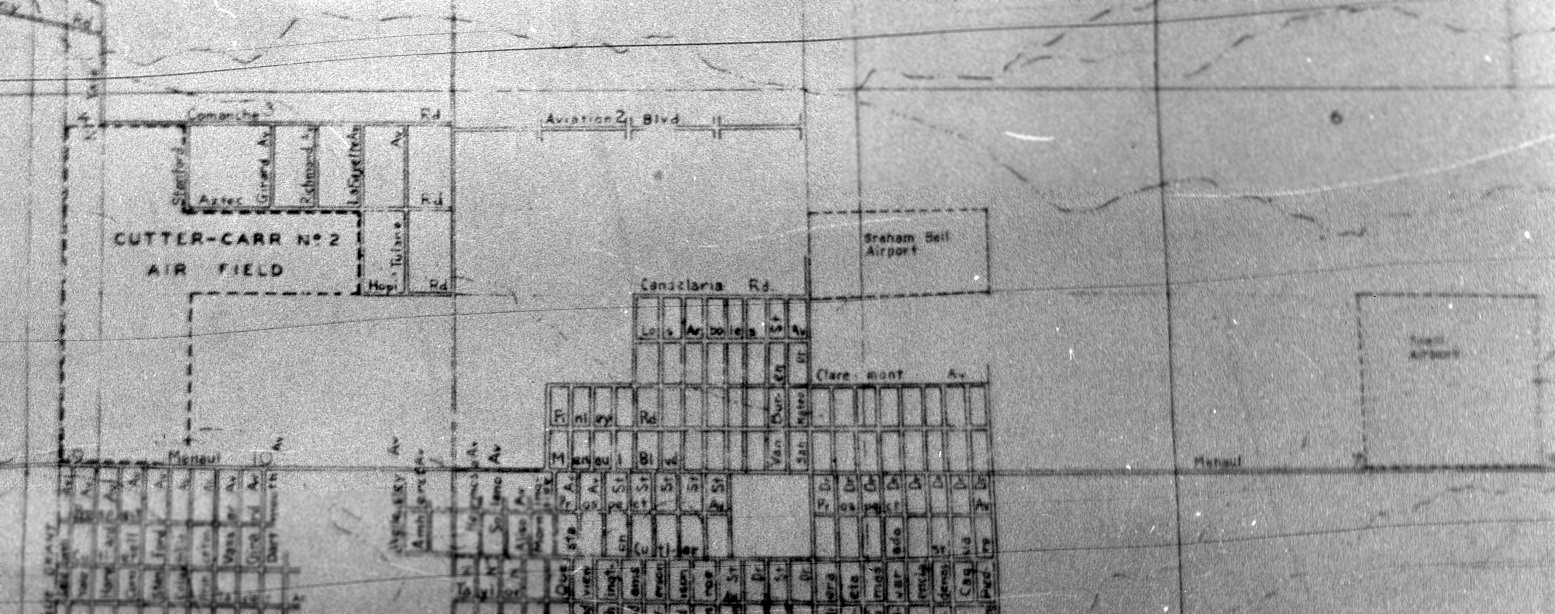
A 1946 City of Albuquerque map (courtesy of Matt Franklin) depicted Graham-Bell Airport as a rectangular property outline,
along with the nearby “Cutter-Carr #2 Air Field” to the west & another airport to the east.
Matt Franklin observed, “Notice Comanche Street was labeled as Aviation Boulevard at this time.”
According to Matt Franklin, “The University of NM Aeronautical Association operated out of Graham Bell in 1947.”

A 1940s photo of Civil Air Patrol members in front of a plane at Graham-Bell Airport (courtesy of Matt Franklin).
According to Matt Franklin, “Lewis Graham served as the local commander for the Civil Air Patrol squadron (the 1st in NM I believe) based at the airport until 1947.
During this time the airport hosted a variety of CAP-related functions, including air shows, a landing competition, and the more standard search & rescue charter.
Other standard aviation activities, such as glider towing, occurred at the airport, and Graham Bell Aviation Service was a distributor for Bellanca & Piper.”
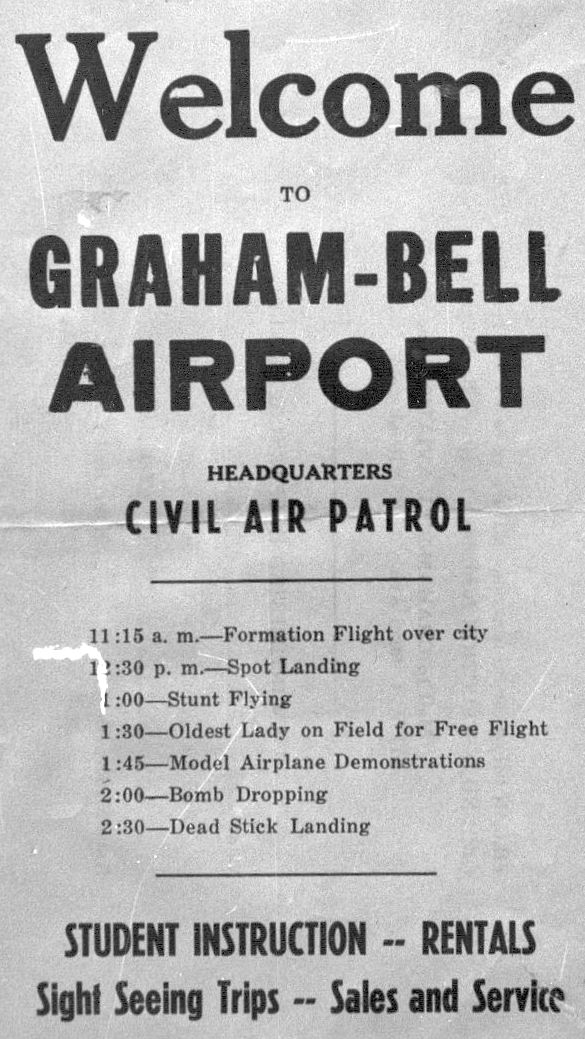
A 1940s advertisement for an exhibition Graham-Bell Airport (courtesy of Matt Franklin).

A 1940s photo of Lewis Graham (on left) & other Civil Air Patrol members in front of a plane & hangar at Graham-Bell Airport (courtesy of Matt Franklin).
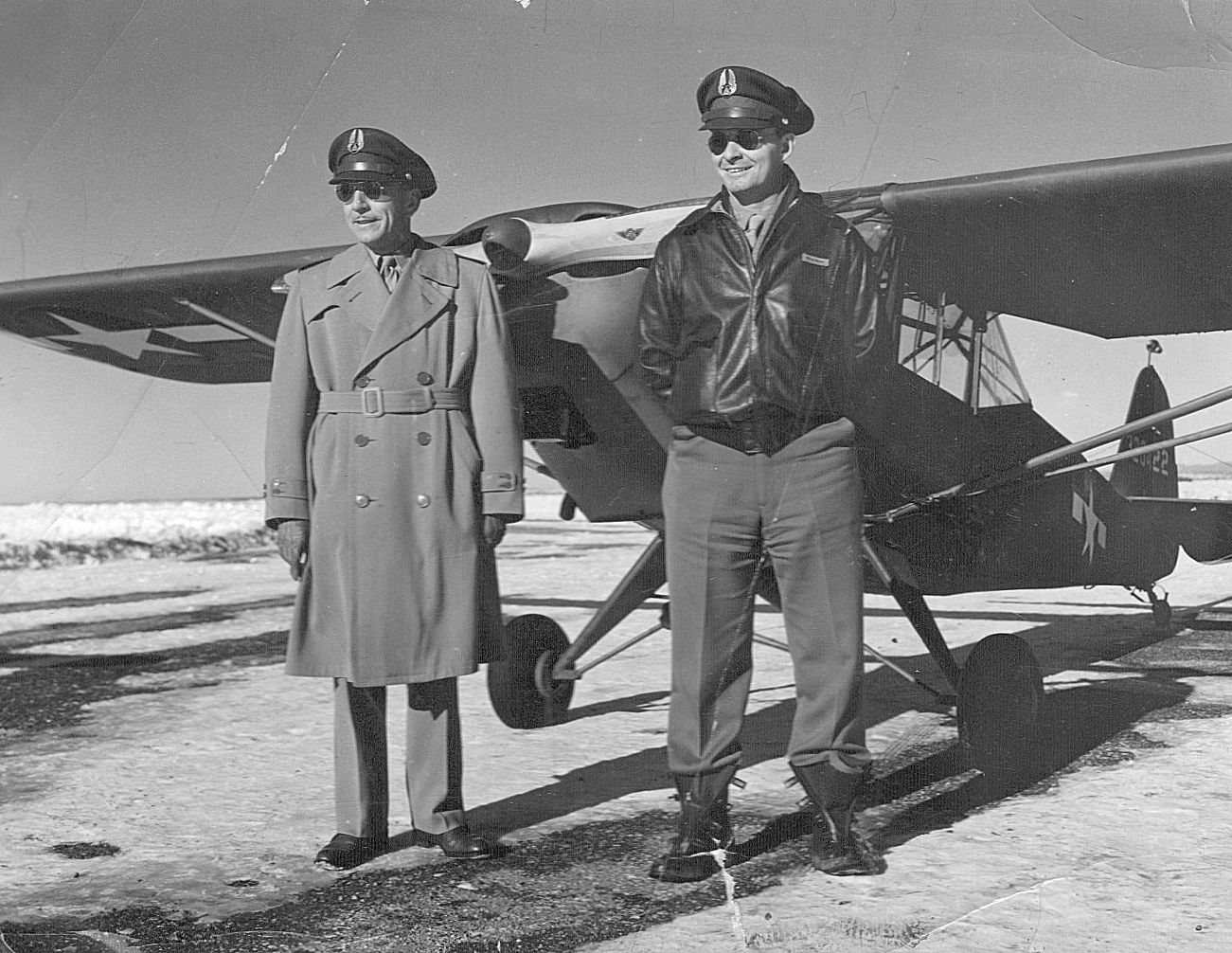
A 1940s photo of Lewis Graham (on left) & another Civil Air Patrol member in front of a plane at Graham-Bell Airport (courtesy of Matt Franklin).
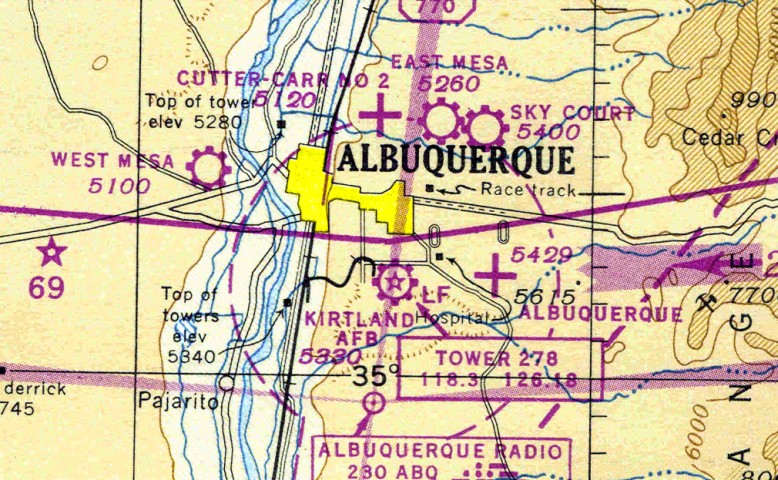
The airport was evidently renamed East Mesa Airpark at some point between 1946-48,
as that is how it was depicted on the September 1948 Albuquerque Sectional Chart (courtesy of Matt Franklin).
According to Matt Franklin, “Lewis & Jack appear to have sold their share in the airport circa 1949, perhaps as a factor that Lewis went through a divorce in 1950.
Per research by Paul Murphy, the airport operation was transferred to Al Fielder (also the chief mechanic for Graham Bell Aviation Service) who operated it starting in 1949.”
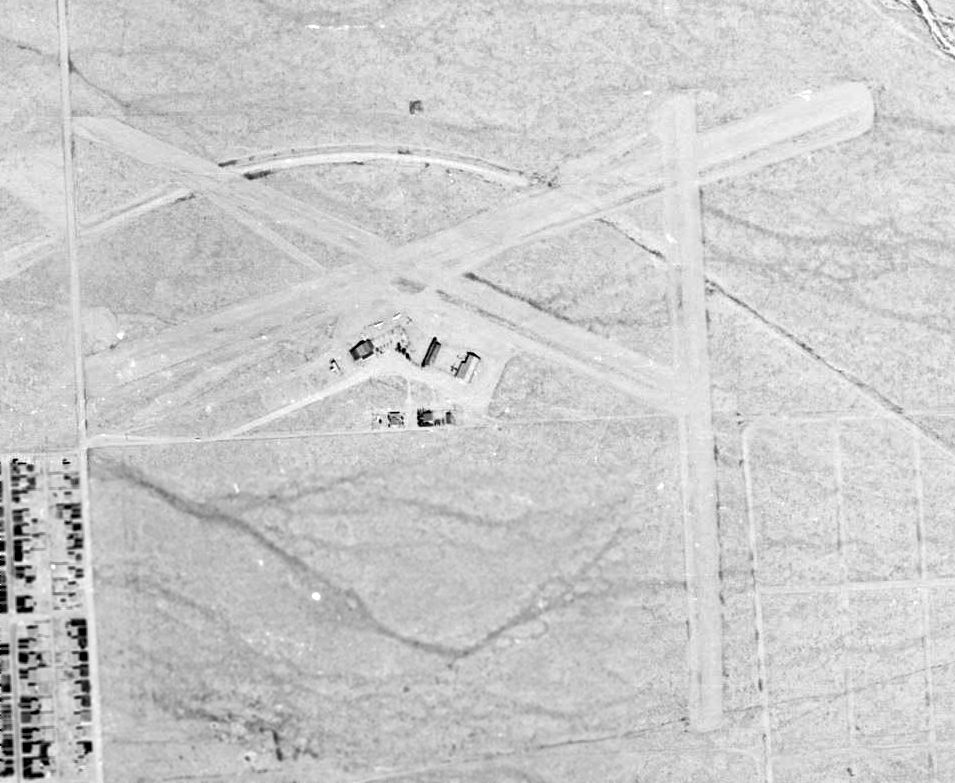
A 1951 aerial view (courtesy of Matt Franklin) depicted East Mesa Airpark as having 3 unpaved runways,
with 3 hangars & 4 or 5 light single-engine planes on the south side.
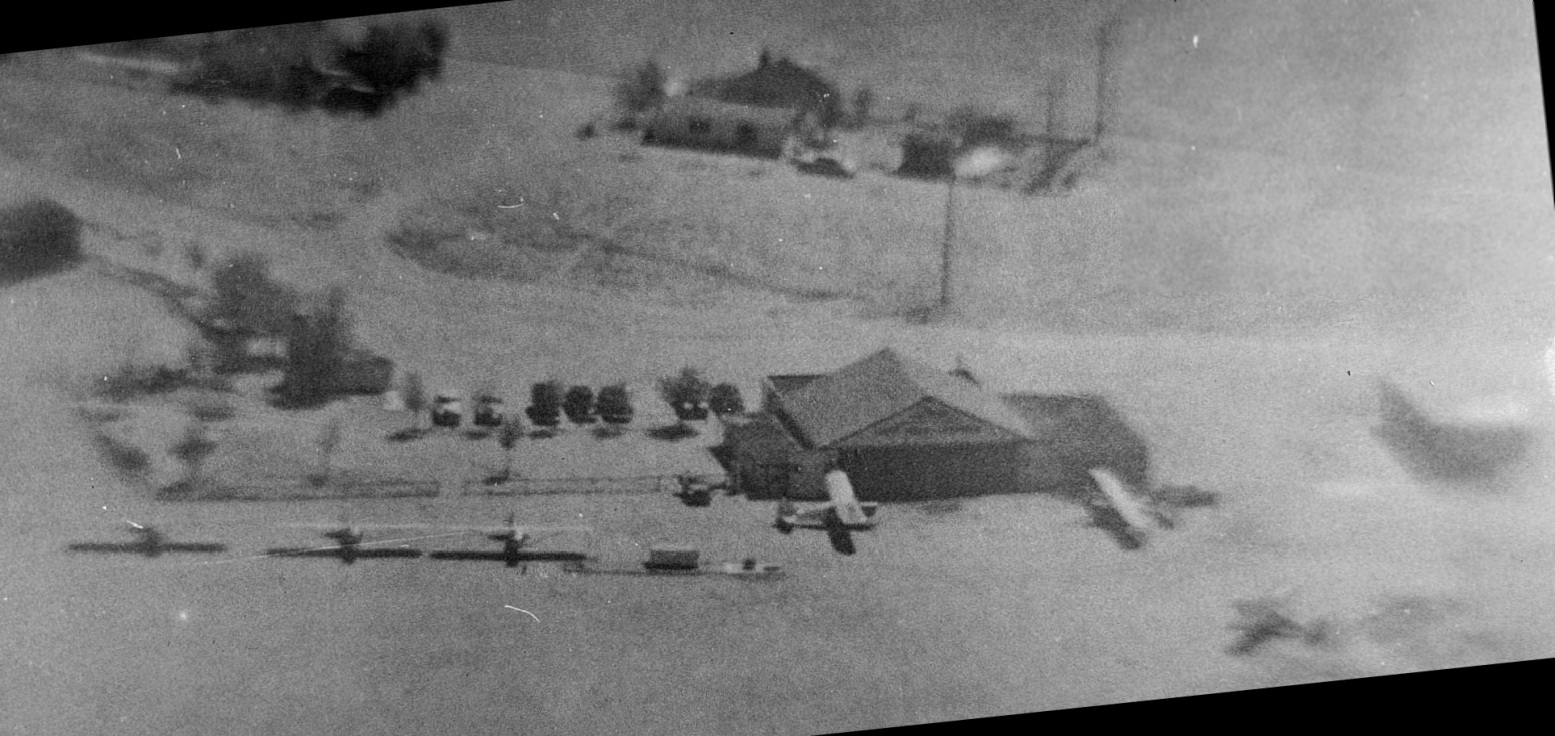
A 1951 aerial view looking south (courtesy of Matt Franklin) depicted East Mesa Airpark as having 6 light single-engine planes parked near a hangar.

A 1951 aerial view looking southeast (courtesy of Matt Franklin) depicted East Mesa Airpark as having 3 unpaved runways,
with 3 hangars & 8 light single-engine planes on the south side.
According to Matt Franklin, “Per research by Paul Murphy, the airport was operated by Al Fielder until 1952, at which point he opened his own airfield on the West Mesa called El Rancho Airport.
Ownership then transitioned to Paul Spencer, who was the owner of NM Airmotive Company which later moved to Cutter Carr #2, before its ultimate transfer to the final operator Marvin Downer.
Per his daughter Marvanelle, Marvin was a WWII aviator.
After WW2 Marvin & his family returned to Albuquerque where we worked in aviation-related pursuits until he purchased the airport in 1952.
When Marvin purchased the airport, it was still comparatively isolated, and his house (the property on the left, south of the hangar)
and his mechanic Charlie Stewart’s house (the property on the right) were the only two homes on the street.
However, the writing was likely on the wall in 1952 as Albuquerque voraciously expanded to the northeast.
Developer R.B. Waggoman had already purchased the plot of land to the north of the airport, effectively bounding it in.”
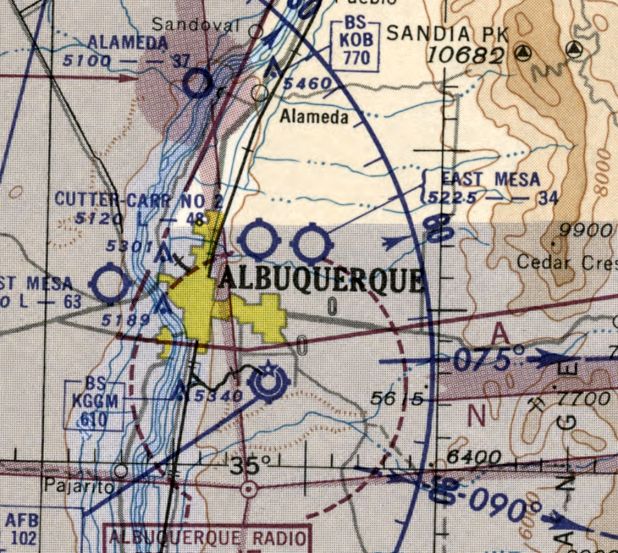
The last aeronautical chart depiction which has been located of East Mesa Airport was on the March 1952 Albuquerque Sectional Chart (courtesy of Matt Franklin).
It depicted East Mesa Airport as having a 3,400' unpaved runway.
According to Matt Franklin, “Also contributing to the demise of Graham Bell Aviation Services was a 1952 lawsuit in which an aircraft broke loose from its tie-downs & was destroyed.
The judgment found in favor of the plaintiff. I believe this was the final straw, as the airport disappears from sectional charts in late 1952.
Marvin sold to housing developer Elmer Sproul (who built a lot of Albuquerque), who also had an airplane.
Mr. Sproul kept his airplane at the airport even after he had bought it with the intention of turning into housing.”

A 1954 aerial view (courtesy of Matt Franklin) of the site of East Mesa Airport.
Matt Franklin observed, “The western portion of the field had been built over with new development.
Interestingly, the largest hangar (that has a northwest facing door) was still standing”, [center of photo].
According to Matt Franklin, “Marvin Downer continued to live in the house next to the airport until 1956.”

A 2017 aerial view showed the site of East Mesa Airport to be densely redeveloped.
However, Matt Franklin reported in 2017, “Marvin’s original house & his mechanic's are still there, flanking either side of Cuervo Drive off of Candelaria.
I can’t guarantee it, but I believe that the original basketball court in Kiva Park was built over the foundation of the original hangar.
I’m sure it has been repaved since the 1950s, but the court matches the orientation, size & position of the hangar,
so maybe there is a little bit of aviation history buried under the basketball hoops.”
The site of East Mesa Airport is located northeast of the intersection of Candelaria Road Northeast & San Mateo Boulevard Northeast.
Thanks to Matt Franklin for pointing out this airfield.
______________________________________________________
Sky Court Airport / Snell Airport, Albuquerque, NM
35.117, -106.56 (Northeast of Downtown Albuquerque, NM)

Sky Court Airport, as depicted on the September 1946 Albuquerque Sectional Chart (courtesy of Matt Franklin).
Sky Court Airport was evidently established in 1946, as it was not yet depicted at this location on the February 1946 Albuquerque Sectional Chart.
The earliest reference which has been located of Sky Court Airport was a 5/26/46 newspaper classified entry (courtesy of Matt Franklin):
“Fly Sky Court Airport, get pilot training, new Taylorcraft for sale at field.”
The earliest depiction which has been located of Sky Court Airport was on the September 1946 Albuquerque Sectional Chart (courtesy of Matt Franklin).
It depicted Sky Court as a commercial/municipal airport.
Note that this chart depicted Sky Court as one of 3 airports which briefly coexisted in very close proximity on the north side of Albuquerque:
the others being Cutter-Carr #2 Airport & Graham Bell Airport.
Matt Franklin observed, “I think there was a broad optimism following the war, when the government was pretty much paying for everyone's flight training,
and there were tens of thousands of aircraft returning from the war that proved factories were capable of mass production of aircraft.
Airplanes were affordable because the product liability hadn't matured.”
From a New Mexico Soaring newsletter (courtesy of Matt Franklin):
“A third airport was located just another mile & a half east, called the Sky Court, and was owned & operated by Harold Snell.
The location was between Menaul & Montgomery & Wyoming & Eubank.
One wonders how so many fields could operate successfully. Each must have had their own specialty.
The University Flying Club, of which Santilli had become a member, flew their PA-12 Super Cruiser from Sky Court, so Al chose this field from which to operate his sailplane."
An 8/3/46 newspaper classified entry (courtesy of Matt Franklin):
“1946 Taylorcrafts Demonstrators $2,300. Up Airplane Financing New or Used Harold Snell Sky Court Airport north of Fair Ground on Louisiana Avenue.”
An 8/26/46 newspaper classified entry (courtesy of Matt Franklin): "Deputy Dick Morrison investigated the theft of an estimated $250 worth of airplane tools
from the Sky Court Airport two & a half miles north of town. The burglar entered by removing a window. Owner-Manager Harold Snell reported the loss."
A 6/18/47 newspaper classified entry (courtesy of Matt Franklin): "For Sale or trade. 1940 J 3 Cub. $995; 1946 Taylorcraft. $1,895.
Completely reconditioned, like new. Terms. Sky Court Airport. North Louisiana."

The earliest photo which has been located of Sky Court Airport was a circa 1946-51 aerial view by Bill Laskar (courtesy of Matt Franklin)
which depicted the field as having several unpaved runways, and 6 light single-engine aircraft parked near a small hangar & another smaller building.
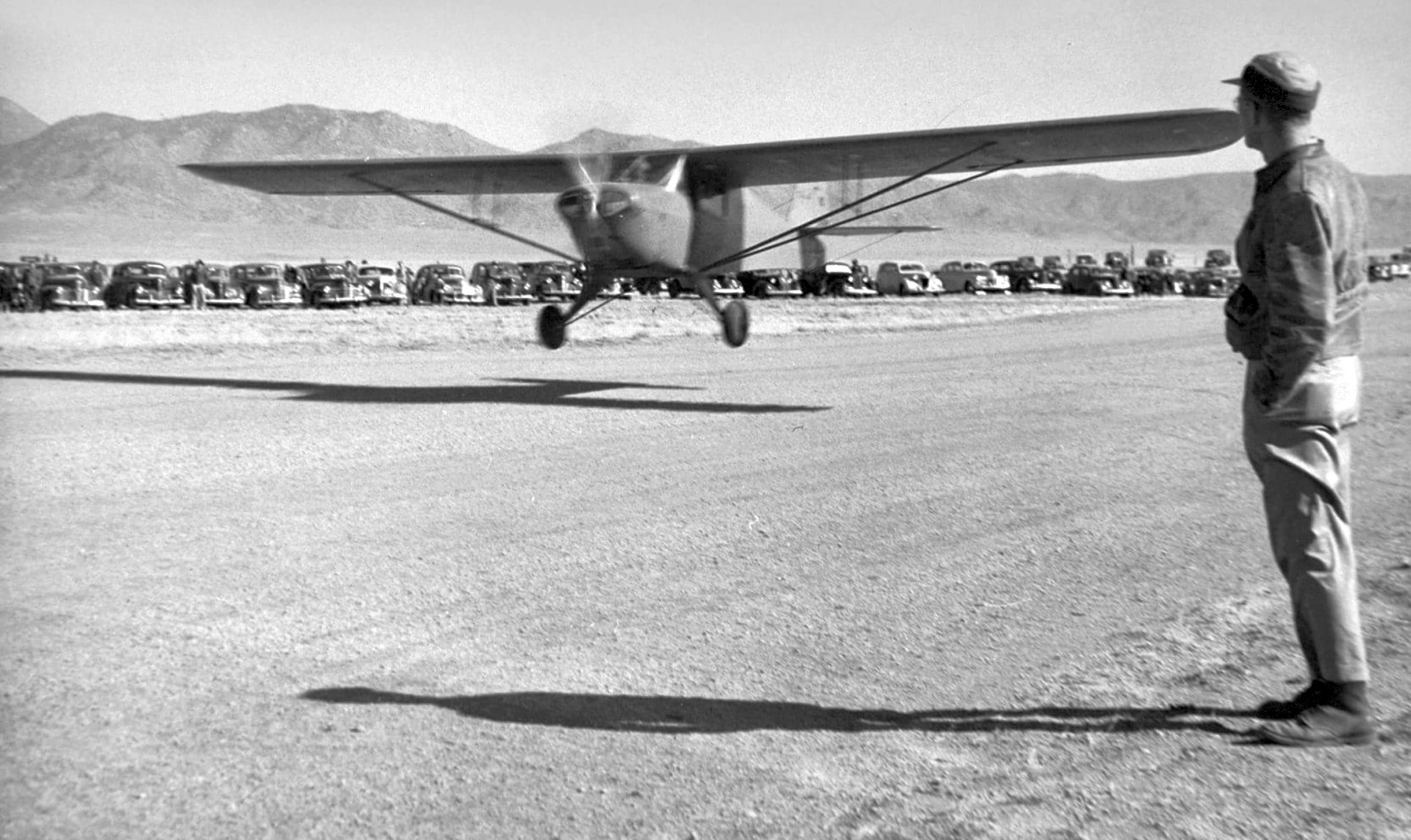
A circa 1946-51 photo (courtesy of Matt Franklin) showing a Taylorcraft (model unidentified) taking off or landing at Sky Court Airport, with a large number of cars parked in the background.

The last aeronautical chart depiction which has been located of Sky Court Airport
was on the September 1948 Albuquerque Sectional Chart (courtesy of Matt Franklin).
Sky Court Airport was evidently closed at some point between 1948-50,
as it was no longer depicted on the March 1950 Albuquerque Sectional Chart.
It thus lasted less than 4 years.
Perhaps an extreme example of the boom & bust of American general aviation airports right after WW2,
with a perceived need for more small airports, many of which were then rapidly overtaken by suburban housing.

A 1951 aerial view looking northeast (courtesy of Matt Franklin) depicted the remains of the Sky Court Airport runways after the property had already been gridded for city streets.

A 1951 aerial view of Sky Court Airport (courtesy of Matt Franklin) showed the remains of the runways after the property had already been gridded for city streets.
It showed Sky Court Airport to have had 3 runways in a hexagonal pattern, with the longest being 3,000'.
A perimeter road or taxiway connected the ends of each runway. There was a small ramp on the west end & 2 small buildings (hangars?).

A 1951 aerial view annotated by Matt Franklin to show the close proximity of the 3 airports which briefly coexisted on the north side of Albuquerque:
Cutter-Carr Airport, Graham Bell Airport, and Sky Court Airport.
A 1954 aerial view (courtesy of Matt Franklin) showed development had started on the Sky Court Airport property.
By the 1960s, all traces of Sky Court Airport had been erased.
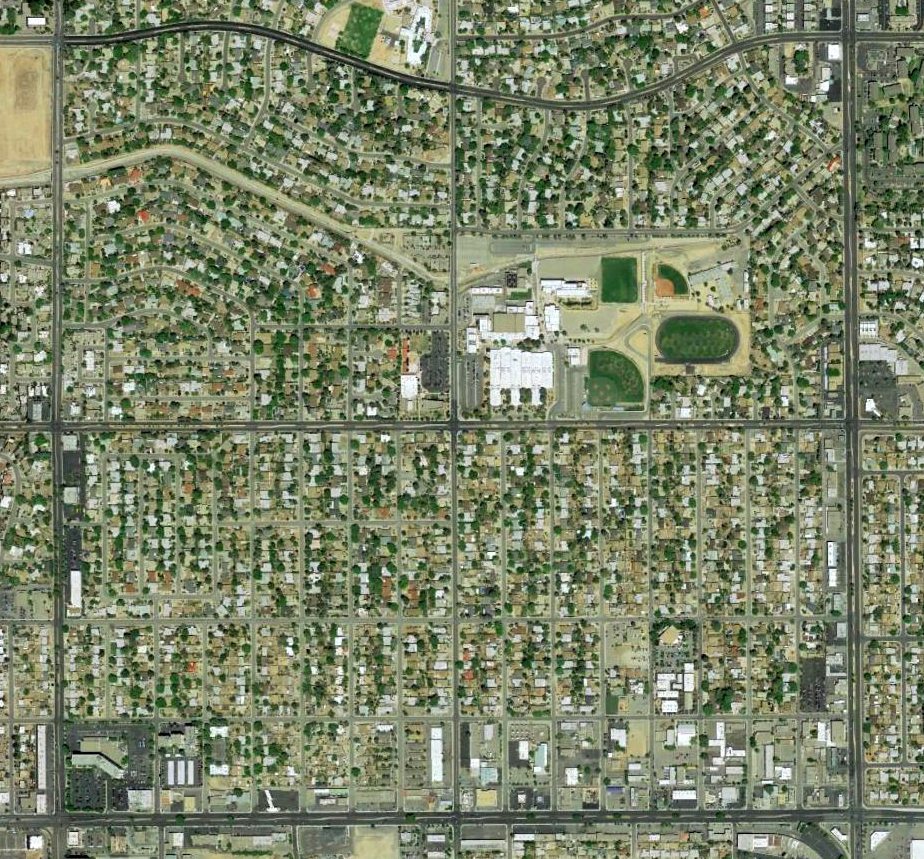
A 2017 aerial view (courtesy of Matt Franklin) showed no trace remaining of Sky Court Airport.
The site of Cutter-Carr Airport is located west of the intersection of Wyoming Boulevard Northeast & Candelaria Road Northeast.
Thanks to Matt Franklin for pointing out this airfield.
______________________________________________________
Cutter-Carr Airport / Cutter-Carr Airport #2 / Del Norte Airport, Albuquerque, NM
35.118, -106.618 (Northwest of Downtown Albuquerque, NM)
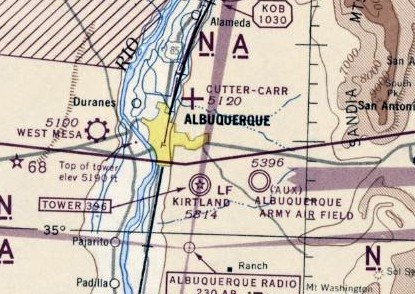
Cutter-Carr Airport, as depicted on the February 1944 Albuquerque Sectional Chart (courtesy of Matt Franklin).
No airport was yet depicted at this location on the 1938 USGS topo map.
According to Matt Franklin, “Post WWII, Albuquerque was awash with airports.
In addition to West Mesa & Alameda Airport which have since been eaten up by development, there were actually 3 other airports that fell victim to urban sprawl earlier in the 1950s.
One of these was Cutter Carr #2, also referred to as Del Norte Airport.”
As reported in the Southwest Soaring Museum newsletter (courtesy of Matt Franklin),
“It seems that Cutter/Carr needed a second airport to support their operations
and had opened a flying field in the area of land just north of where American Furniture is located on the corner of Menaul & Carlisle.”
According to Matt Franklin, “It seems Cutter-Carr had an Fixed-Base Operation at Albuquerque Municipal Airport (Sunport), at West Mesa Airport, and additionally at Cutter-Carr Airport #2.
The name was derived from William Cutter & Clark Carr.”
Cutter-Carr Airport was not yet depicted on the February 1943 Albuquerque Sectional Chart (according to Matt Franklin).
The earliest dated reference which has been located of Cutter-Carr Airport
was a March 1943 ABQ Journal article (according to Matt Franklin) which noted 5 aircraft were flipped over in a storm.
The earliest depiction which has been located of Cutter-Carr Airport
was on the February 1944 Albuquerque Sectional Chart (courtesy of Matt Franklin).
It depicted Cutter-Carr as an auxiliary airfield.
“Cutter-Carr #2” was depicted as an auxiliary airfield on the February 1946 Albuquerque Sectional Chart (courtesy of Matt Franklin).

A 1946 City of Albuquerque map (courtesy of Matt Franklin) depicted “Cutter-Carr #2 Air Field”, along with the nearby Graham-Bell Airport & another airport to the east.
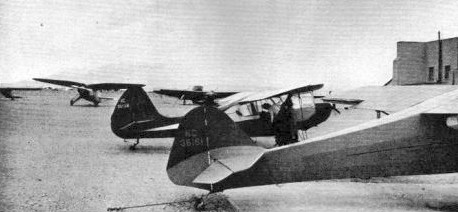
The earliest photo which has been located of Cutter-Carr Airport was an undated photo from an August 1948 article
about about a delivery flight of an Aeronca to the airport (courtesy of Matt Franklin).
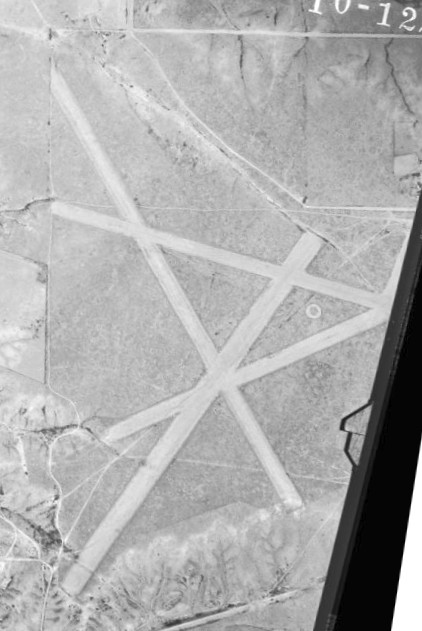
The earliest aerial photo which has been located of Cutter-Carr Airport was an October 1949 aerial view (courtesy of Matt Franklin),
which showed the airport having 4 unpaved runways.

The last photo which has been located showing Cutter-Carr Airport while open was a 1951 aerial view (courtesy of Matt Franklin)
which showed approximately 15 light parked on the field.
It continued to be depicted as “Cutter-Carr #2” on Albuquerque Sectional Charts through March 1952 (according to Matt Franklin).
Cutter-Carr Airport was evidently renamed Del Norte Airport in 1952,
as that is how it was depicted on the August 1952 Albuquerque Sectional Chart (according to Matt Franklin).
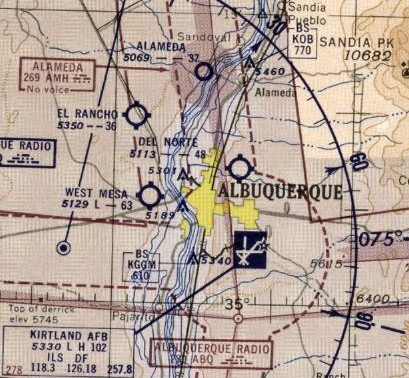
The last aeronautical chart depiction which has been located of Del Norte Airport
was on the February 1954 Albuquerque Sectional Chart (courtesy of Matt Franklin).
It depicted Del Norte Airport as having a 4,800' unpaved runway.
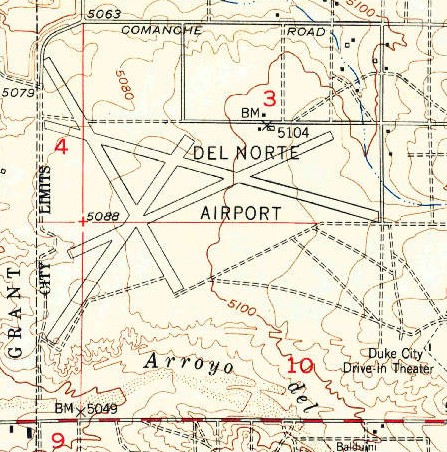
The only topo map depiction which has been located of Del Norte Airport was on the 1954 USGS topo map (courtesy of Matt Franklin).
It depicted Del Norte Airport as having 4 runways & 2 small buildings on the north side.
Del Norte Airport was evidently closed in 1954,
as it was no longer depicted on the September 1954 Albuquerque Sectional Chart (according to Matt Franklin) or subsequent Sectionals.
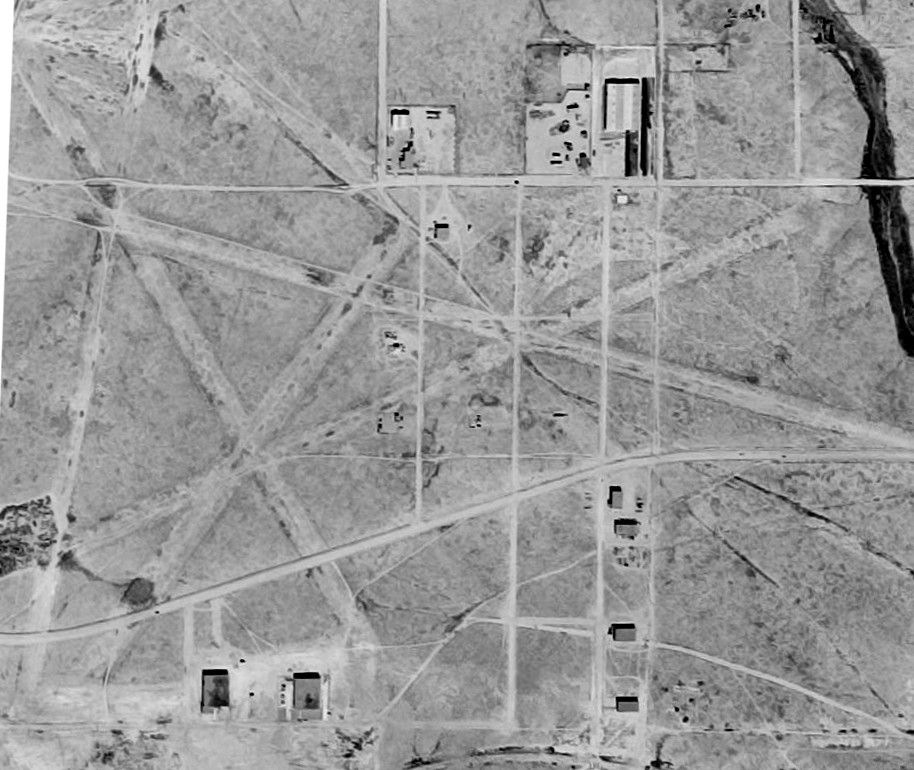
A 1959 aerial view (courtesy of Matt Franklin) showed the Cutter-Carr Airport runways were still recognizable, but the property had begun to be built over.
A 1967 aerial view (courtesy of Matt Franklin) of the Cutter-Carr Airport site showed a runway intersection was still recognizable.
A 1972 aerial view (according to Matt Franklin) of the Cutter-Carr Airport site showed a faint trace of the runway intersection, along with the concrete foundation of the hangar.
A 1991 aerial view (according to Matt Franklin) showed the Cutter-Carr Airport site had been completely built over.
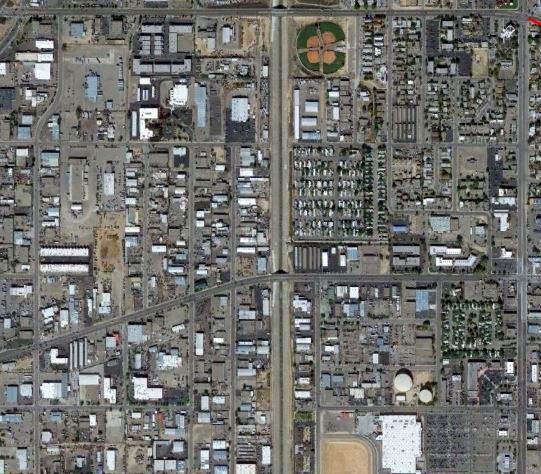
A 2016 aerial view (courtesy of Matt Franklin) showed no trace remaining of Cutter-Carr Airport.
The site of Cutter-Carr Airport is located south of the intersection of Aztec Road & Girard Boulevard.
Thanks to Matt Franklin for pointing out this airfield.
______________________________________________________
Santa Rosa Peak Airfield, Santa Rosa Peak, NM
35.36, -107.24 (Northwest of Albuquerque, NM)

A 1997 USGS aerial view looking northwest at the airfield at Santa Rosa Peak.
Not much is known about this airfield in an extremely unpopulated spot 30 NM northwest of Albuquerque, including its name, date of construction, or purpose.
No airfield at this location was depicted on USGS topo maps from 1958-83.
The earliest depiction which has been located of this airfield was a 1997 USGS aerial view, which depicted a 4,300' unpaved north/south runway.
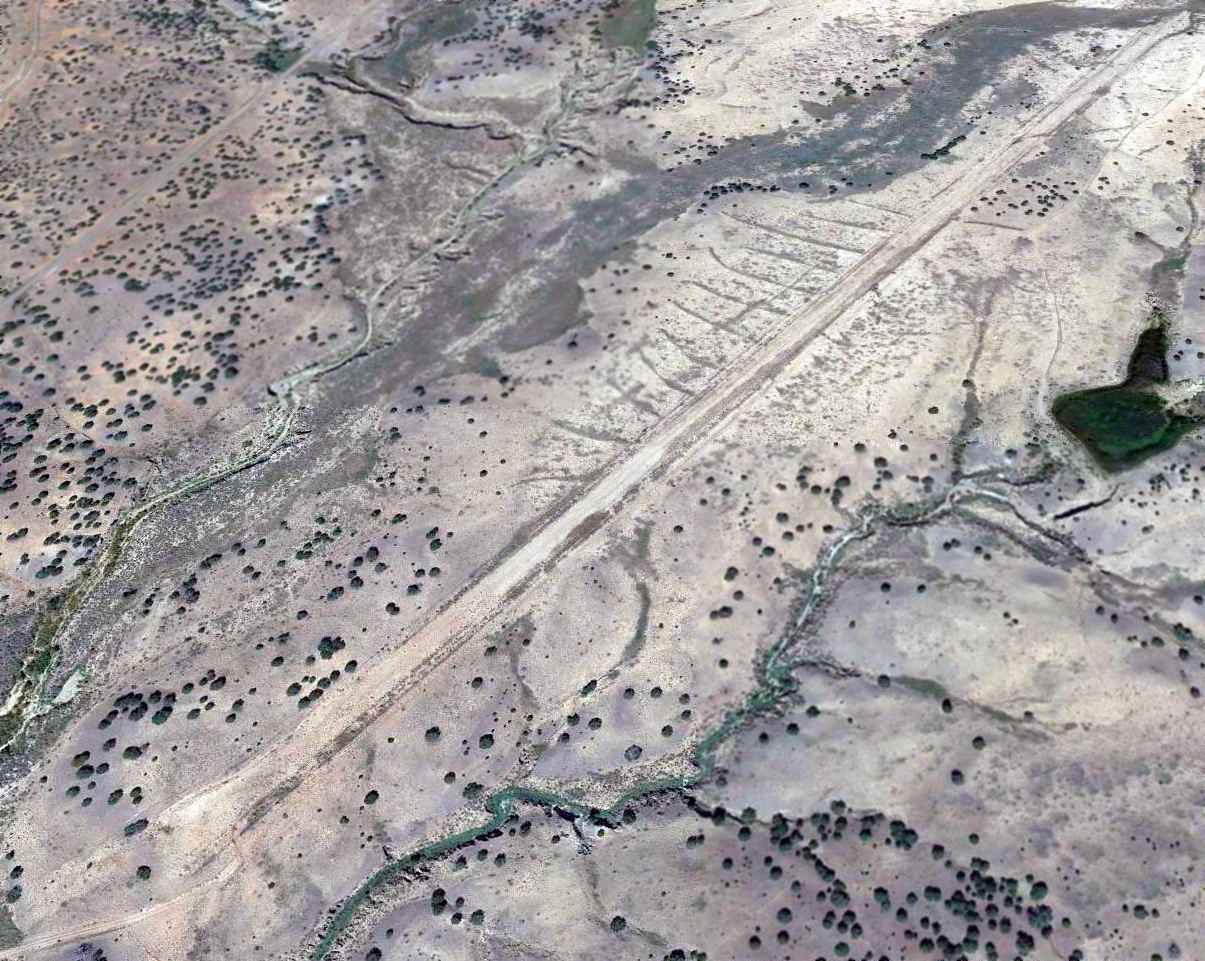
A 2014 aerial view looking northwest depicted the Santa Rosa Peak runway.
Gwen Walcott reported in 2015, “From 1,000' above ground level it is an obvious runway.”
Thanks to Gwen Walcott for pointing out this airfield.
______________________________________________________
Valencia Community Air Ranch, Los Lunas, NM
34.78, -106.65 (South of Albuquerque, NM)

A 9/20/75 photo by Larry Nussbaumer of gliders, balloons, and taildraggers from Coronado Airport's Pegasus Aerial Sports at an open house/airshow at Valencia.
Valencia Community Air Ranch was not yet depicted on the 1973 USGS topo map.
According to a 2009 zoning hearing, “the original plat” for this airport property “was done in 1973.
It was originally planned to be an airpark, and that it is why the roads were wider to accommodate airplanes.”
Matt Franklin visited Valencia Community Air Ranch & reported,
“I met a fantastic gentleman by the name of Larry who shed some light on the history of the airfield.
The airfield was intended to be the centerpiece in an on-airport housing project.
The land owner sold the property to a developer, which in turn defaulted & the ownership returned to the original owner.
Unwilling to pursue the development of the land himself, he turned the airfield over to the Valencia County government
with the provision that the airfield be maintained for aeronautical use, which the county government did not do.”
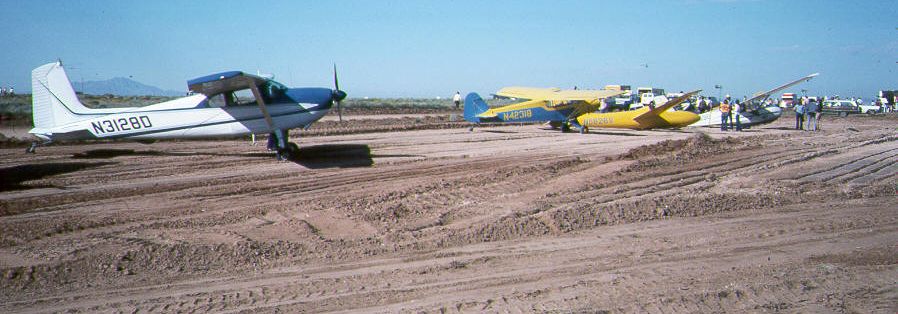
A 9/20/75 photo by Larry Nussbaumer of “The Pegasus Cessna 180 towplane (28D), PA-11, Schweitzer 2-32 & 2-33 sailplanes
on the edge of the [Valencia] runway - note all the loose dirt, since they'd just plowed the runway & parking areas.
These pictures were taken at the air show.
I was the tow pilot (as well as tailwheel instructor) for Pegasus Aerial Sports.”
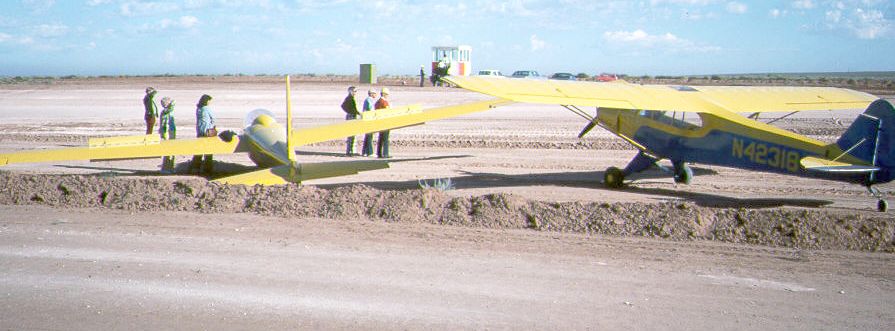
A 9/20/75 photo by Larry Nussbaumer of “The Pegasus Schweitzer 2-32 sailplane & PA-11 Cub next to the [Valencia] runway.
Note the temporary tower (for the air boss) across the runway.”
Valencia Community Air Ranch was not yet depicted on the October 1975 Albuquerque Sectional Chart.
The 1978 USGS topo map depicted Valencia Community Air Ranch as having a single unlabeled east/west 6,000' runway.
Barry Sylvester recalled, “I was a member of the Icarus Sport Parachute Club in Albuquerque from 1978-82.
Our aircraft were based at Coronado (2 Cessna 180s & a 206) & we would ferry the airplanes down to the Valencia Airpark on Sunday mornings for a day of skydiving.
You can still see the remains of our packing shed next to Hombre Lane (rectangle) & the pea gravel pit (circle).
I don't know when skydiving stopped at Valencia, but it appears that operations relocated to the airport at Belen.
There were parachuting operations on the old West Mesa Airport in the late 1960s & early 1970s,
but increasing air traffic at the municipal airport became a problem. Relocating to Valencia got us away from the traffic.”

The earliest aeronautical chart depiction which has been located of the Valencia Community Air Ranch
was on the November 1982 Albuquerque Sectional Chart (courtesy of Scott Jednacz).
It depicted Valencia as having a 7,000' unpaved runway – pretty long for an unpaved strip.

The 1991 USGS topo map depicted Valencia as having a single east/west runway, labeled simply as “Landing Strip”.
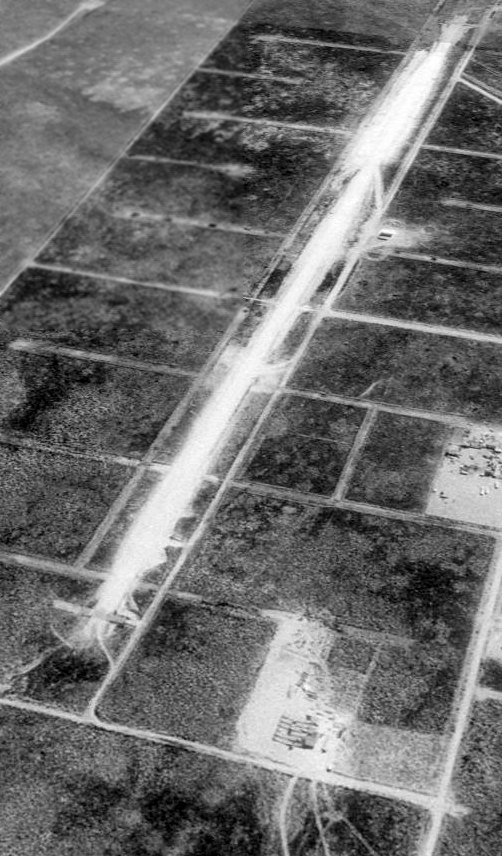
The earliest photo which has been located of the Valencia Community Air Ranch was a 5/4/91 USGS aerial view looking northeast,
which showed a single unpaved east/west runway.
The hangar on the southwest side (in the foreground) appeared to be possibly still under construction.
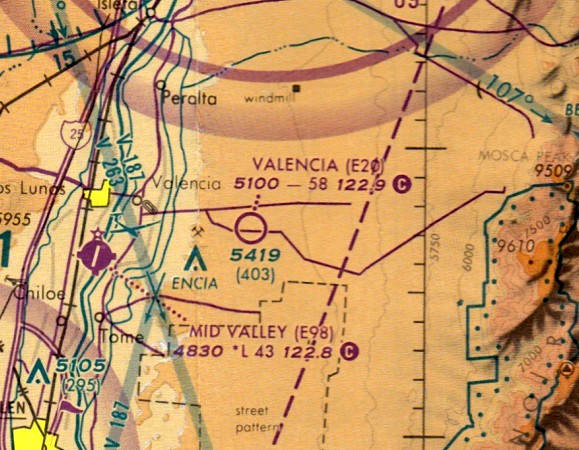
The last aeronautical chart depiction which has been located of the Valencia Community Air Ranch was on the May 1993 Albuquerque Sectional Chart (courtesy of Ron Plante).
The depicted runway length had shrunken somewhat to 5,800' compared to the 1982 Sectional depiction.
A 1/12/03 aerial photo showed an amazing sight at the southwest corner of Valencia Community Air Ranch:
dozens of light plane fuselages were stored around a small hangar (which had a hole in its roof),
and an intact Lockheed T-33 Shooting Star military jet trainer was parked next to the hangar among piles of debris.
A 2006 aerial photo showed no significant change at Valencia Community Air Ranch.
A 1/21/09 aerial photo showed that a short 1,700' dirt east/west runway had been added just to the northwest of the Valencia Community Air Ranch hangar,
paralleling the original runway.
The 1/21/09 photo showed a radio-controlled model aircraft on this smaller runway.
The 2009 Albuquerque Sectional Chart no longer depicted any airfield at this location.

A February 2012 photo looking northeast at the former Valencia Community Air Ranch runway.
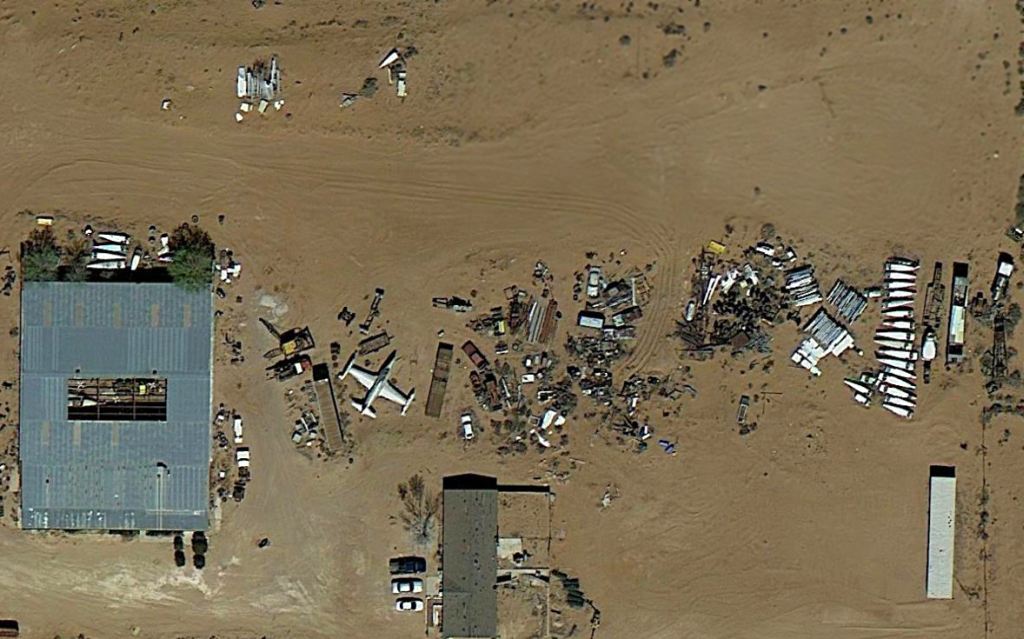
A 3/21/12 aerial photo showed an amazing sight at the southwest corner of Valencia Community Air Ranch:
dozens of light plane fuselages were stored around a small hangar, with at least one other fuselage inside the hangar visible through a hole in its roof,
and an intact Lockheed T-33 Shooting Star military jet trainer was parked next to the hangar among piles of debris.

An 11/30/14 photo by Matt Franklin looking east from the end of the Valencia Community Air Ranch runway.
Matt reported, “The length of the runway is clearly elevated from the surrounding terrain,
but runs at around 20' above the surrounding area in some places & 15' or so below the terrain in the middle.
Both ends had asphalted turnarounds. From the east facing end its possible to see the aircraft that are discussed [above].”
Matt also reported that other portions of the runway are used “as an illegal dumping site.
Despite the dirt being clear & hard compact, it would be impossible to land here without blending a variety of couches, box TV’s, and car tires into a puree with a prop.”
Matt also reported that “the small runway next to the hangar is [Larry's] runway that he uses for full-size aircraft, not RC airplanes, although he hasn’t used it in quite a while.”
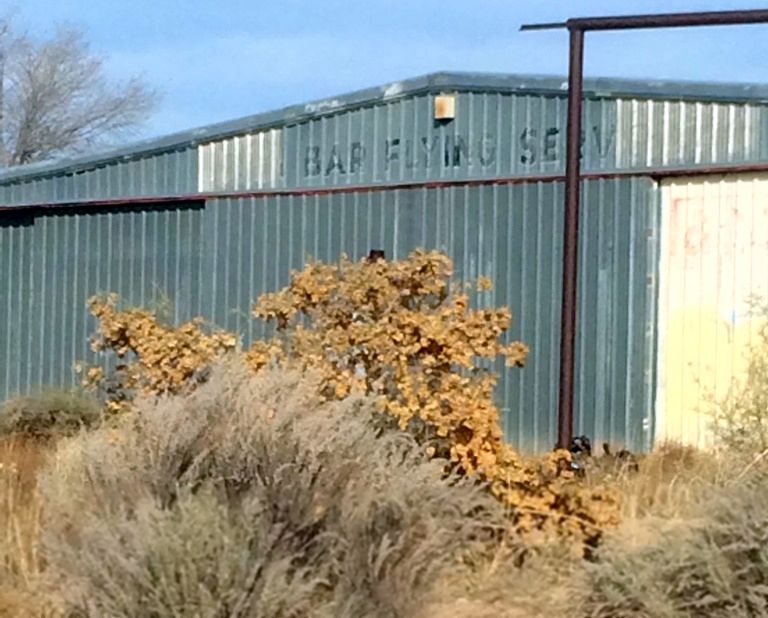
An 11/30/14 photo by Matt Franklin of the hangar at Valencia Community Air Ranch.
Matt reported, “I met a fantastic gentleman by the name of Larry who was kind enough to give me & my friend a tour of his property.
The first thing I noted about his hangar was actually the name on its side, which read Seven Bar Aviation.
I had flown out of the KABQ Seven Bar during my flight training tenure in the 2000’s before it was sold to Atlantic Aviation,
and I was familiar with their location at the Alameda Airport.
Larry confirmed he had purchased the Seven Bar hangar from the Alameda Airport & moved it adjacent to the Valencia Airpark.
Who would’ve guessed that a little piece of the legacy of Alameda would turn up 30 miles away, and still be used for storing aircraft?”
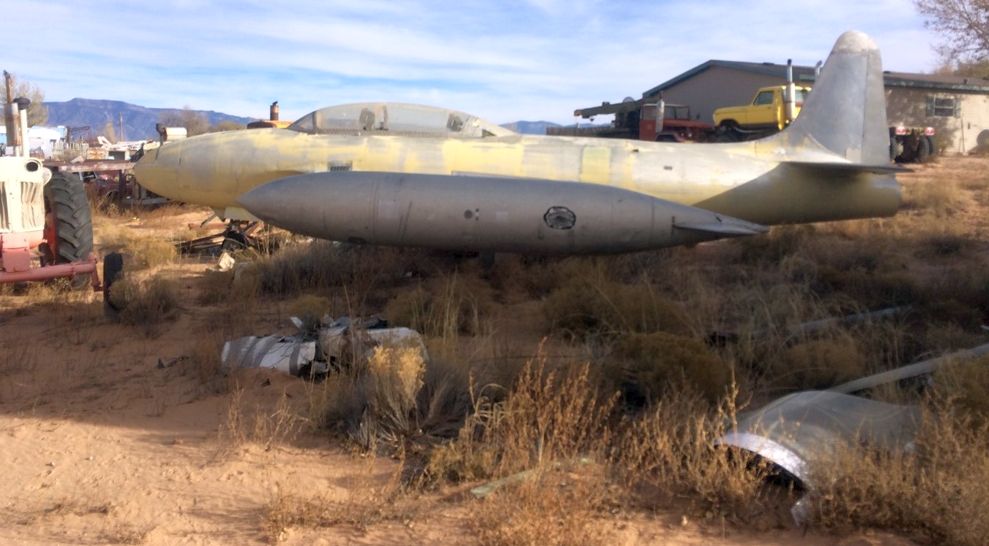
An 11/30/14 photo by Matt Franklin of the Lockheed T-33 Shooting Star military jet trainer which sits idle at Valencia Community Air Ranch.
Matt reported, “Larry owns the T-33, a plane he was anticipating to 'modify heavily', although other priorities changed his plans.
He had the original aircraft engine & a parts engine in the hangar.
He may start to sell parts as he gets older, but for now he's going to keep building airplanes.
You can see the canopy is yellowed but the desert air stops the rust, so there might be hope for this one.”

An 11/30/14 photo by Matt Franklin of the Beechcraft Bonanza fuselage inside the hangar at Valencia Community Air Ranch.
Matt reported, “We visited inside his hangar, which featured two 1947 Bonanzas, including line number 27 [pictured].
He also had the fuselages of a Piper 140 & a Piper 160, as well as a nifty Piper Six mix.
Larry told us he had built several airplanes, with a specialization in Pipers.
He would purchase aircraft that had been damaged by hail, wind, or bad piloting & swap the parts into a functional fuselage.
Typically this process would take 3 weeks, but he had rebuilt one such airplane in the space of one week.”
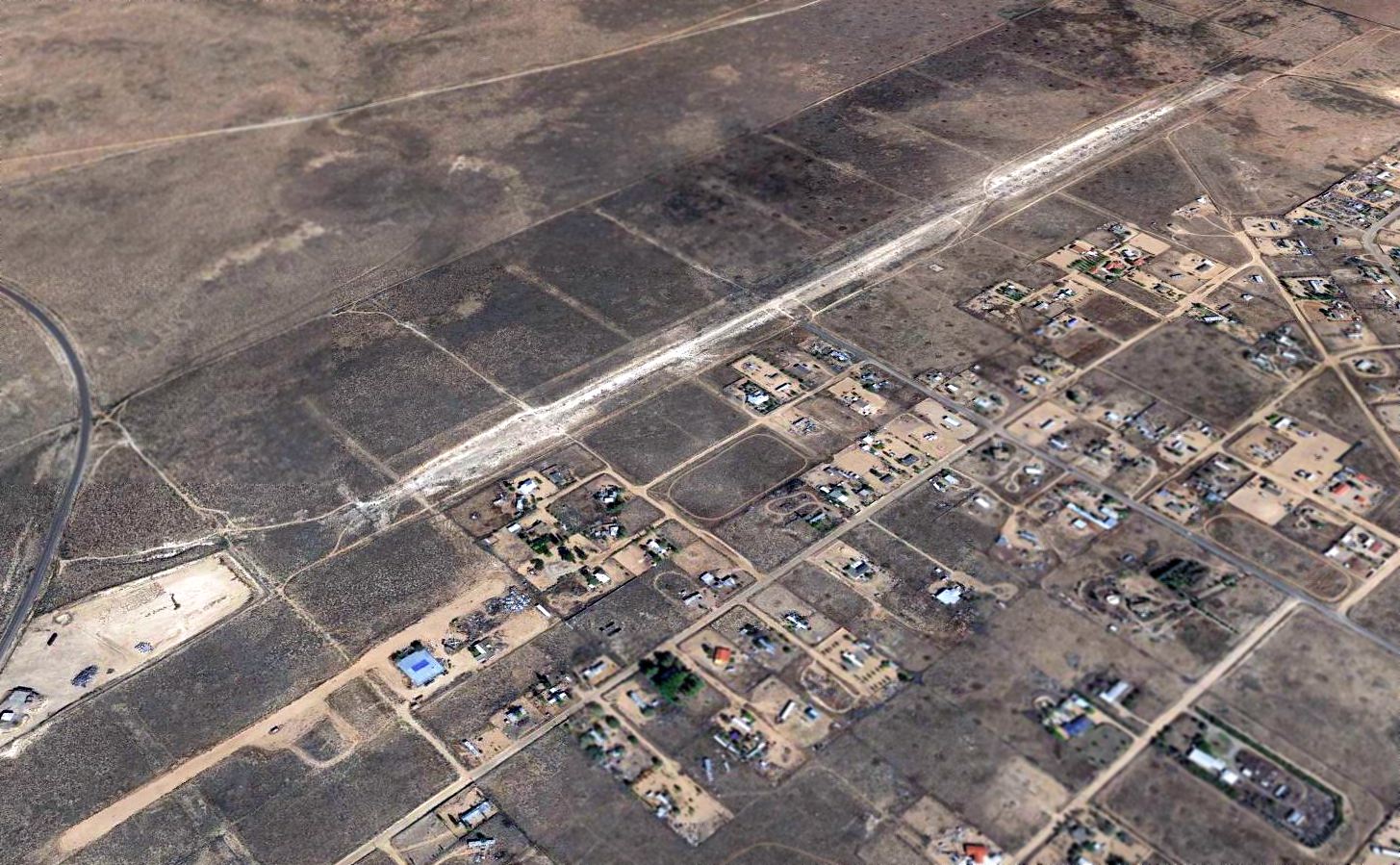
A 2015 aerial view looking northeast at the Valencia Community Air Ranch.

A 2022 photo looking northwest at the Valencia Community Air Ranch runway.
Valencia Community Air Ranch is located north of the intersection of Airport Drive & Airport Road.
______________________________________________________
Paradise Acres Airport, Albuquerque, NM
35.01, -106.71 (Southwest of Downtown Albuquerque, NM)
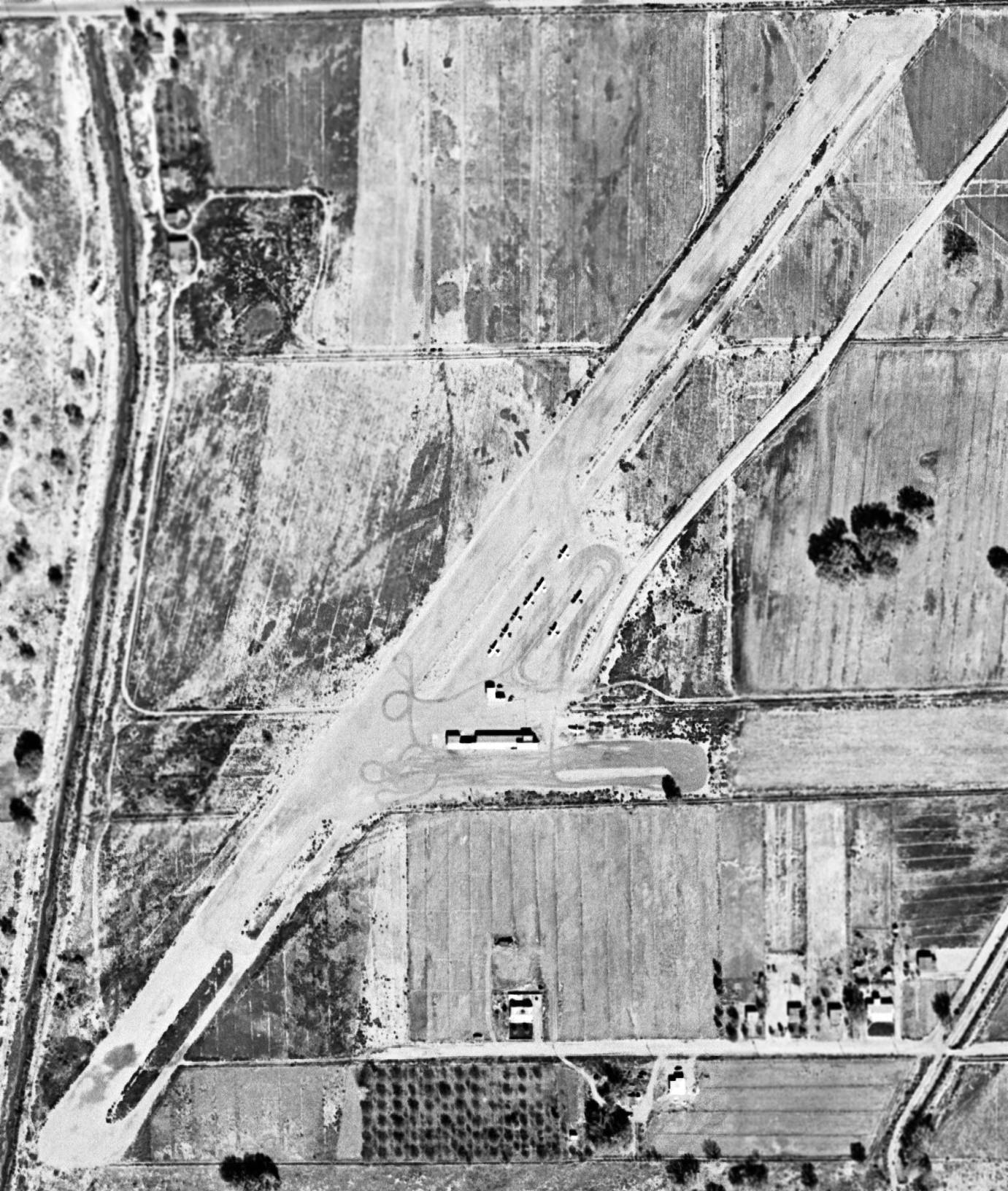
Paradise Acres Airport, as depicted on a 1959 USGS aerial view (courtesy of Matt Franklin).
Not much is known about this small, short-lived general aviation airport.
Paradise Acres Airport was evidently established at some point between 1955-59,
as it was not yet listed in the 1945 AAF Airfield Directory (courtesy of Scott Murdock),
depicted on the September 1946 Albuquerque Sectional Chart (or subsequent Sectionals through the 1960s).
nor depicted on the 1955 USGS topo map.
The only photo which has been located of Paradise Acres Airport was on a 1959 USGS aerial view courtesy of Matt Franklin).
It depicted a single northeast/southwest unpaved runway, with a ramp & 2 small buildings on the east side.
Matt Franklin observed, “I count 8 planes on the flightline & 1 in the bushes.”
George Atkinson recalled, “Paradise Acres Airport [was located] just off Coors & Gun Club Road.
It offered J-3 [Piper Cub] time for $8/hour.”
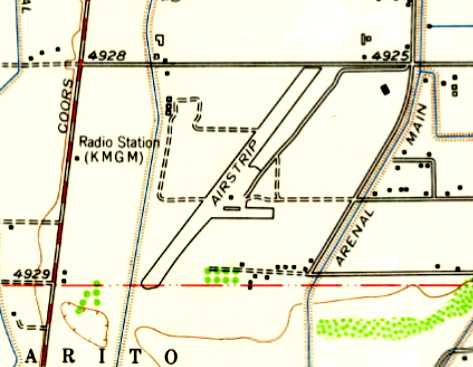
The only topo map depiction which has been located of Paradise Acres Airport was on the 1960 USGS topo map,
which depicted a single northeast/southwest runway, labeled simply as “Airstrip”,
with a ramp & one small building on the east side.
Dan McGrew recalled, “My uncle Don bought a Piper J3 that he kept at Paradise Airport.
We lived just down the road at 2113 Gun Club Road.
It was a small field but had some interesting planes.
I remember one huge storm that hit & really tore some of them up.
I remember this one pilot who had a pretty beefy J3 & in that center section of the airport,
did a figure-8 on the ground & lifted it off into the air.
Most amazing thing to this day I have seen anyone do with a plane.
I learned to fly my first plane out of this airport. I was just 8 years old & my uncle had his license now.
I remember it was a silver/cream/pink Cessna 172.”
The 1969 USGS topo map no longer depicted Paradise Acres Airport, instead depicting several roads having been built over its location.
The 1991 USGS aerial photo depicted no remaining trace of Paradise Acres Airport,
the site having been covered with housing.
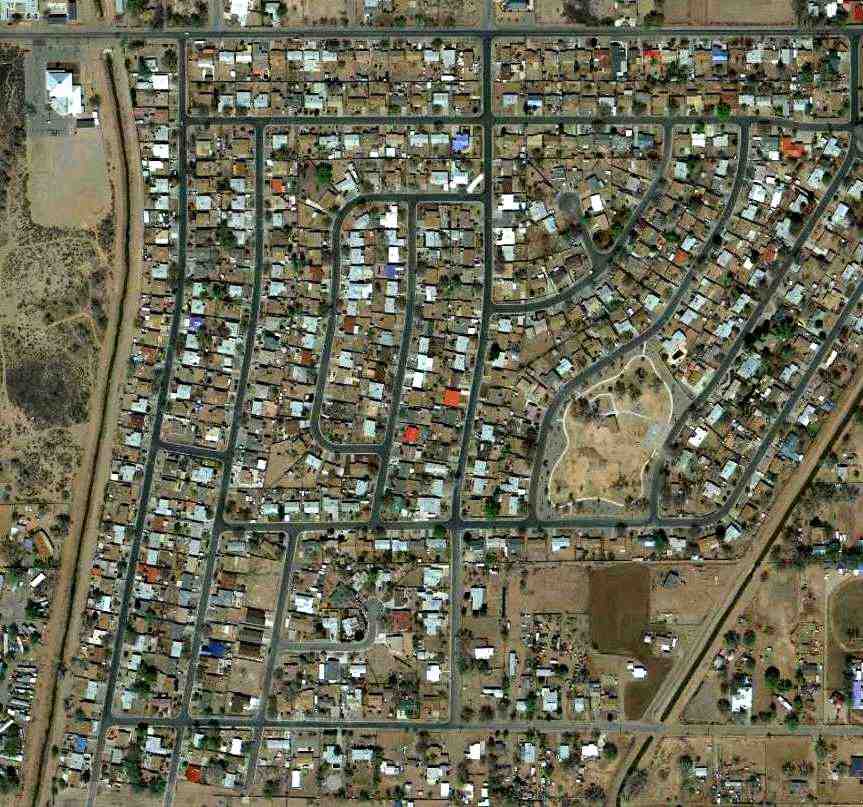
A 3/21/12 aerial photo showed no remaining trace of Paradise Acres Airport.
Matt Franklin observed, “Two of the perimeter roads still exist,
so I used them to do a quick overlay & map out where the terminal & hangars were, and there is just zero trace of that airport remaining.”
______________________________________________________
El Rancho Airport, Volcano Cliffs, NM
35.16, -106.73 (Northwest of Albuquerque, NM)

El Rancho Airport, as depicted on the February 1954 Albuquerque Sectional Chart.
This private airfield was located northwest of Albuquerque, but not much is known about it.
El Rancho Airport was was not yet evident on a 1951 aerial photo (according to Laura Gleasner),
nor depicted on the March 1952 Albuquerque Sectional Chart.
According to Matt Franklin, El Rancho Airport was opened in 1952 by Al Fielder, who had previously served as the chief mechanic for Graham Bell Aviation Service at East Mesa Airport.
The earliest depiction which has been located of El Rancho Airport, was on the February 1954 Albuquerque Sectional Chart,
which depicted El Rancho Airport as having a 3,600' unpaved runway.
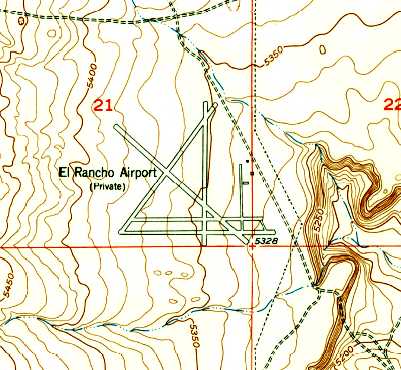
The 1954 USGS topo map (courtesy of Laura Gleasner) depicted El Rancho Airport as a private field,
but with an atypically elaborate arrangement of of no less than 4 runways (the longest being the 3,500' northwest/southeast strip),
with 2 taxiways & 2 small buildings on the east side.
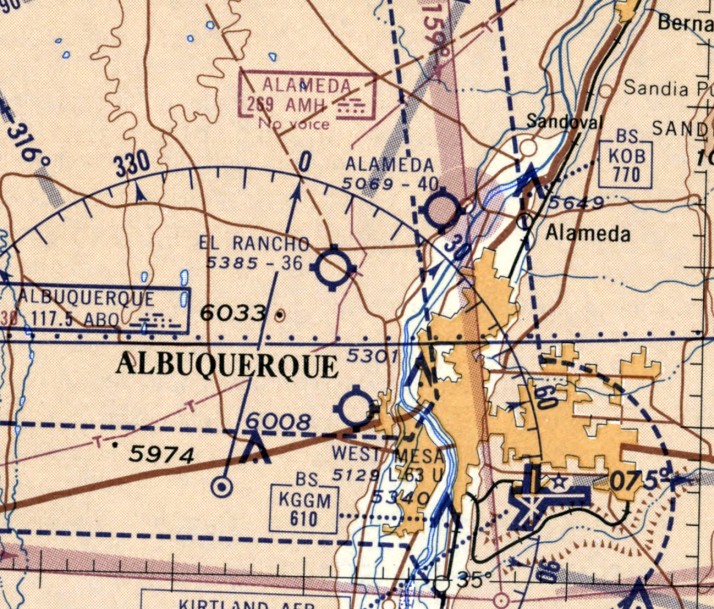
The last aeronautical chart depiction which has been located of El Rancho Airport was on the May 1958 Albuquerque Sectional Chart,
which depicted El Rancho Airport as having a 3,600' unpaved runway.
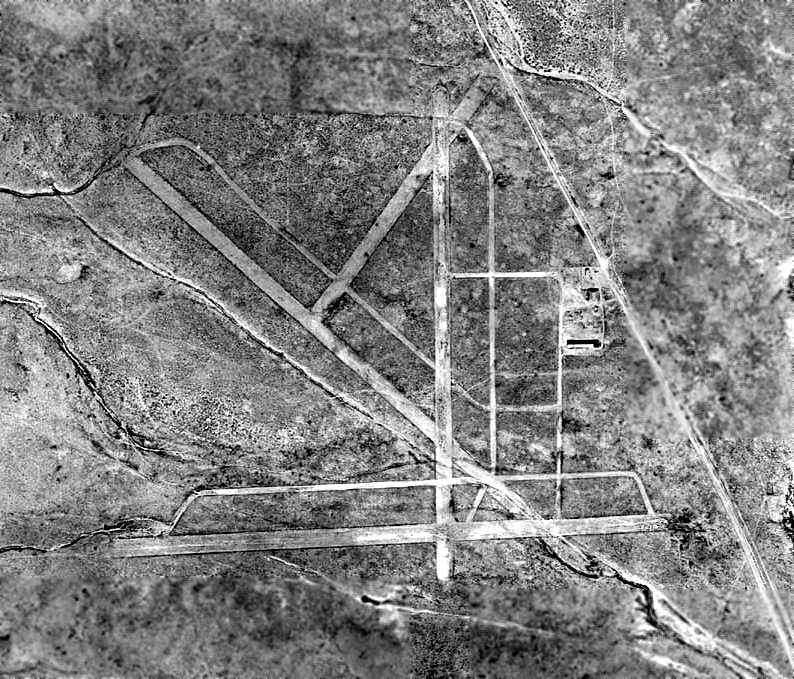
The earliest photo which has been located of El Rancho Airport was a 1959 aerial view (courtesy of Laura Gleasner).
It depicted the field as having 4 runways, 4 taxiways, and 2 hangars on the east side.
There were no aircraft visible on the field, or any other signs of recent aviation activity,
but the runways appeared quite distinct, so it's possible the field had been newly-constructed at this point.
Given the elaborate layout of taxiways, might El Rancho have been constructed as a planned residential airpark community?
The 1960 USGS topo map continued to depict El Rancho Airport in the same fashion as shown on the 1954 USGS topo map.
El Rancho Airport was evidently closed (for reasons unknown) at some point between 1958-60,
as it was no longer depicted on the March 1960 Albuquerque Sectional Chart.
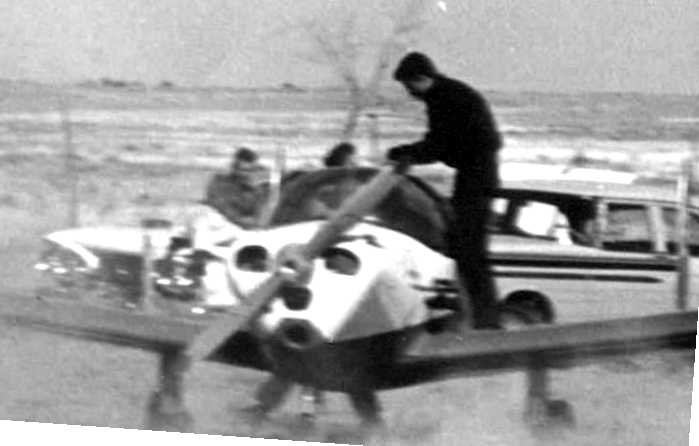
The only photo which has been located showing an aircraft at El Rancho Airport was a 2/1/62 photo by George Atkinson.
George recalled, “El Rancho Airport had been abandoned, but runways were not too rough for an Ercoupe.
A sports car race was held on that day; this spectator arrived by air.”
Dan McGrew recalled, “The El Rancho Airport never got off the ground. I know, bad pun.
When I was 10 year oldish [1963] I remember a parachuting club that used the field.
They'd let the jumpers out above it & I could watch them from my house or my friends
and I would ride our bikes over the dirt roads to get as close as we could.
The planes would land on the old strips & pick them up after they repacked & they'd do it all over.
This was around 1962-63. The airport was on top of Volcano Cliffs.”

A 1967 aerial view (courtesy of Laura Gleasner) depicted El Rancho Airport in a considerably deteriorated fashion compared to the 1959 photo.
The 2 buildings had been removed at some point between 1959-67, and a road had been built over the western portion.
El Rancho Airport appears to have been a commercial venture that went “bust”.
The 1969 USGS topo map no longer depicted anything at the site of El Rancho Airport.
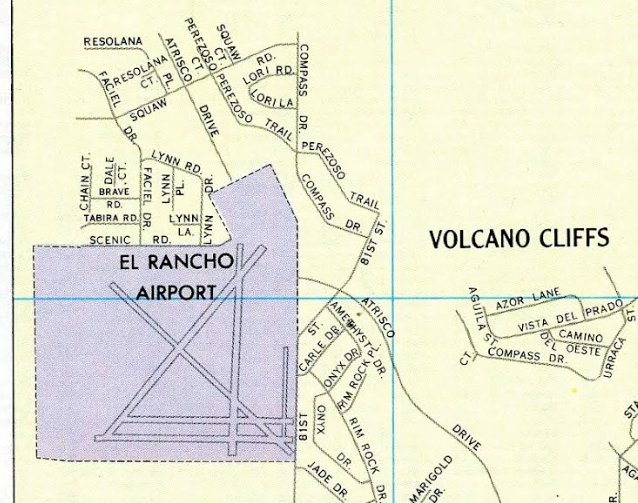
A 1973 road map (courtesy of Fred DeGuio) still depicted El Rancho Airport as 4 runways,
even though it had apparently been closed for at least a dozen years by that point.

The last map depiction which has been located of El Rancho Airport was on a May 1977 Sandia Laboratories Environmental Impact Report.
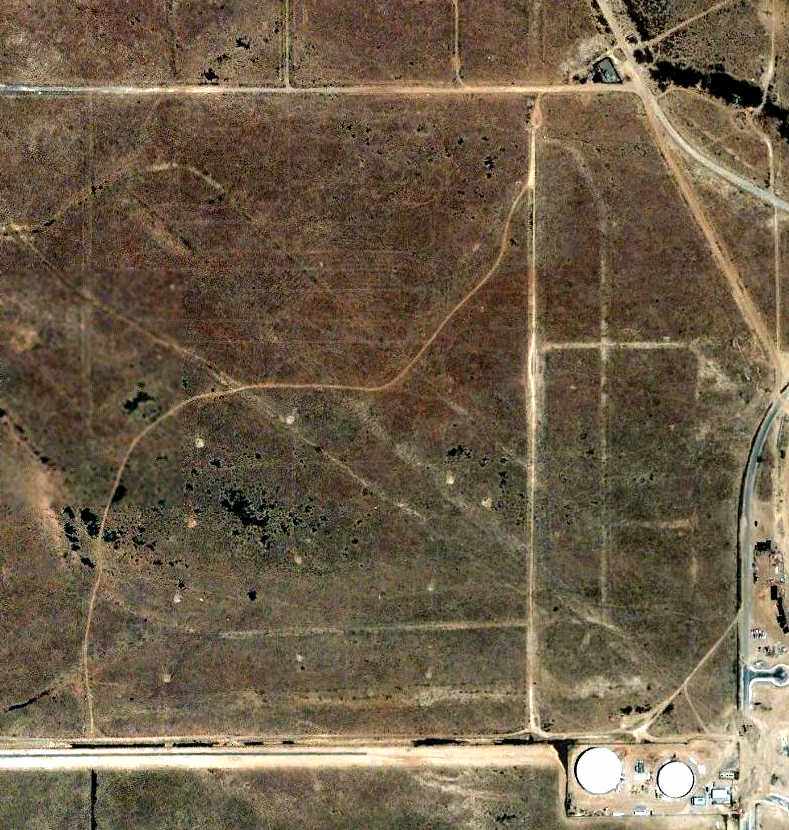
The runway layout of El Rancho Airport was still plainly apparent in a 6/22/05 aerial photo.

The last photo which has been located which still shows any trace of El Rancho Airport was a 1/1/06 aerial photo, in which a housing development covered the eastern half,
but traces of the western portions of the northwest/southeast & east/west runways were still evident.
A 1/22/09 aerial view showed that the housing development had covered all of the site of El Rancho Airport, erasing any trace of the airport.
The site of El Rancho Airport is located northwest of the intersection of Unser Boulevard & Molten Rock Road.
______________________________________________________
Oxnard Field / (Original) Albuquerque Airport / Mobile Air Depot, Albuquerque, NM
35.04, -106.56 (East of Kirtland AFB, NM)
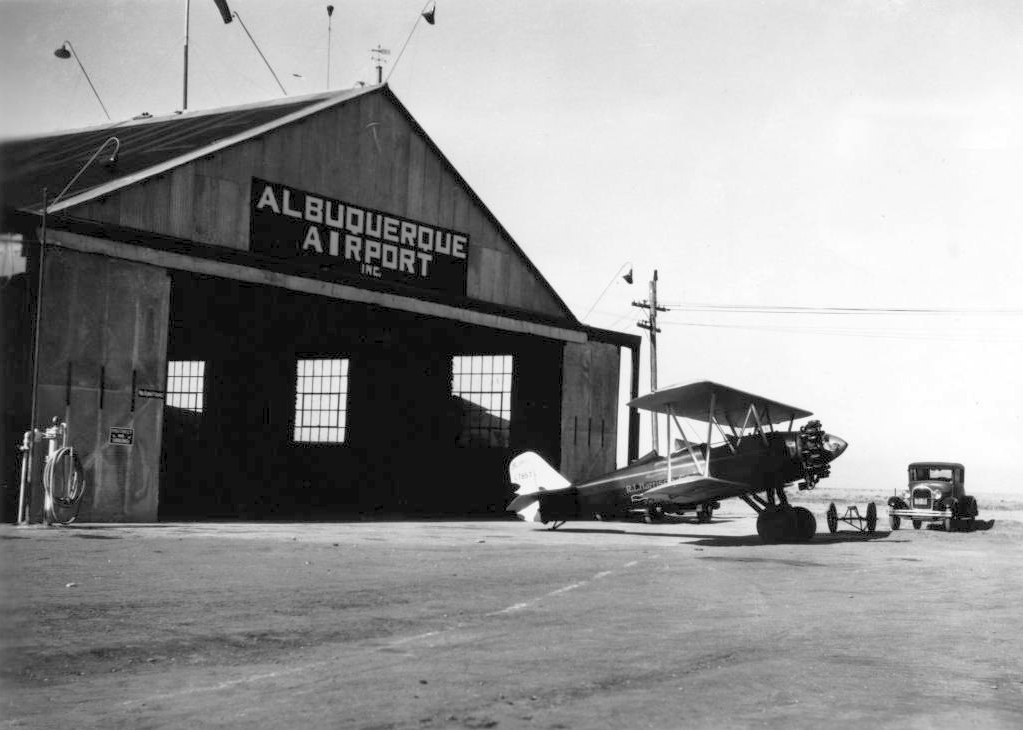
A 1928 photo of an Albuquerque Airport hangar & R.L. Harrison's Butler biplane at Oxnard Field.
Many residents of Albuquerque probably assume that the town's original airport
was situated on the site which eventually evolved into today's Albuquerque International Airport / Kirtland AFB.
However, this is not correct – the original Albuquerque Airport was actually a separate airfield,
located to the east of the eventual location of Albuquerque International Airport / Kirtland AFB.
In 1928, Frank Speakman & William Franklin, 2 Santa Fe railroad employees, inaugurated a private venture for an airport (according to the Kirtland AFB website).
Working with the town of Albuquerque, they graded 2 runways on East Mesa with one approximately 5,300' long & the other just under 4,000'.
It was constructed on 140 acres of homestead land (according to the Sandia National Laboratories website).
Albuquerque Airport was wholly a private venture, irrespective of the town’s involvement.
Immediately following construction of the airport, other individuals and promoters became interested in Albuquerque as a crossroads location for southwestern air traffic.
James Oxnard, a New York entrepreneur, bought Franklin’s interest in Albuquerque Airport,
expanding the facility toward the end of 1928.
The earliest directory listing of the field which has been located was in the 1929 Airplane Landing Fields of the Pacific (courtesy of Chris Kennedy).
It described the Albuquerque Airport as a commercial field, measuring 5,280' x 3,960'.
The field was said to have 2 runways: 4,300' east/west & 2,500' northeast/southwest.
A hangar, administration building, and T.A.T. Office building
were said to be located along the center of the north side of the field.
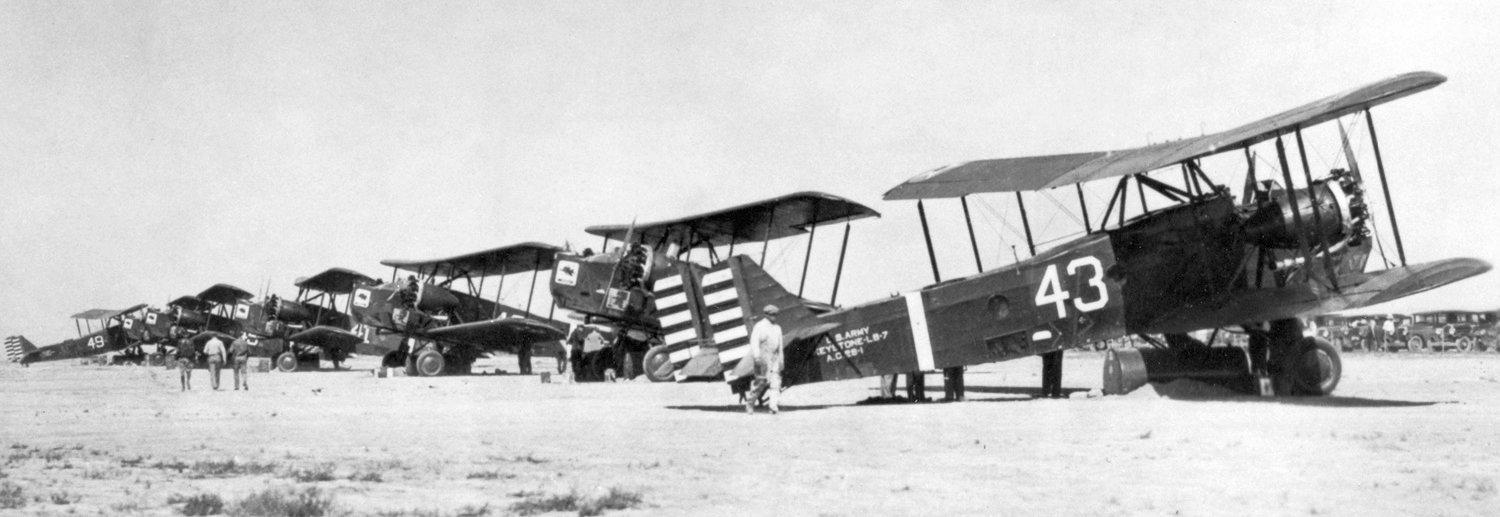
A circa 1929-35 photo of US Army Keystone LB-7 bombers at Oxnard Field.
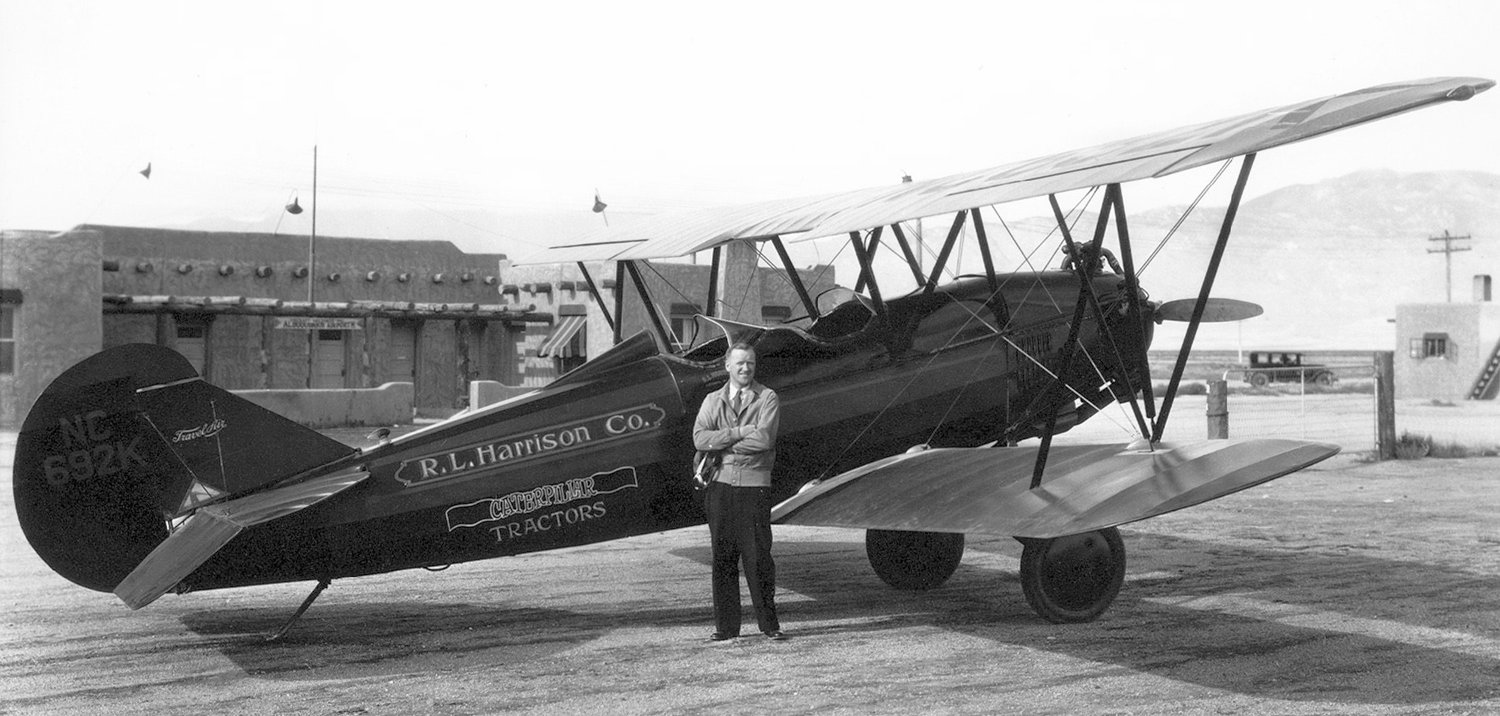
A circa 1930 photo of R.L. Harrison Company Travel Aire E-4000 NC692K C/n 1279 in front of the Oxnard Field terminal building.
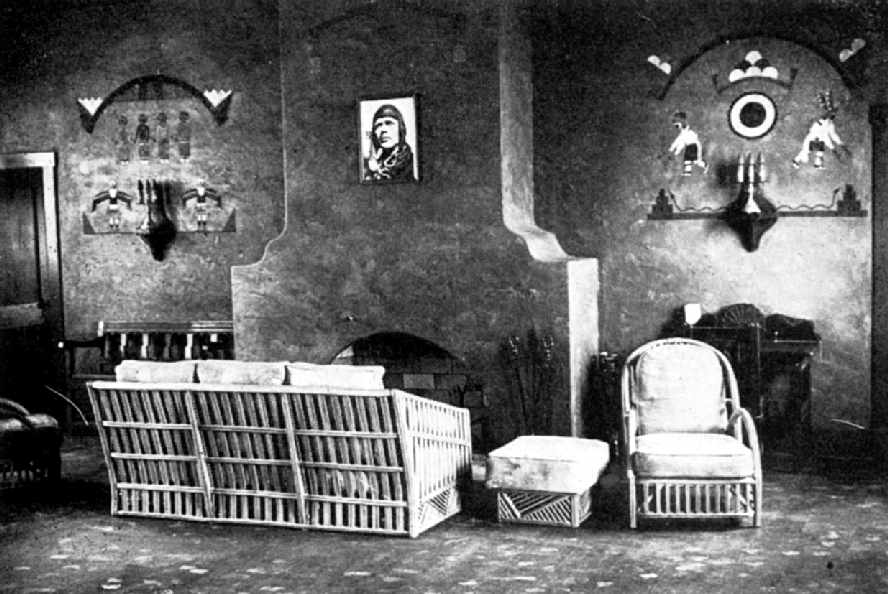
A 1930 photo of the interior of the Oxnard Field terminal building (courtesy of David Brooks).
Note the portrait of Charles Lindbergh hanging over the fireplace.
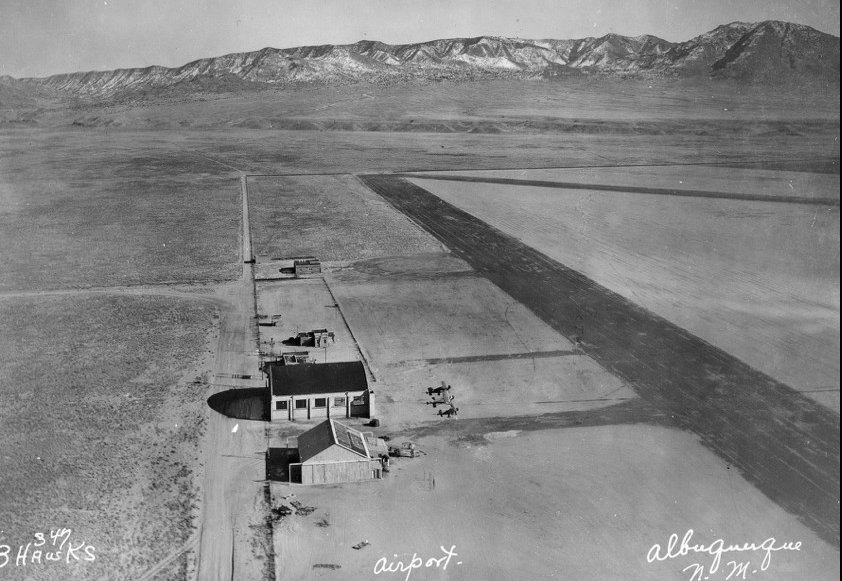
A circa 1930 aerial view looking east at the hangars & runways of the original Albuquerque Airport (courtesy of John Kielhofer),
with 3 light single-engine planes parked in front of the hangars.
As the decade closed, 2 airlines initiated competitive passenger, mail and cargo service between the Midwest & California,
positioning Albuquerque as an important transcontinental airfield.
Shortly after beginning activities, one of the companies, Western Air Express, decided to build its own airport on the West Mesa.
This airport became known as Albuquerque Airport,
while the former Albuquerque Airport on the East Mesa took on the name Oxnard Field, continuing as a private venture.

The earliest aeronautical chart depiction which has been located of the original Albuquerque Airport was on the 1932 Albuquerque Sectional Chart,
which depicted Albuquerque as a commercial/municipal airport.
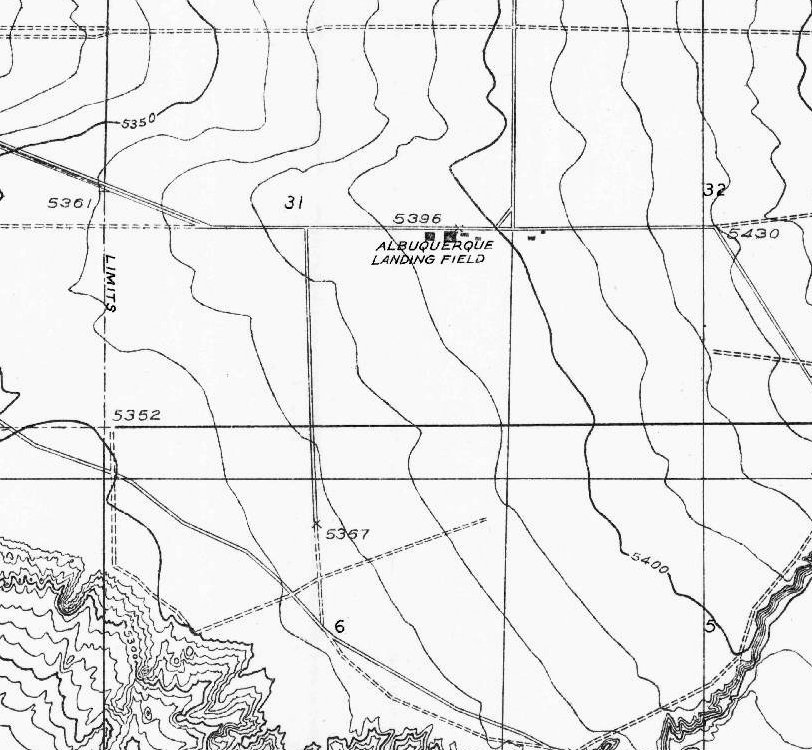
The 1934 USGS topo map depicted “Albuquerque Landing Field” as a set of 4 small buildings on the south side of the road,
but did not depict any runways or other airport features.

A 1935 photo of Earl Ortman's Rider-Clark NR 14215 #9 being refueled at Oxnard Field during the Bendix Trophy Race.

A 1935 aerial view of the Albuquerque Airport (from the NM RGIS, courtesy of Chris Kennedy)
depicted the field as having 4 runways, with a few buildings along the north side of the field.
The 1/1/36 “Descriptions of Airports & Landing Fields in the U.S.” (according to David Brooks)
described the “Albuquerque Airport” as a commercial field,
having 2 dirt runways, measuring 4,000' east/west & 2,500' northeast/southwest,
with a comment that the entire field was usable.
It had at least one hangar, with “Albuquerque Airport” painted on the roof.

An aerial view looking southwest at the original Albuquerque Airport
from The Airport Directory Company's 1937 Airport Directory (courtesy of Bob Rambo).
The directory described Albuquerque as a commercial field, measuring 480 acres in size, with a sandy surface.
The field was said to have 2 runways: 4,000' east/west & 2,500' northeast/southwest.
A cluster of hangars was depicted along the south side of the field,
one of which was said to have “Albuquerque Airport” on its roof.
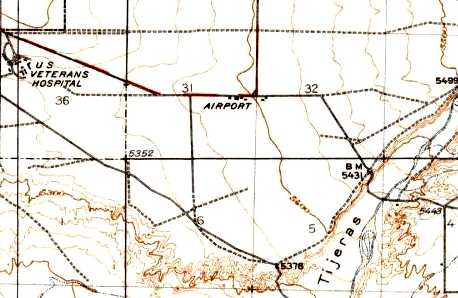
The 1938 USGS topo map depicted a set of 4 small buildings on the south side of the road,
labeled simply as “Airport”, but did not depict any runways or other airport features.
In mid-1939, the City of Albuquerque opened a new Albuquerque Municipal Airport approximately 4 miles west of Oxnard Field.
As of late 1939, Army & Navy pilots began using Oxnard Field for refueling & maintenance for a variety of military flights.
The Army eventually took over the Oxnard Field property for military use, with subsequent transfer to the federal government.
The Albuquerque Airport was used as a stopover for air crews
ferrying California-built bomber aircraft to England in the late 1930s & early 1940s.
The original Albuquerque Airport was depicted as a commercial/municipal field
on the April 1941 Albuquerque Sectional Chart (courtesy of Chris Kennedy).
The chart also depicted the newly-constructed Albuquerque Municipal Airport,
which had been constructed adjacent to the west side of the original Albuquerque Airport.
The number of runways at Albuquerque was increased to 6 at some point between 1937-41,
as The Airport Directory Company's 1941 Airport Directory (courtesy of Chris Kennedy)
described Albuquerque as having a total of 6 runways, with the longest being the 6,600' northeast/southwest strip.
In late 1942 the Army Air Forces acquired Oxnard Field (approximately 11,000 acres to the east of Kirtland Field),
and construction began on the Albuquerque Air Depot Training Station, a training depot for aircraft mechanics.
The January 1942 Albuquerque Sectional Chart (courtesy of Chris Kennedy)
still depicted the original Albuquerque Airport was depicted as a commercial/municipal field.
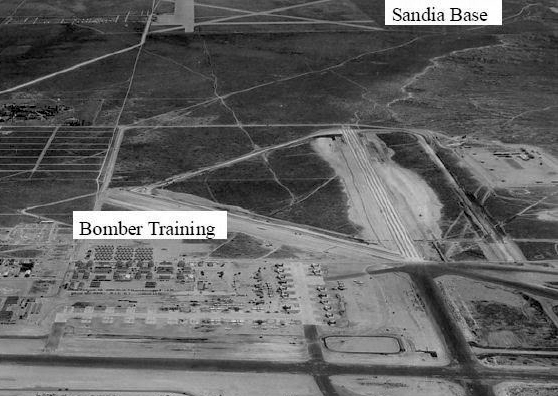
A 1942 aerial view looking east (courtesy of Bill Eaton) showed Kirtland Field (foreground) and the original Albuquerque Airport in the background.
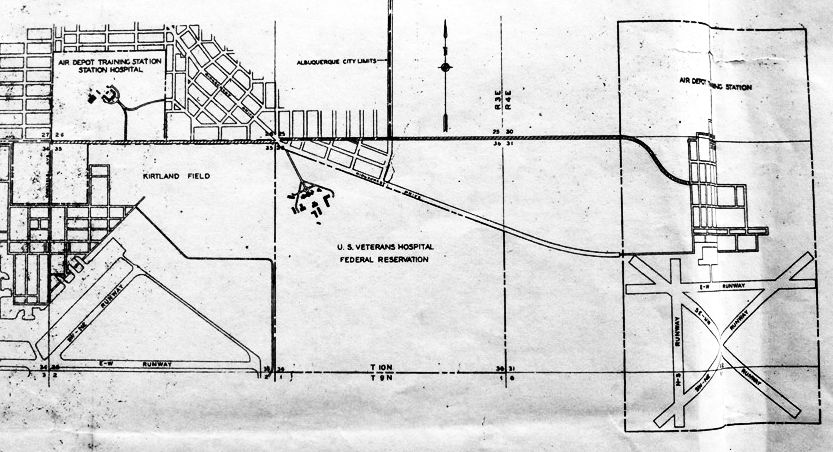
The 4 runways of the original Albuquerque Airport were depicted to the east of Kirtland Field on a 1943 plan, inside an outline labeled “Air Depot Training Station”
(from the St. Louis National Personnel Records Center, courtesy of Ron Plante).
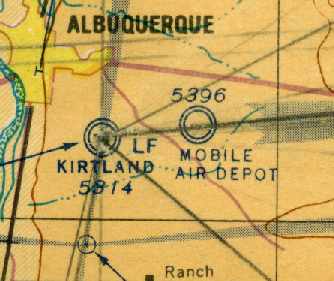
The original Albuquerque Airport was depicted as a military airfield, labeled “Mobile Air Depot”
on the 1943 Albuquerque Sectional Chart (courtesy of David Brooks).
The February 1944 Albuquerque Sectional Chart (courtesy of Chris Kennedy)
labeled the field as “Albuquerque (Aux) Army Air Field”.
During the latter part of WW2, Oxnard Field was transferred from the jurisdiction of the Army Air Corps
to the U.S. Army Service Forces Chief of Engineer District
and thereafter assigned to the Manhattan Engineer District (otherwise known as “The Manhattan Project”).
In July of 1945, the forerunner of Sandia Laboratory, known as "Z" Division,
was established at Oxnard Field to handle future weapons development,
testing, and bomb assembly for the Manhattan Engineer District.
The "Z" Division facilities originally consisted of wood sheds & buildings.
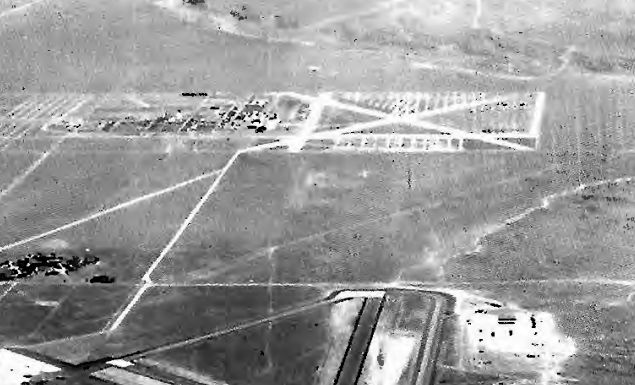
The ramps of Oxnard Field were covered with a large number of objects (buildings or possibly surplus aircraft).
A June 1946 Department of Commerce Airman's Guide (according to Chris Kennedy)
described the original Albuquerque Airport as of 6/6/46 as “Used by the Reconstruction Finance Corporation.
Available only for delivery of surplus aircraft to this field,
prospective purchasers of surplus aircraft or parts, or in emergency.”
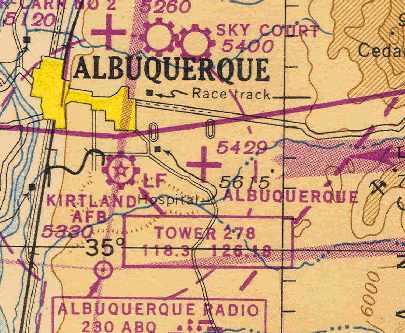
The last depiction which has been located of the original Albuquerque Airport as an active airfield
was on the September 1948 Albuquerque Sectional Chart (courtesy of Chris Kennedy).
It depicted the original Albuquerque Airport as an auxiliary airfield.
The Manhattan Engineer District's "Z" Division used temporary buildings
until construction of more permanent buildings for an expanded facility began in 1948.
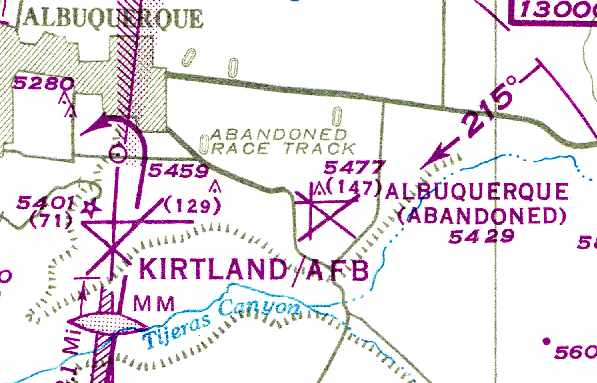
The original Albuquerque Airport was evidently closed at some point between 1948-49,
as it was depicted on the 1949 USAF Pilot's Handbook (courtesy of Chris Kennedy) as “Albuquerque (Abandoned)”.
It was depicted as having 4 runways.
By the time of the September 1954 Albuquerque Sectional Chart (according to Chris Kennedy),
the original Albuquerque Airport was no longer depicted at all.

A 1995 photo by Michael Horne of the pre-1929 hangar which remained standing at the site of Oxnard Field, now part of the property of Kirtland AFB.
The former airfield buildings were being used by the Air Force for vehicle maintenance.
Note the missiles on display to the left of the hangar.
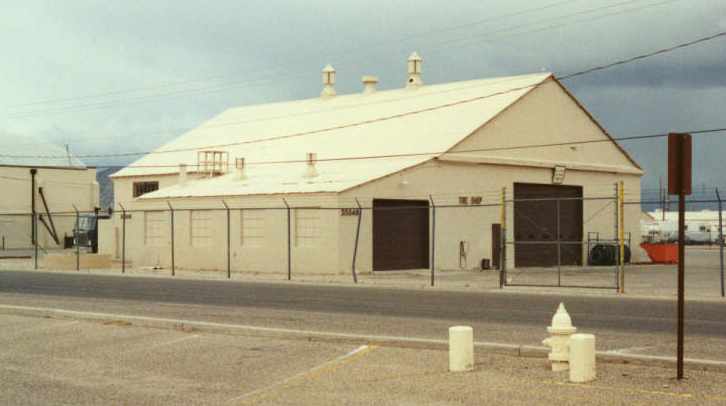
A 1995 photo by Michael Horne of the pre-1929 former terminal building which remained standing at the site of Oxnard Field,
now part of the property of Kirtland AFB.
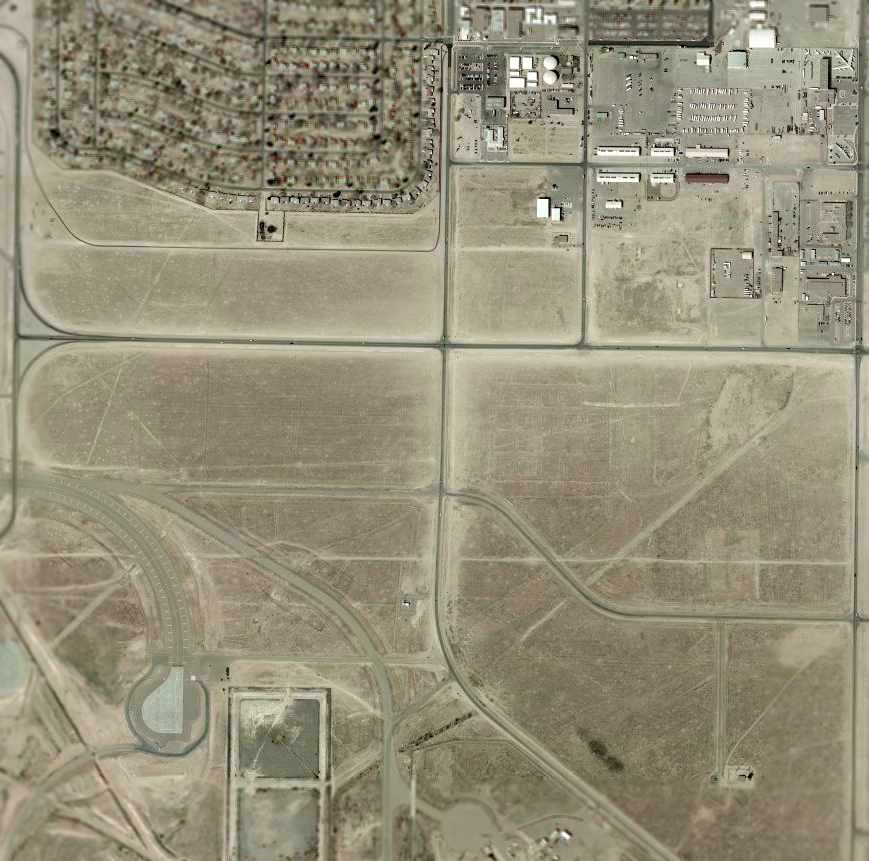
More than 50 years after the original Albuquerque Airport was closed,
the 2002 USGS aerial photo still showed the recognizable trace of the former northeast/southwest runway.
The remaining hangar & terminal building are at the top-right.
Note the B-52 & other static aircraft among the collection of the National Atomic Museum, just east of the hangar, at top-right.
The runways of the present-day Kirtland AFB are adjacent to the site to the west.
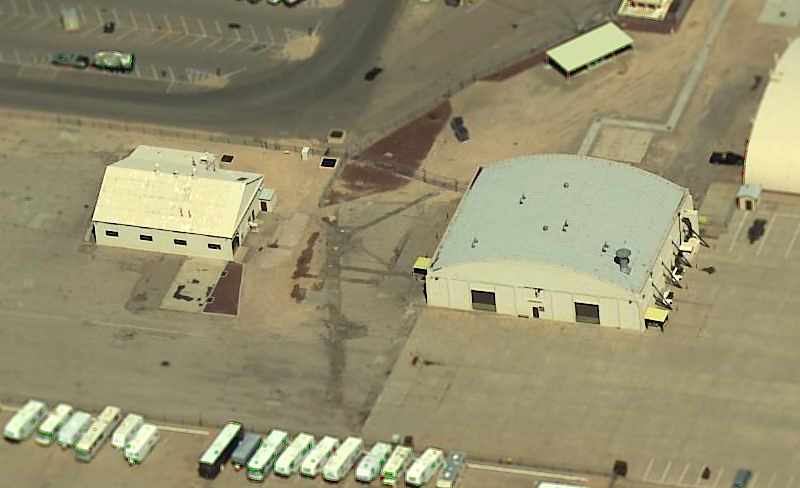
A circa 2005 aerial photo looking north at the pre-1929 terminal building & hangar which remains at the site of Oxnard Field.
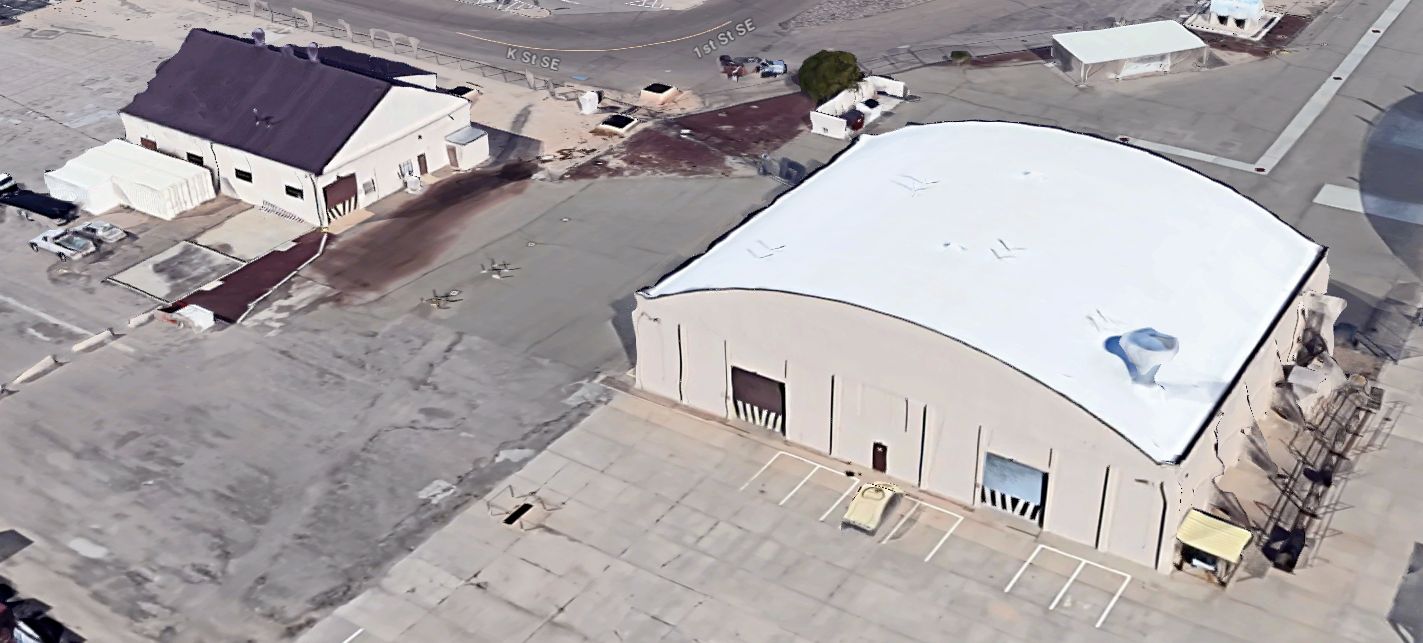
A 2023 3-D aerial image looking northwest at the pre-1929 terminal building & hangar which remains at the site of Oxnard Field.
The site of the original Albuquerque Airport is located southeast of the intersection of Hardin Drive Southeast & Pennsylvania Avenue Southeast.
______________________________________________________
Western Air Express Airport / West Mesa Airport, Albuquerque, NM
35.08, -106.72 (West of Downtown Albuquerque, NM)
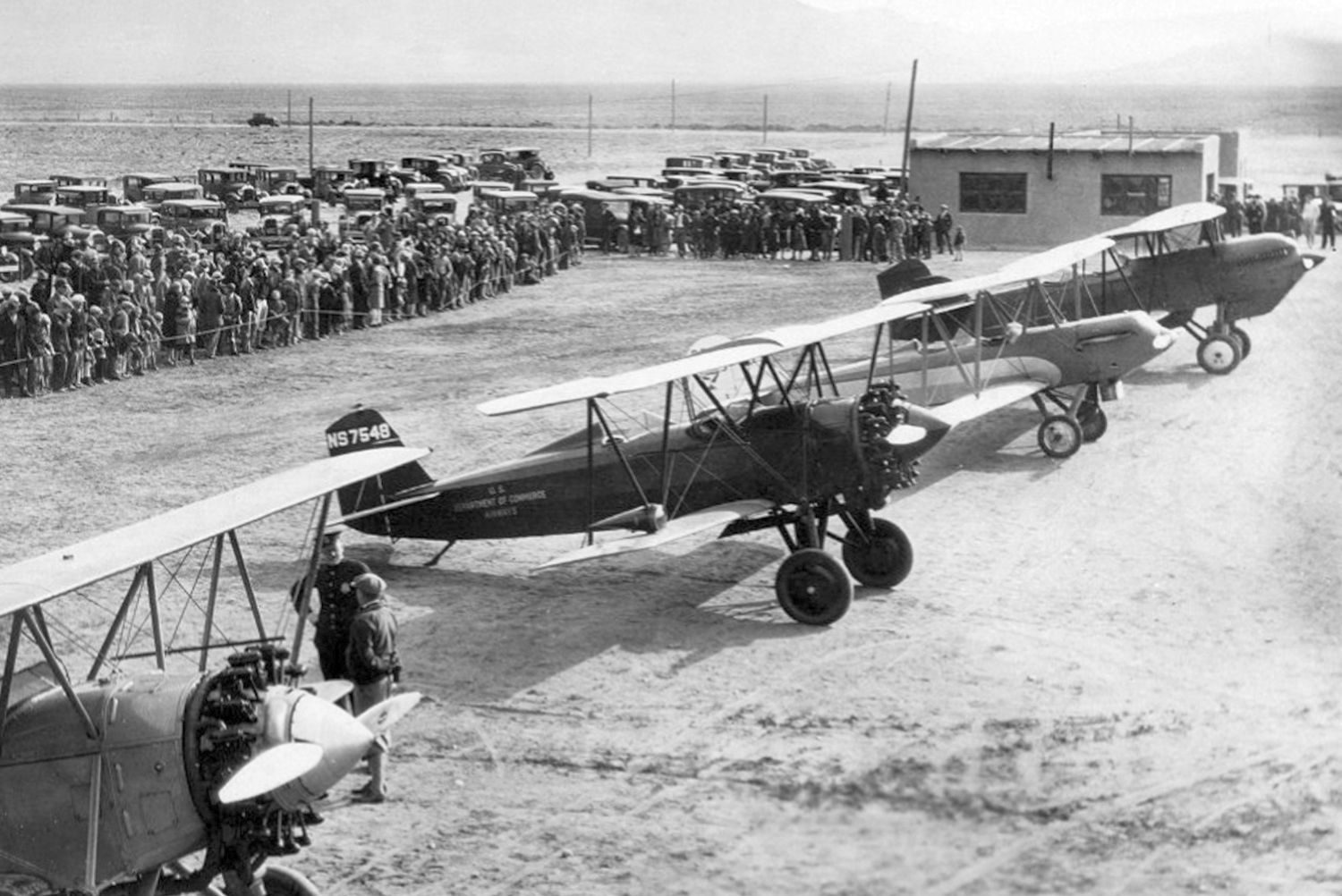
This early commercial airline airport was located on the west side of Albuquerque.
The date of construction of Western Air Express Airport has not been determined.
The earliest reference which has been located to Western Air Express Air[prt was in the 1929 "Standard Oil of CA Airplane Landing Fields of the Pacific West" (courtesy of Chris Kennedy).
It described Western Air Express Airport as being a 1,000' acre square property which had four 6,600' rolled sand & clay runways in the "shape of an 8-point star".
A hangar & administration building was said to be "under construction".
The earliest depiction which has been located of the Western Air Express Airport was a 1929 photo of Commerce Department Stearman C3B C/n 164 & several other aircraft at the airport's opening.

A circa 1930 photo of a Fokker (model undetermined) in between the Western Air Express hangar & terminal building (from the Albuquerque Museum Photo Archives, courtesy of Fred DeGuio).
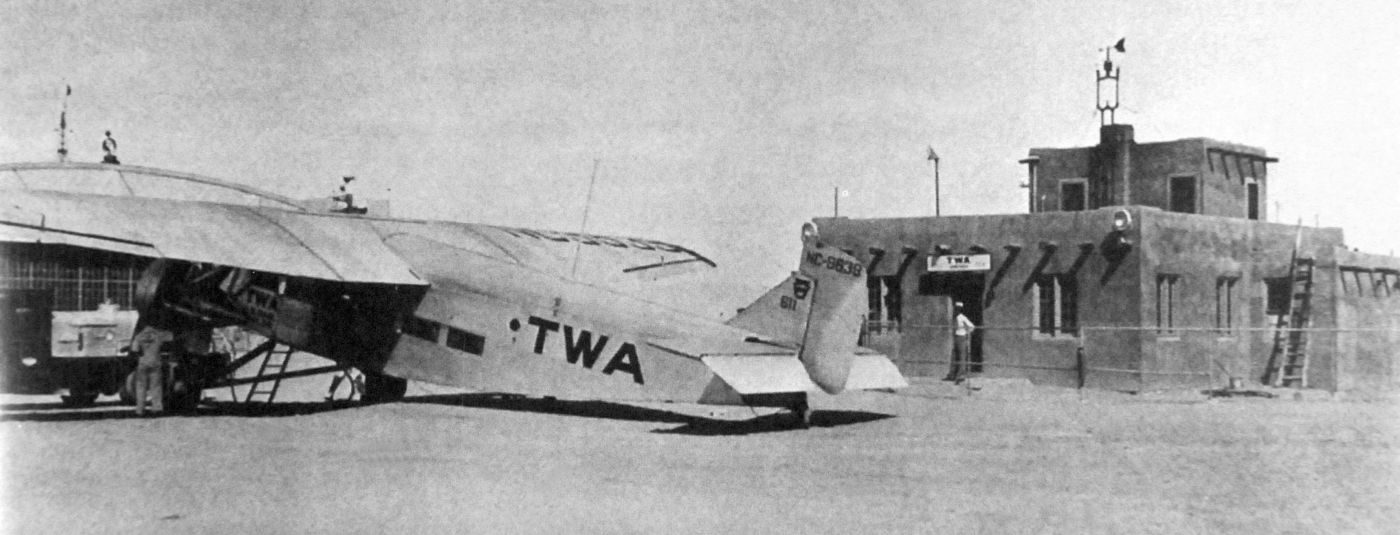
A circa 1930 photo of a Ford Trimotor in front of the Western Air Express hangar & terminal building (from the Albuquerque Museum Photo Archives, courtesy of Fred DeGuio).

The earliest aeronautical chart depiction which has been located of Western Air Express Airport was on the 1932 Albuquerque Sectional Chart,
which depicted Western Air Express as a commercial/municipal airport.
The Airport Directory Company's 1933 Airport Directory (courtesy of Chris Kennedy)
described the "Transcontinental & Western Air" Airport as having four 5,300' runways in a "star shape".

The 1934 USGS topo map depicted a road leading to 2 small buildings,
labeled simply as “Landing Field”, but did not depict any runways or other airport features.
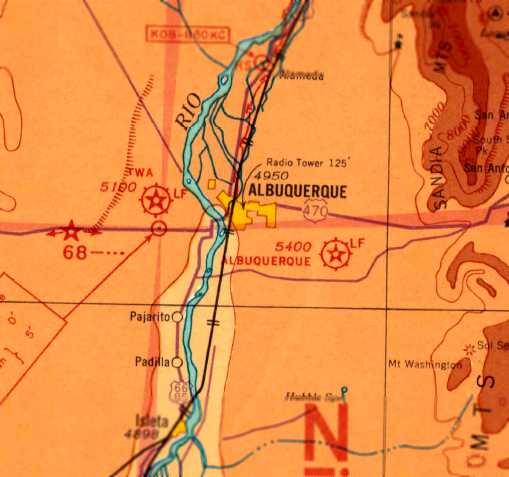
The April 1935 Albuquerque Sectional Chart (courtesy of Dan Deloria)
depicted “TWA” as a commercial/municipal field.
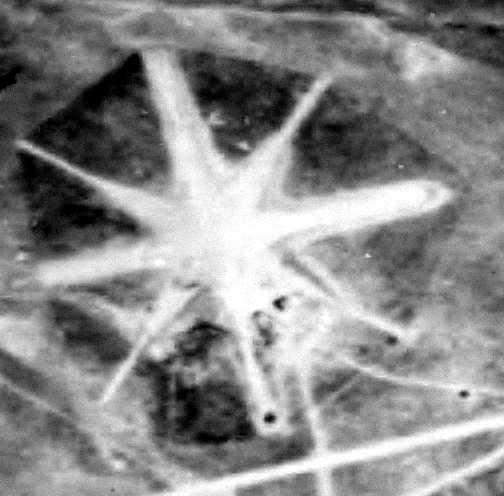
A 1935 aerial view of the West Mesa Airport (from the NM RGIS, courtesy of Chris Kennedy)
depicted the field as having 4 runways in a star pattern, with a building southeast of the runway intersection.
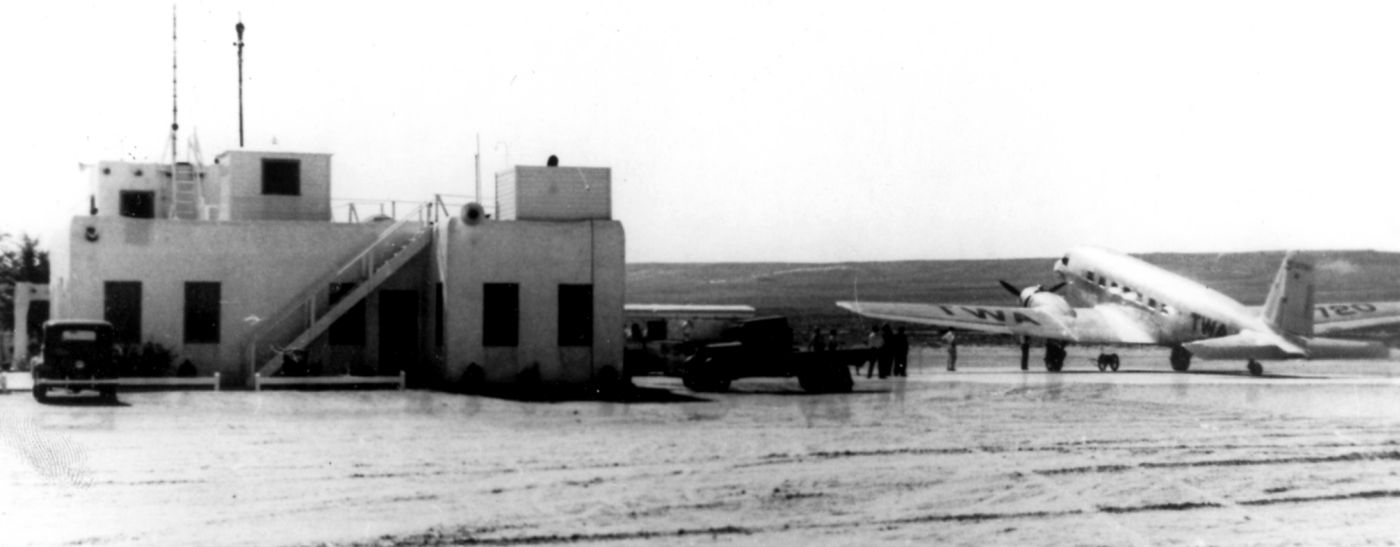
A mid-1930s photo of the Western Air Express terminal building & a Douglas DC-2 (from the Albuquerque Museum Photo Archives, courtesy of Fred DeGuio).

An undated aerial view looking northwest at the "Transcontinental & Western Air" Airport
from The Airport Directory Company's 1938 Airport Directory (courtesy of Chris Kennedy).
The directory described the field as having four 5,280' sandy loam runways.
A single building was depicted on the southeast side of the runway intersection.
The manager was listed as M. B. Joyner, and the operator was listed as Transcontinental & Western Air,
which provided scheduled transport service, airplane sales & service, charter, and instruction.
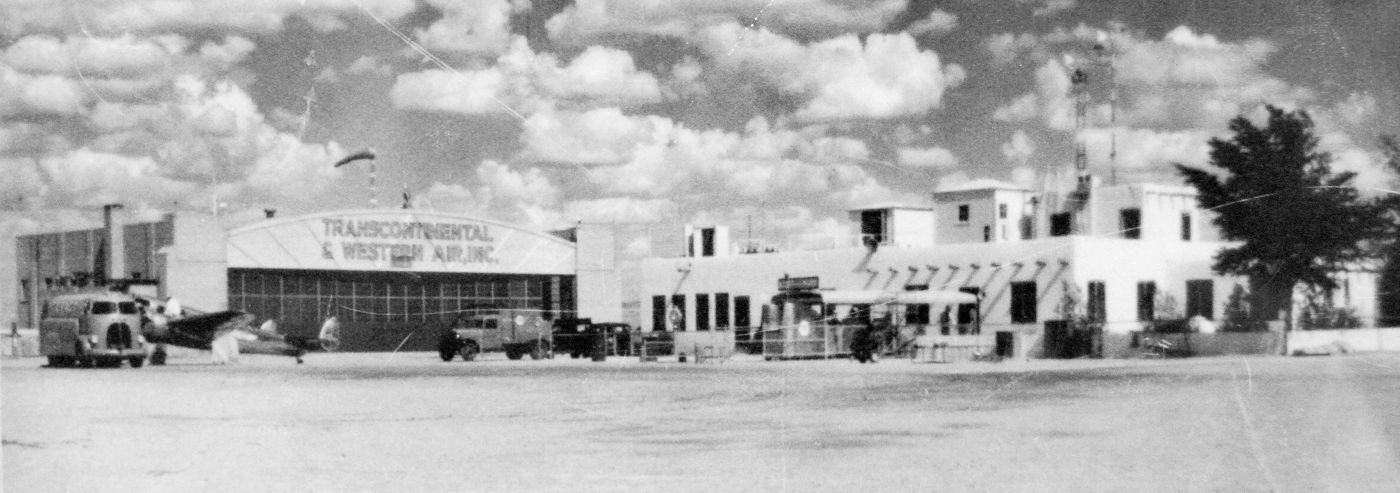
A late-1930s photo of a Lockheed Electra in front of the Western Air Express hangar & terminal building (from the Albuquerque Museum Photo Archives, courtesy of Fred DeGuio).
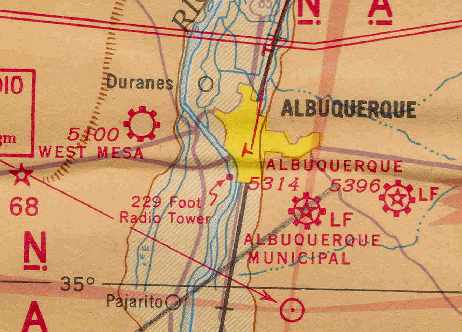
The field was evidently renamed "West Mesa" Airport at some point between 1938-41,
as that is how it was depicted on the April 1941 Albuquerque Sectional Chart (courtesy of Chris Kennedy).
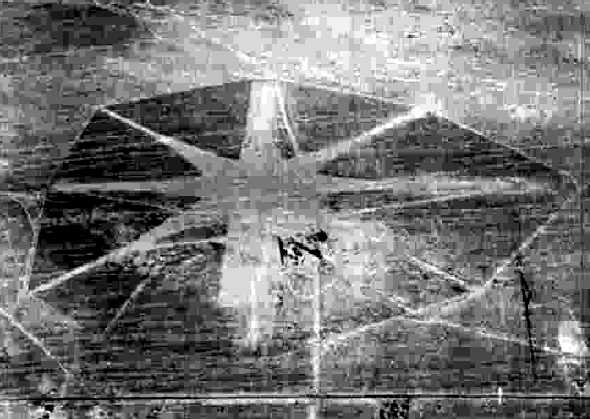
A circa 1942-45 aerial view looking north from the 1945 AAF Airfield Directory (courtesy of Scott Murdock)
depicted the characteristic 8-point star layout of West Mesa Airport.
The directory described West Mesa as a 715 acre irregularly-shaped property having 4 bare runways, the longest being the 6,000' north/south strip.
The field was said to have 2 hangars, the largest being a 110' x 100' concrete & metal building.
West Mesa was described as being owned by the Town of Atrisco, and operated by private interests.
West Mesa was said to have an “auxiliary field” (unusual for a civilian airport?): Cutler-Carr Field #2, located 6 miles ENE.
According to the Cutter Aviation website, during WW2, “the U.S. Navy designated Cutter as a Naval Air Training School as part of the Civilian Pilot Training Program
at its primary business location at West Mesa Airport in Albuquerque.”
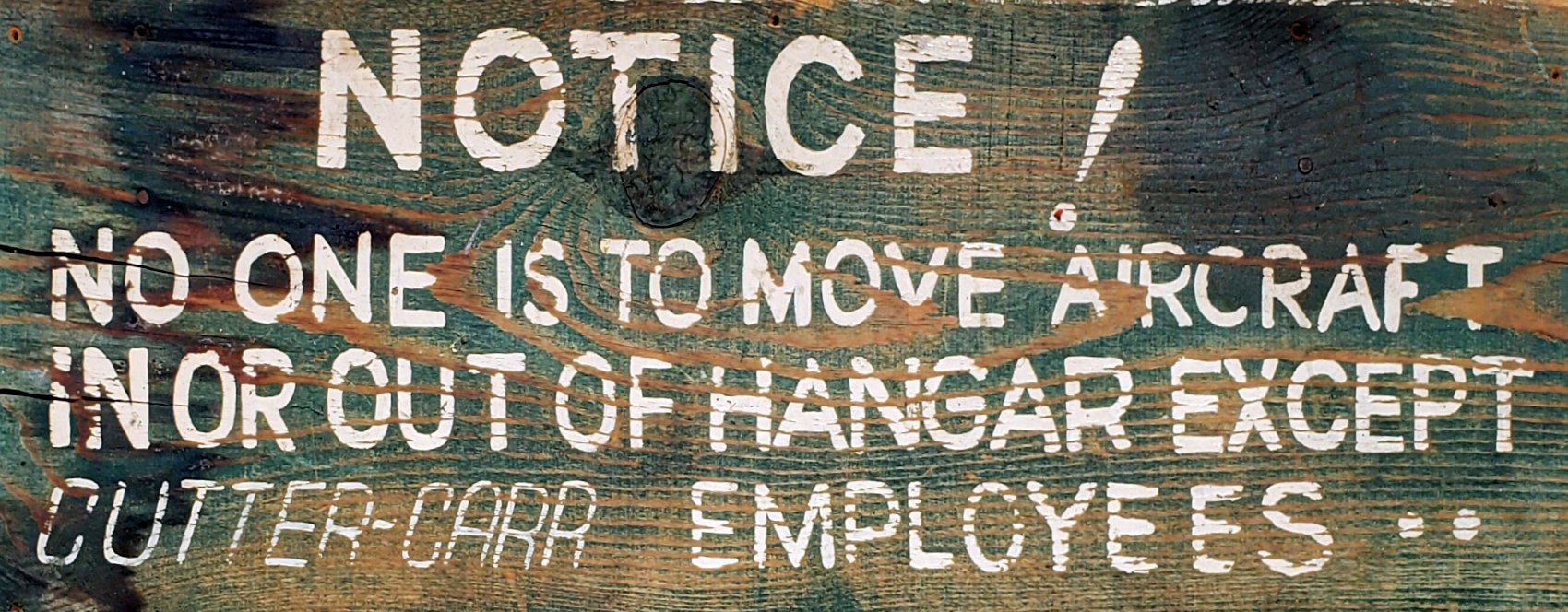
A 2/6/23 photo by Dan Rhinehart of a circa 1940s “original Cutter-Carr wood sign that came from the Cutter-Carr hangar at West Mesa Airport.”
According to the Cutter Aviation website, “Cutter moved to the larger Albuquerque International Sunport in 1947 as activity at West Mesa Airport began to decline,
but continued to offer refueling from West Mesa.”
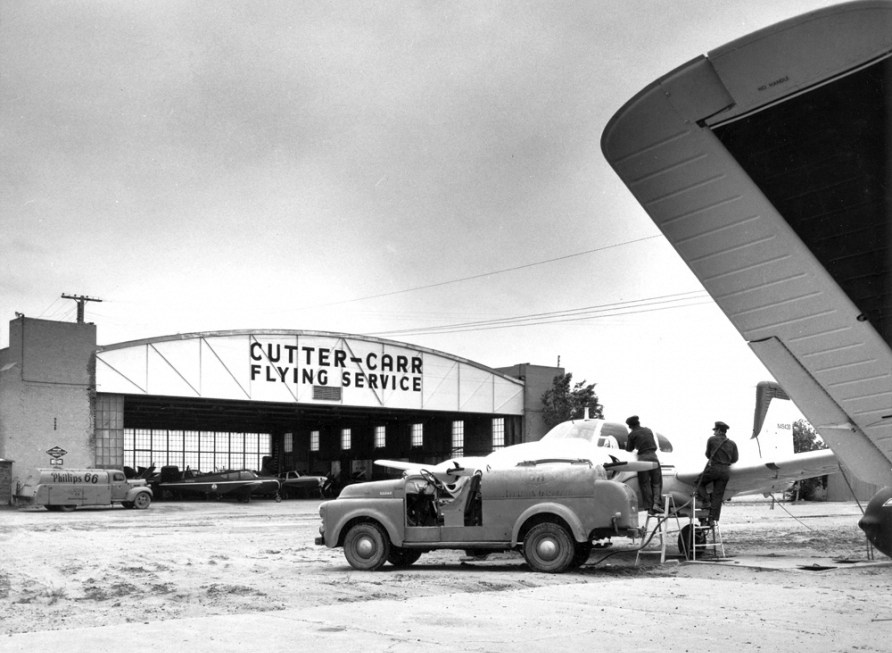
A 1950 photo of refueling a twin Beech in front of the Cutter-Carr Flying Service hangar at West Mesa Airport (courtesy of Jim Hackman).
Jim Hackman recalled, “West Mesa Airport... I landed there while ferrying a no-radio/lights Super Cub from Lockhaven to Visalia, CA in 27:45 & 5 days!”
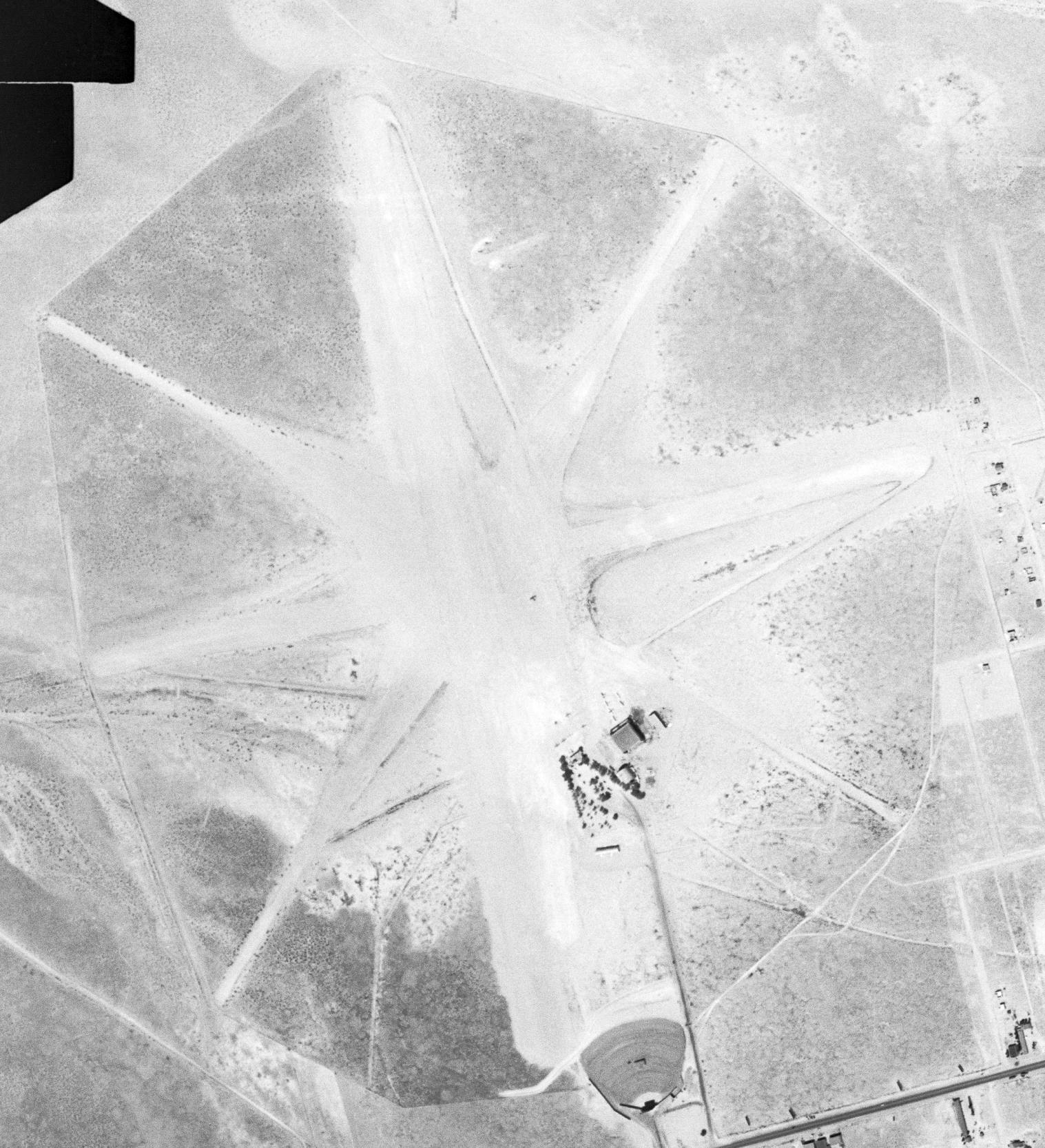
A 9/22/49 USGS aerial view depicted the characteristic 8-point star layout of West Mesa Airport,
showing 4 unpaved runways, several hangars & buildings, and a dozen light aircraft parked on the east side.
Note that a drive-in movie theater had apparently been consructed immediately adjacent to the east end of the north/south runway.

A 1951 aerial view depicted 9 light aircraft around the hangar at West Mesa Airport (courtesy of Brett Hamby).
Henry Meyer recalled, “I learned to fly at old West Mesa in 1955.
I remember the crash of an experimental [aircraft] in Summer of 1955 after the pilot was thrown out by the aircraft's quick roll.”

The last photo which has been located showing West Mesa Airport was a late 1950s photo by Dan Rhinehart of an Aeronca at West Mesa Airport.
According to the Cutter Aviation website, “Cutter continued to offer refueling from West Mesa until the late 1950s.”
Dan McGrew recalled, “Around 1959, when I was 6 years old my uncle, Don Tyrack, started flying.
He started flying out of then West Mesa Airport & had gone in on a Piper Cub with a couple of buddies.
I use to go with him all the time & hang out at the airport while he either flew or was taking lessons.
There was a drive-in movie theater off the southeast corner of the airport.
There were no commercial flights into it anymore as they all went into the Sunport by then.”
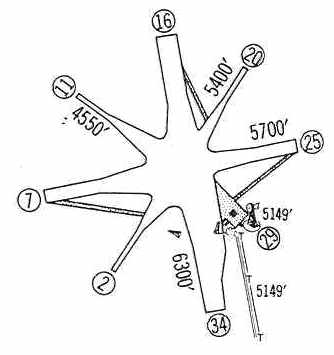
The 1960 Jeppesen Airway Manual (courtesy of Chris Kennedy) depicted the distinctive arrangement of West Mesa Airport,
with 4 unpaved runways arranged in a star (with the longest being the 6,300' Runway 16/34).
A ramp with a single building was depicted on the southeast side of the airfield, directly in line with Runway 29.
Barry Sylvester recalled, “I recall going out to West Mesa Airport around 1960 & watching sailplanes.
The gliders relocated to a airstrip near Moriarty to get away from increasing air traffic.”
Dick Durand III recalled, “My dad was also Dick Durand. Our company name was Westernair.
In approximately 1962 we leased the West Mesa Airport after Cutters had moved out. We were there until we moved to Coronado Airport.
I was lucky enough to grow up with a dad who owned/bought/sold about any kind of exotic/oddball/fighter/bomber/amphib/etc flying machine that you could imagine.”
According to Diane Schaller (President, Historic Albuquerque Inc.), “After Cutter-Carr Flying Service consolidated its organization at the Albuquerque Municipal Airport, vacating West Mesa Airport,
Western Air of Albuquerque, Inc. leased the entire West Mesa property in 1964.
Western Air, owned by Richard Durand Jr., ran a used airplane operation where they bought,
renovated (paint, upholstery & minor engine work) and sold all kinds of small- to medium-sized aircraft.”

An advertisement for Western Air Inc.'s operations at West Mesa Airport from the 10/8/64 Albuquerque Journal According to (courtesy of Diane Schaller, President of Historic Albuquerque Inc.).
According to Diane Schaller (President, Historic Albuquerque Inc.), in 1965 Western Air moved from West Mesa Airport to Coronado Airport.
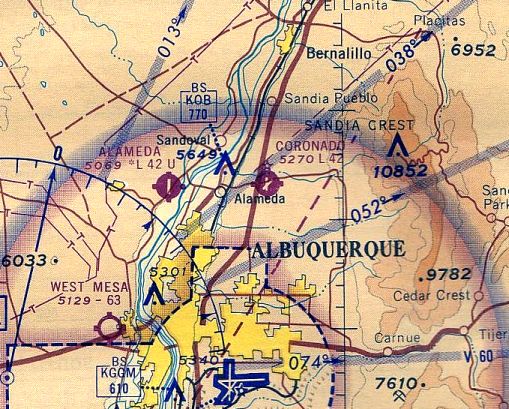
The 1965 Albuquerque Sectional Chart (courtesy of John Price) depicted West Mesa as having a 6,300' unpaved runway.

The last aeronautical chart depiction which has been located of West Mesa Airport was on the August 1967 Albuquerque Sectional Chart (courtesy of Chris Kennedy).
It depicted West Mesa as having a 6,300' unpaved runway.
The West Mesa Airport was was no longer depicted at all on the February 1968 Albuquerque Sectional Chart (according to Chris Kennedy).
Barry Sylvester recalled, “There were parachuting operations on West Mesa Airport in the late 1960s & early 1970s,
but increasing air traffic at the municipal airport became a problem.”
Dan McGrew recalled, “The airport was closed when Albuquerque Public Schools
bought some of the land on the North end of the field & built West Mesa high. I attended it in 1968 when it opened.”

A 1973 road map (courtesy of Fred DeGuio) still depicted West Mesa Airport's characteristic layout of 4 runways.

A 5/29/73 aerial photo (courtesy of Rob Haulenbeek) showed the characteristic star-shaped runway layout of West Mesa Airport was still recognizable,
although buildings had started to be constructed over the site.
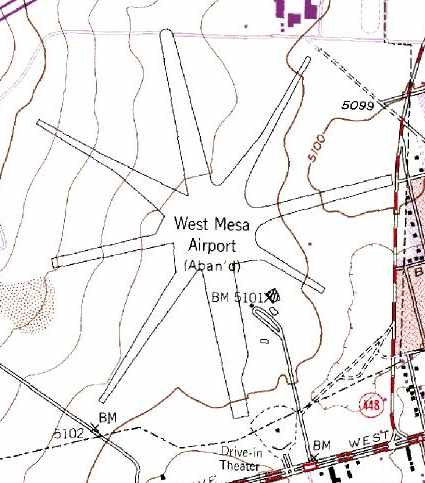
The entire intact runway layout of West Mesa Airport was still shown on the 1996 USGS topo map, almost 30 years after the field had been closed.

In contrast to the topo map from the same year,
the 1996 USGS aerial photo showed that the site of the airport had already been built over by a number of new streets & buildings.
However, in spite of the construction, the outline of several of the former runways was still recognizable,
particularly the western half of the runways.
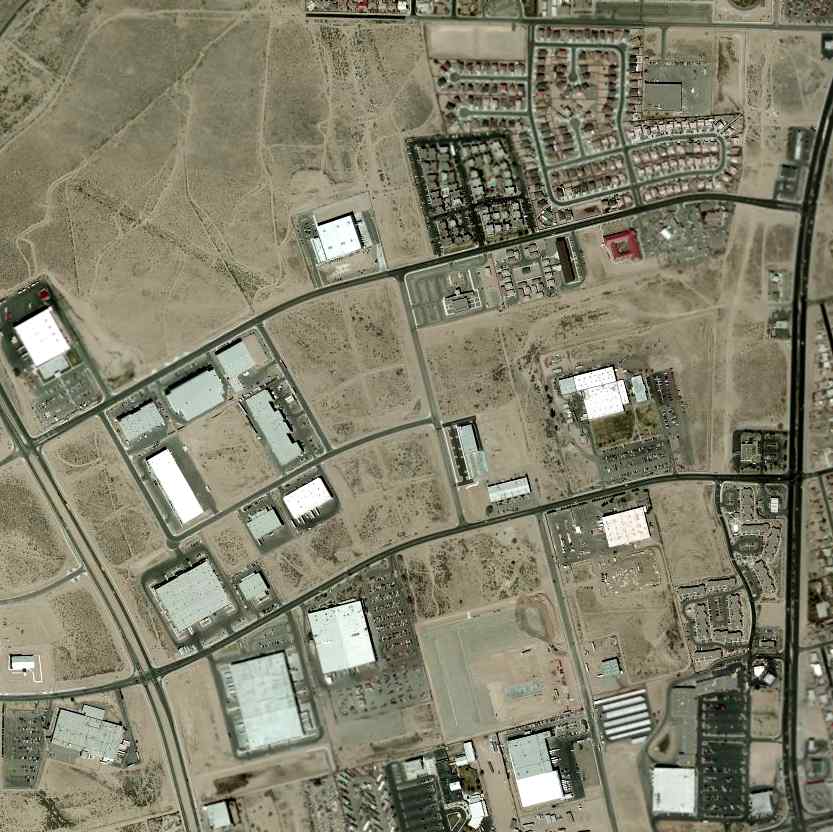
Although the 2002 USGS aerial photo showed that further construction had covered up even more of the former West Mesa Airport,
one very recognizable trace of the airport still remained - the northwestern half of Runway 11.

An August 2007 aerial view by Neal Lawson looking southeast at the recognizable outline of the former Runway 11 at West Mesa.

An August 2007 aerial view by Neal Lawson looking southeast at several remaining traces of the West Mesa Airport.
The remains of the airport loop road is at the top-center,
and the foundation of the former hangar / administration building is at lower left, with bush growing out of it.
Both of those features were depicted on the 1996 USGS topo map.
The road in the upper left is Airport Road NW, and the road at the bottom left is Bluewater Road NW.

A November 2007 photo by Daniel Stallings of the remains of a foundation at the site of the West Mesa Airport.
According to Daniel, “These will might be some of the last photographic evidence of the West Mesa Airport
as the site will likely be graded for construction in the near future.”
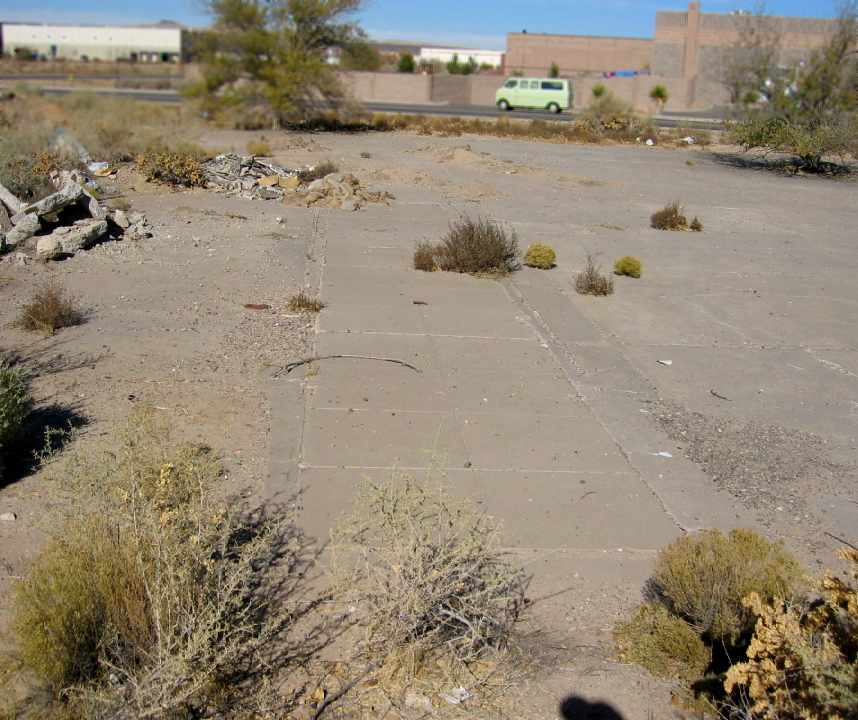
A November 2007 photo by Daniel Stallings of the remains of a foundation at the site of the West Mesa Airport.
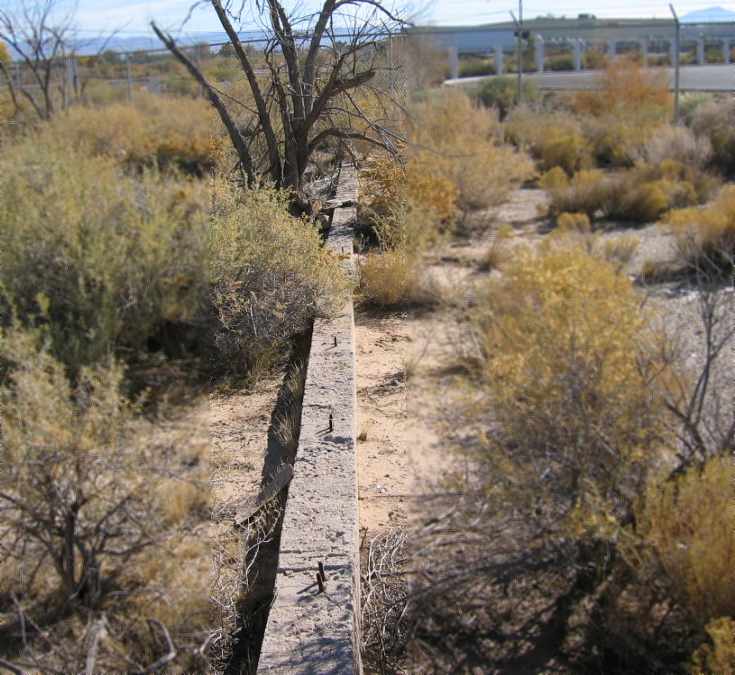
A November 2007 photo by Daniel Stallings of the remains of a foundation at the site of the West Mesa Airport.
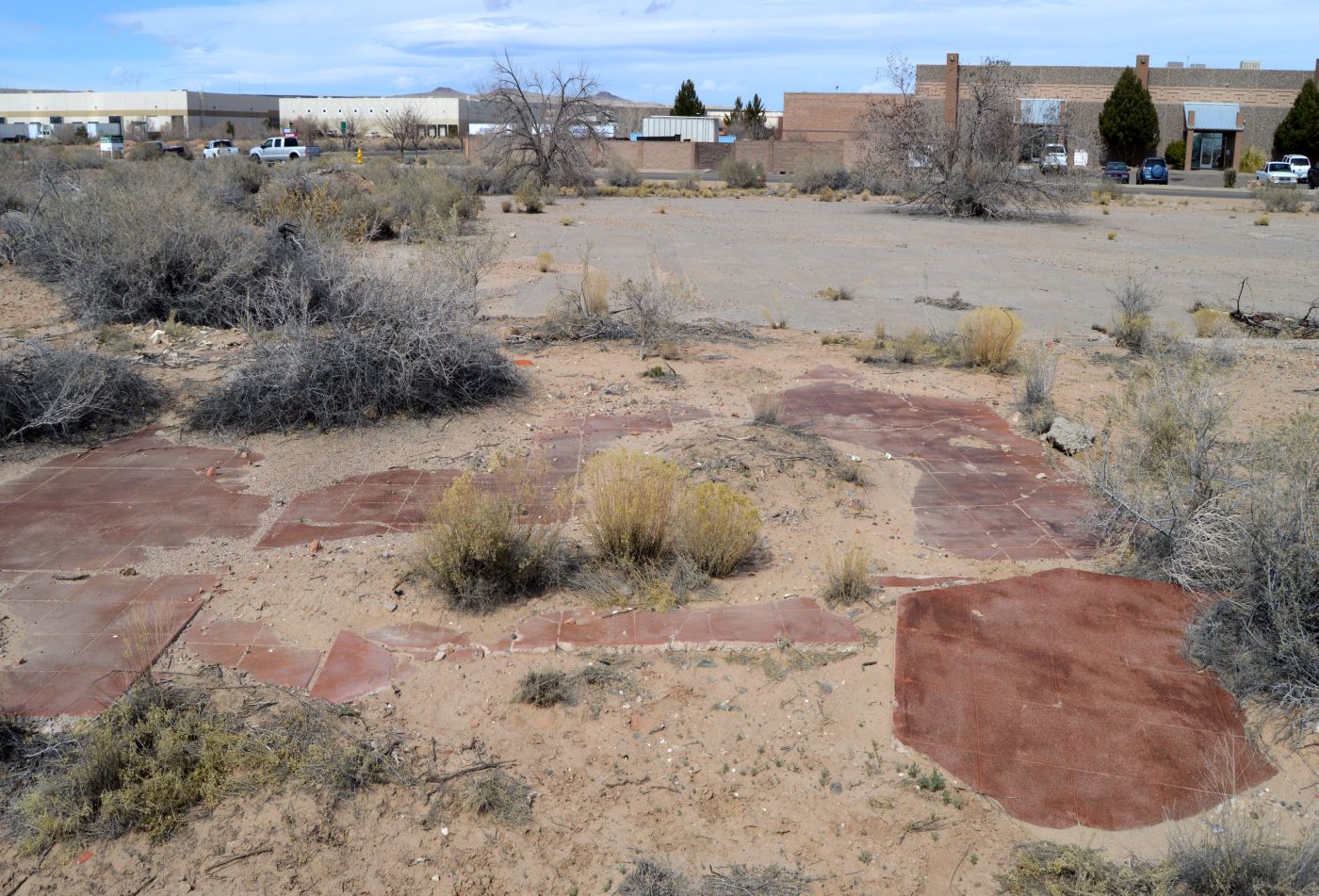
A 2/27/17 photo by Fred DeGuio of “the site of the Western Air Express/West Mesa Airport terminal”,
showing “an area of red floor tiles, possibly from the terminal which would have been at that spot just south of the ramp.”
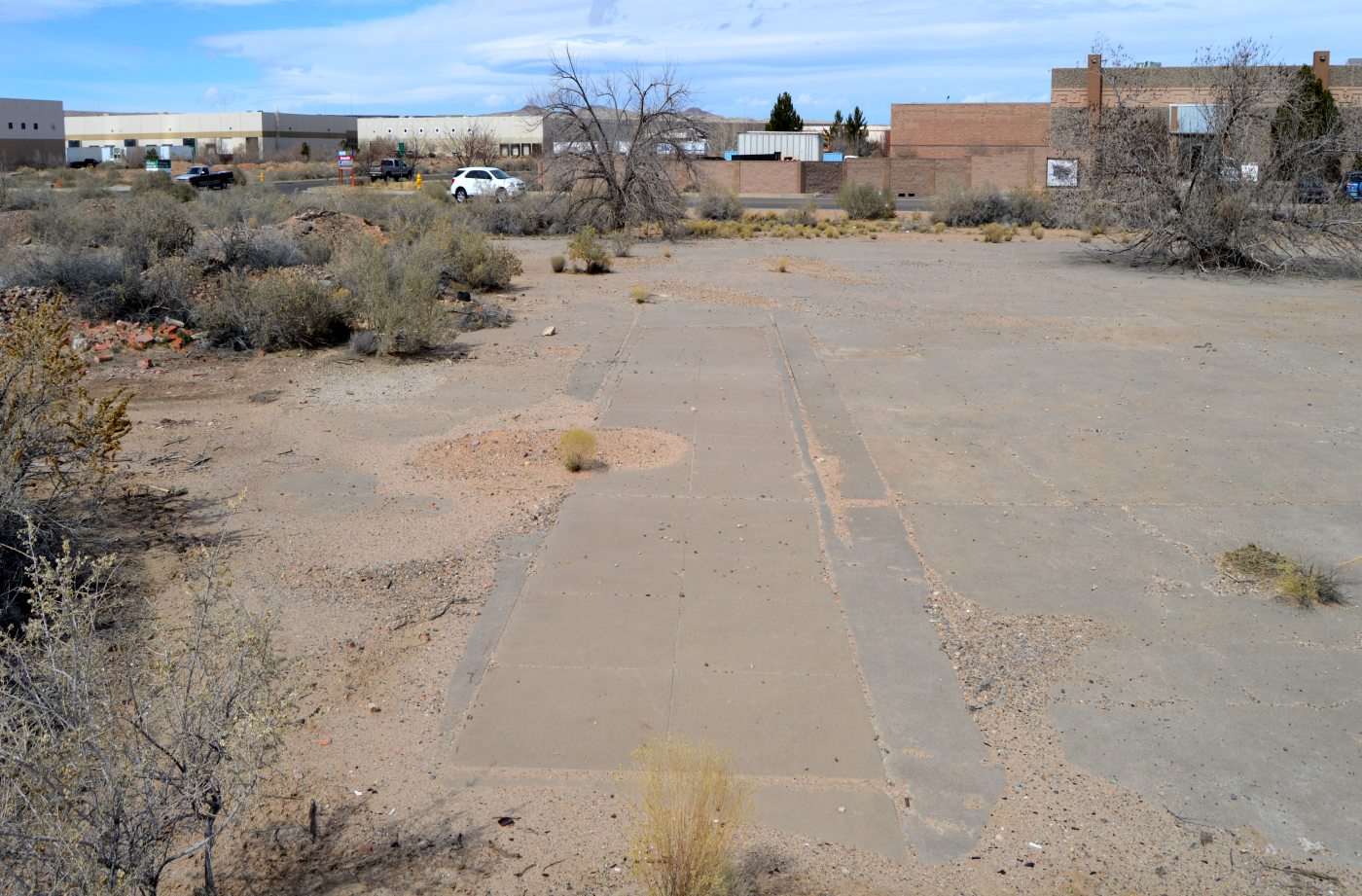
A 2/27/17 photo by Fred DeGuio of the remains of a foundation at “the site of the Western Air Express/West Mesa Airport terminal.”
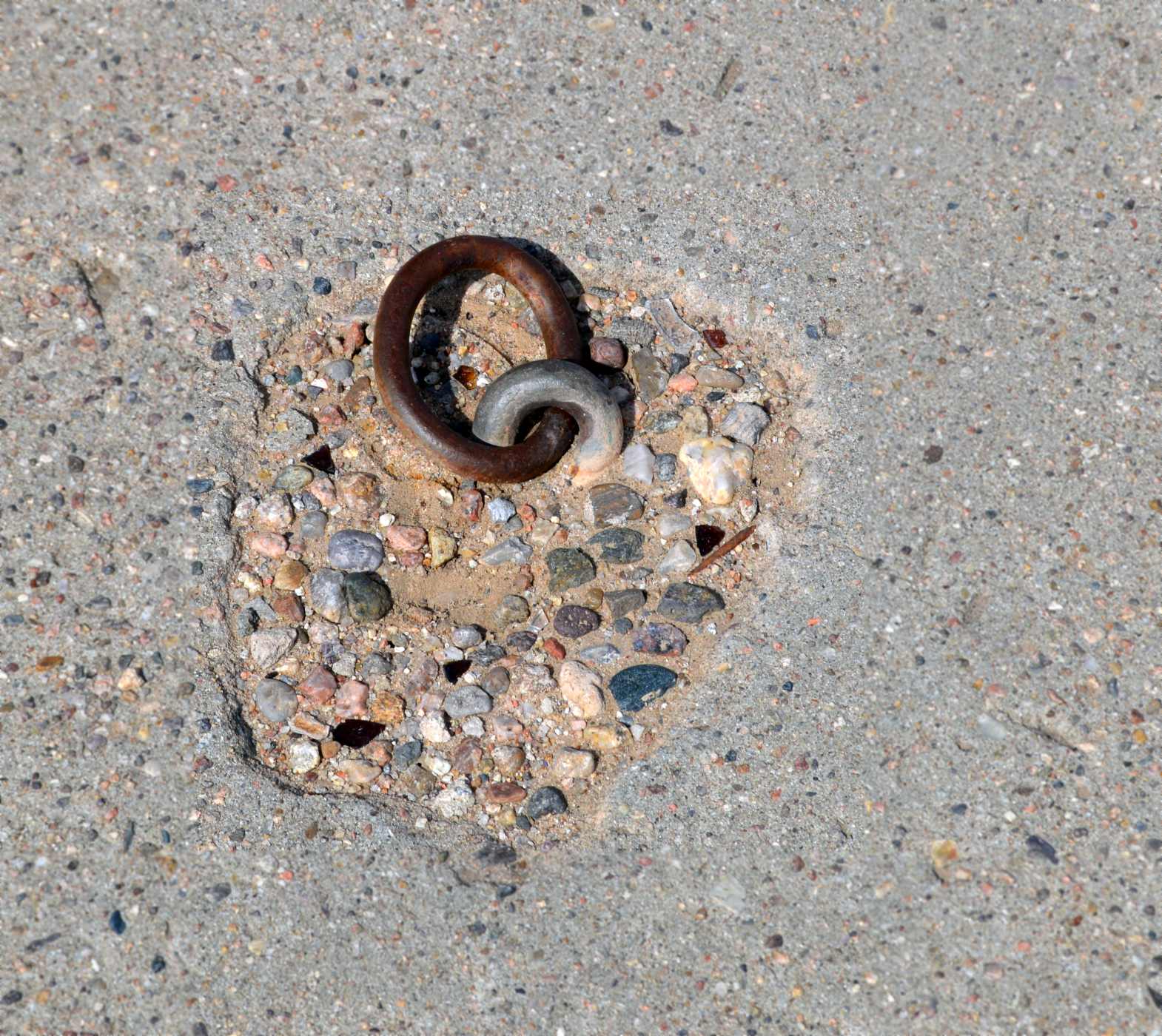
A 2/27/17 photo by Fred DeGuio of a 50-90 year old “aircraft tie-down ring at the end of the old canopy tracks.”
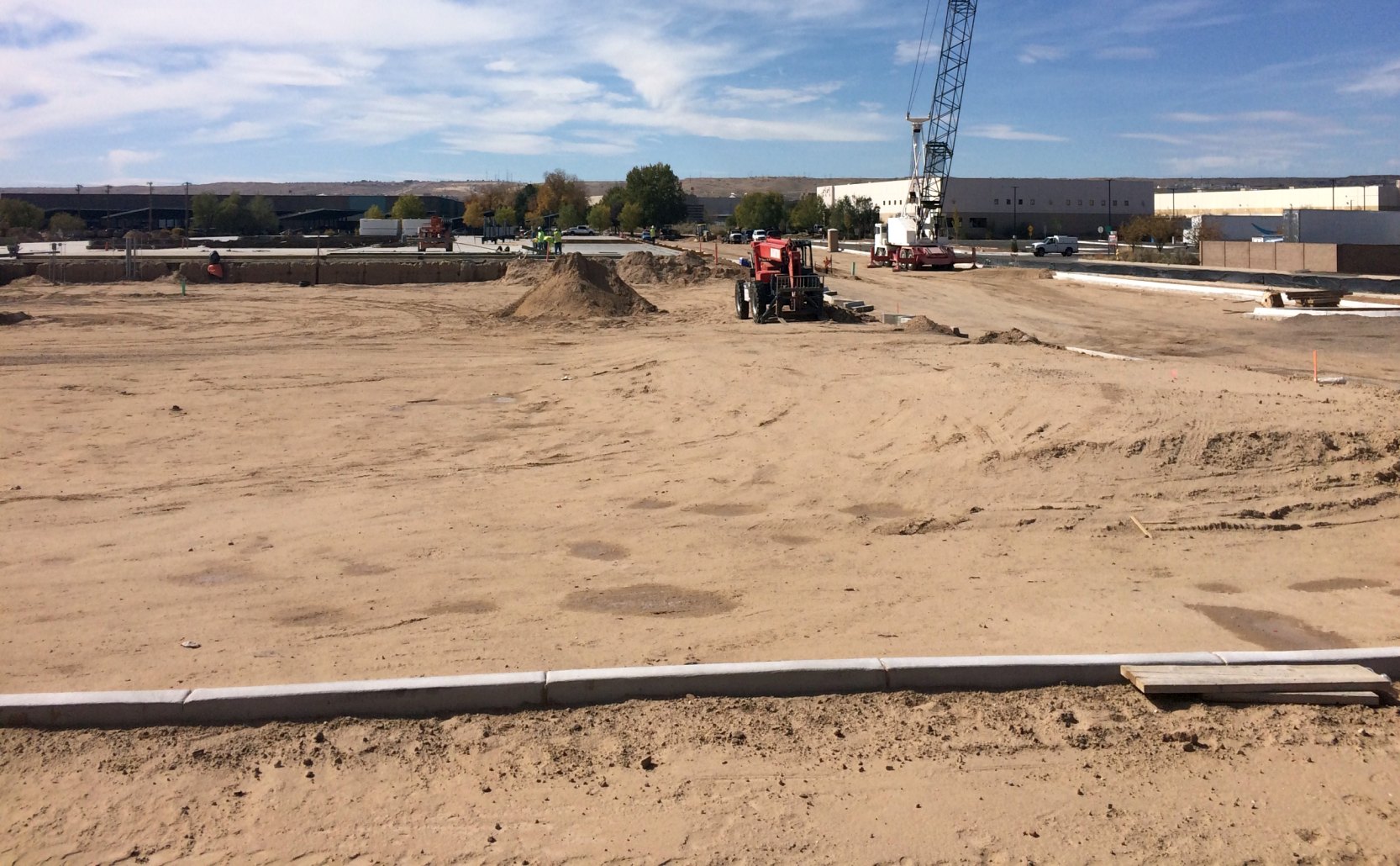
A 11/1/21 photo by Fred DeGuio, who reported, “I visited the site of the West Mesa Airport & the dreaded day has come.
The one small field that still contained remnants of the airport [pictured in the 2017 photos above] has now been plowed & a new industrial warehouse is under construction. A sad day.”
The site of West Mesa Drive is located north of the intersection of Los Volcanes Road NW & Airport Drive NW, appropriately enough.
______________________________________________________
Sandia Base Airfield, Albuquerque, NM
34.97, -106.49 (Southeast of Albuquerque International Airport, NM)

Sandia Base Airfield, as depicted on the 1967 USGS topo map.
Photo of the airfield while in use has not been located.
The Sandia National Laboratory dates back to 1945,
when the "Z Division" established as the ordnance design, testing, and assembly arm of Los Alamos National Laboratory.
For the past 40 years, Sandia has continued to conduct extensive research
in support of nuclear weapons programs & other national-security related projects.
A small airfield was located on the southeastern edge of the Sandia National Laboratory property
(the little Sandia Base Airfield is not to be confused with the much larger Kirtland AFB,
which is located only 7 miles to the northwest).
The date of establishment of the Sandia Base Airfield has not been determined.
It was not depicted at all on the 1962 Albuquerque Sectional Chart.
The earliest reference which has been located to the Sandia Base Airfield came from Ben Thurston,
who recalled, “Sandia Base... I did my initial Private Pilot's License training there, probably starting in 1963 or 1964.
I was in the Navy, but stationed at the University of NM on a Navy college program.
[The Sandia Base Airport] was run by a military flying club, so I had access by way of my Navy status.
I recall flying 2 versions of Piper Cubs - one without & one with flaps - perhaps PA-11s & PA-18s.
Depending on winds, this was in the lee of the Manzano Mountains, just to the east,
so on a gusty day it could be challenging to a new student in a lightweight plane with a big wing!
I also don't remember a cross runway - that may have come later.
So anyone who did initial training there in taildraggers has never had a problem with crosswind landings since!
Buy my most vivid memory is hand-propping a stiff engine on a cold NM morning (nearly 6,000' elevation).
One could definitely work up a sweat before it fired!”
Sandia Base Airfield was not yet depicted on the August 1967 Albuquerque Sectional Chart.
The earliest directory listing which has been located of the Sandia Base Airfield
was in the 1967 AOPA Airport Directory (courtesy of Chris Kennedy).
It described the "Sandia Base Airstrip" as a "Private airstrip closed to the public",
operated by the "Sandia Military Flying Club".
It was described as having 2 dirt runways: a 4,200 Runway 2/20 & a 3,800 Runway 8/26.
The earliest depiction which has been located of the Sandia Base Airfield was on the 1967 USGS topo map.
It depicted the Sandia Base Airfield as having 2 unpaved runways each with a parallel taxiway, and several small buildings on the south side.
The airfield was unlabeled, but the overall property was labeled “Kirtland AFB”.
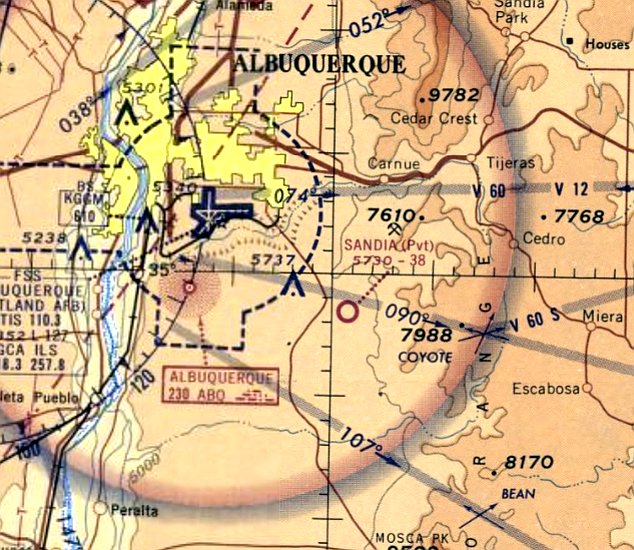
The earliest aeronautical chart depiction which has been located of Sandia Airfield was on the February 1968 Albuquerque Sectional Chart.
It depicted Sandia as a private airfield having a 3,800' unpaved runway.
"Sandia" Airfield was still depicted on the 1970 USGS topo map,
but this does not necessarily prove the airfield was still active at that point.
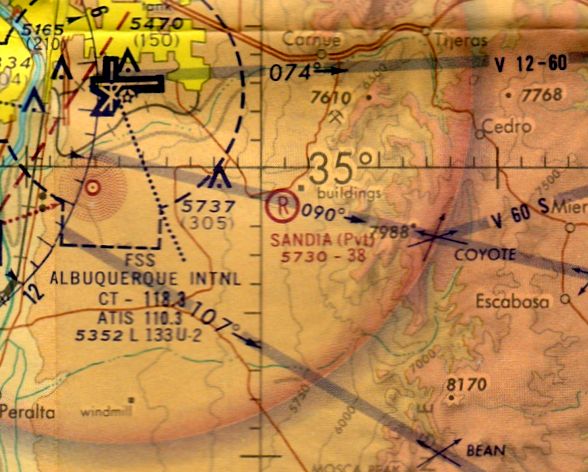
The last aeronautical chart depiction which has been located of Sandia Airfield
was on the December 1971 Albuquerque Sectional Chart (courtesy of Ron Plante).
It depicted Sandia as a private airfield having a 3,800' unpaved runway.
The Sandia Base Airfield was evidently abandoned at some point between 1971-75,
as it was no longer depicted on the October 1975 Albuquerque Sectional Chart,
and nothing at all (not even any runways) was depicted at the location on the 1975 or 1995 USGS topo maps.
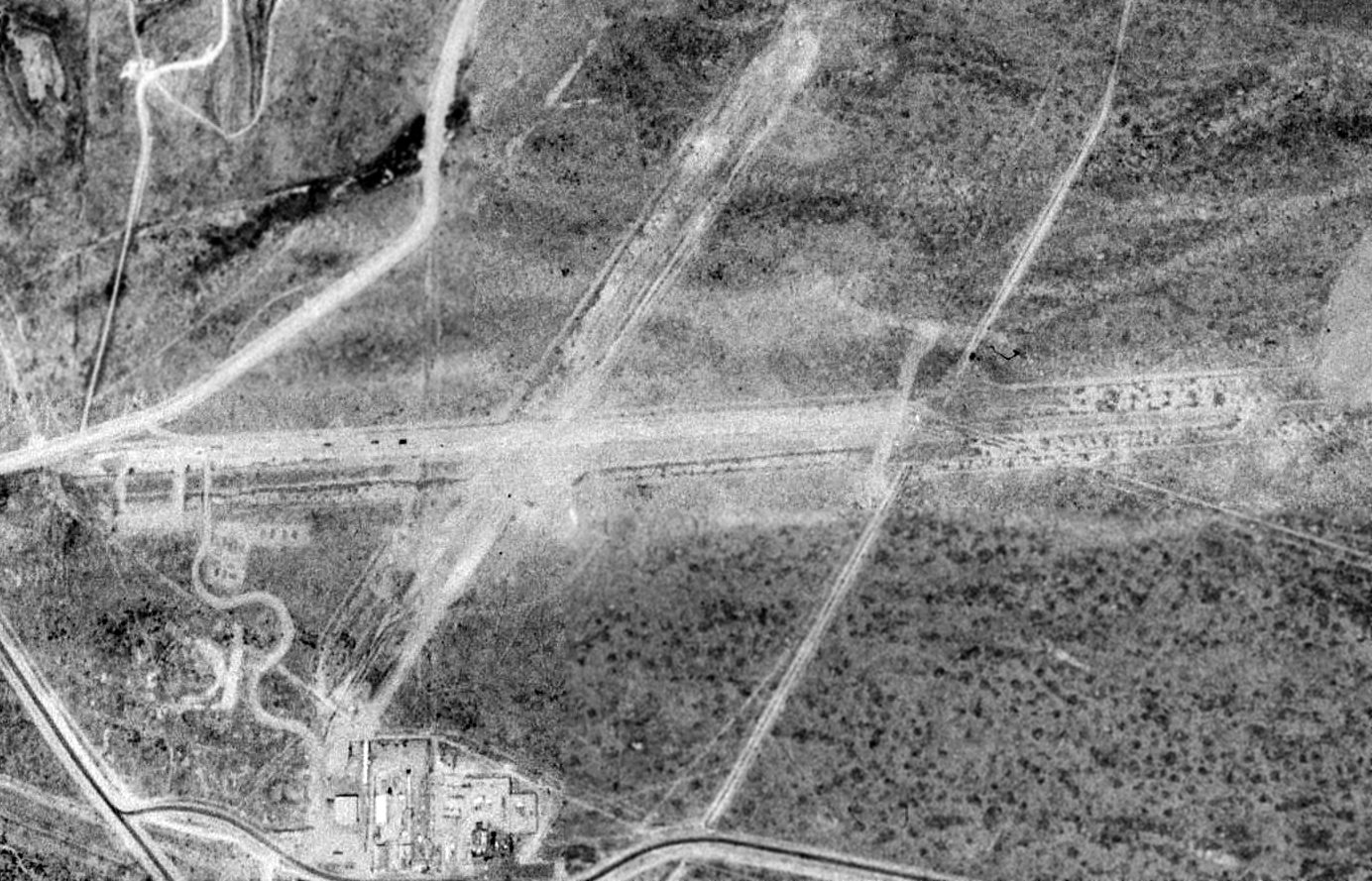
A 1991 USGS aerial view depicted the Sandia Base Airfield as having 2 unpaved runways each with a parallel taxiway, with the longest being a 5,000' east/west strip.
The east/west & northeast/southwest runways had parallel taxiways.
A large ramp is located at the southwest end of one runway, while a smaller ramp is located south of the west end of the primary runway.
A complex of buildings sits just south of the airfield, but this may have been unrelated to the airfield, constructed after the airfield had been abandoned.
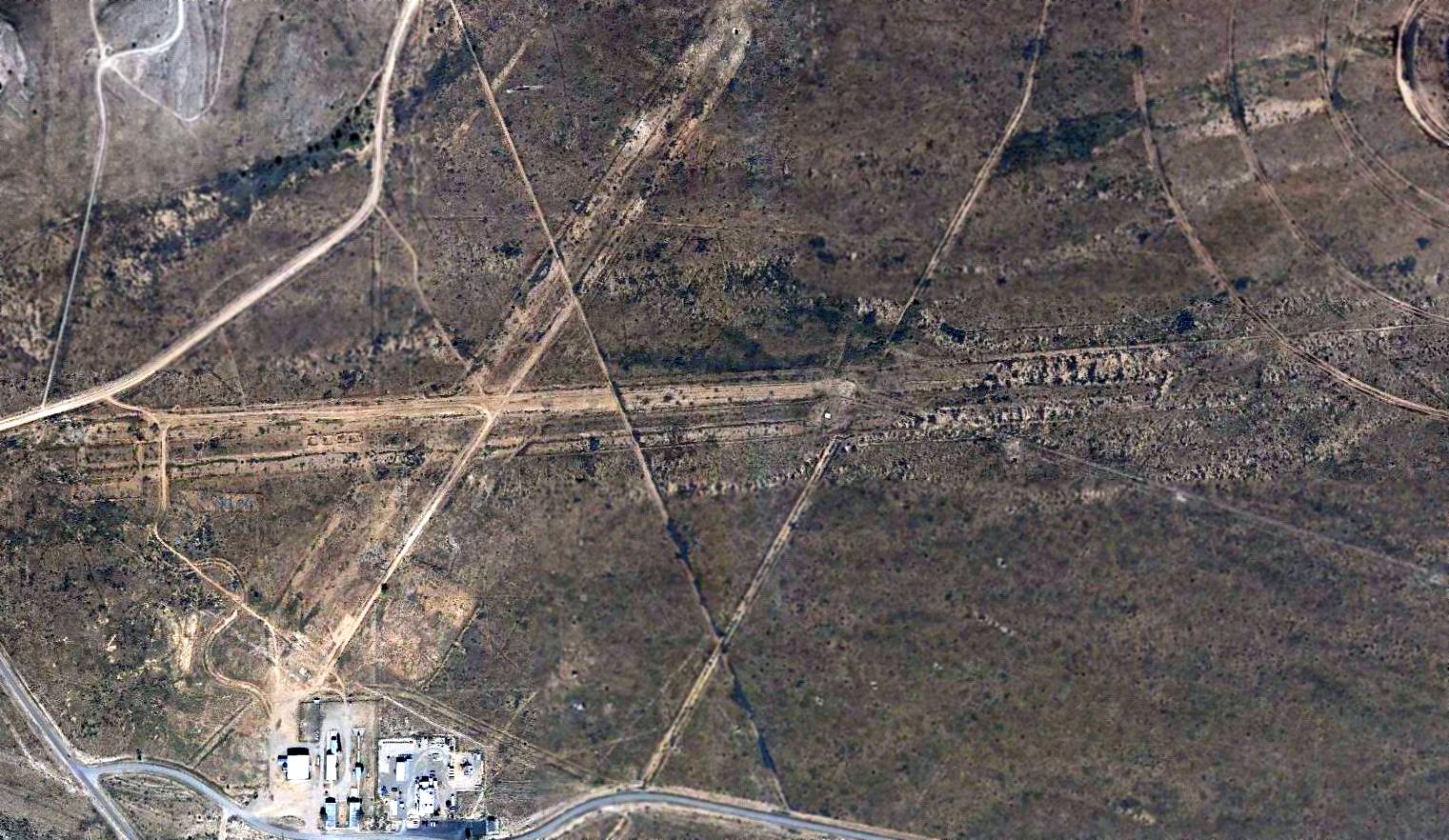
A 2015 aerial view depicted the Sandia Base Airfield as remaining intact though deteriorated.
Thanks to Chris Kennedy for pointing out this airfield.
______________________________________________________
Coronado Airport (4AC), Albuquerque, NM
35.2, -106.57 (North of Albuquerque International Airport, NM)
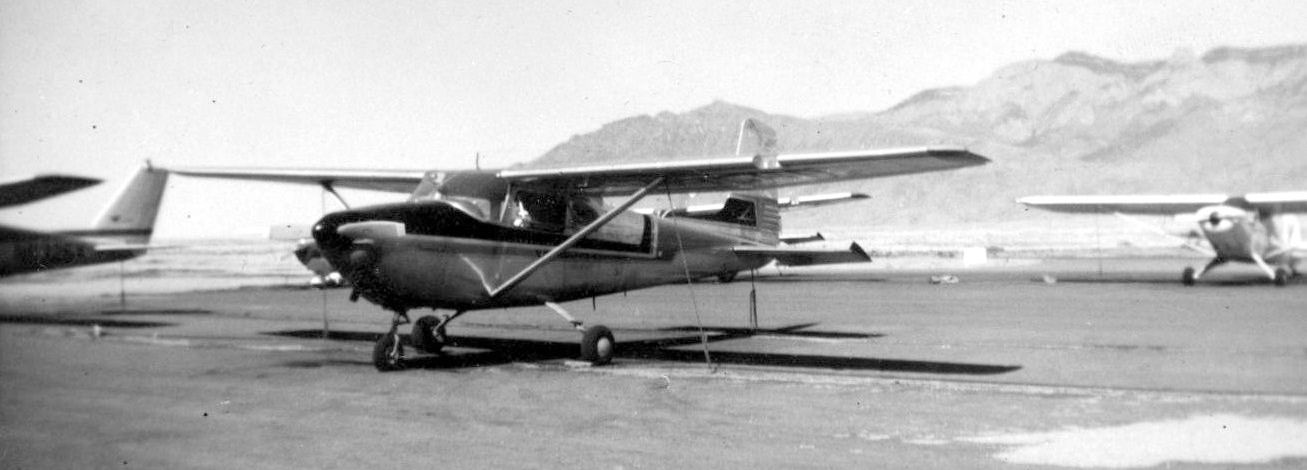
A 1962 photo by Robert Sylvester of his Cessna 182 N9956B at Coronado Airport's east tie-down area (courtesy of Barry Sylvester).
The abrupt & arbitrary closure of this vibrant general aviation airport in late 2001
is yet another example of the continuing disappearance of airports which serve the general aviation community.
This is a trend which must be fought.
No airfield was yet depicted at this location on the 1960 USGS topo map.
Coronado Airport was opened in 1961.
Dan McGrew recalled, “We were at opening day for Coronado Airport. I spent many hours there.
My other uncle, Bob Jansson, became a pilot too.
He got into aircraft sales & was active in it.
There was another pilot at Coronado, Dick Durand, who had a P-51.
Dick took me up in it once. Talk about a thrill!
One of my instructors use to have me take my Cessna 150 over to Coronado to do crosswind landing & take offs.
The winds against the base of the Sandias could be brutal.”
Barry Sylvester recalled, “My Dad, Robert Sylvester learned to fly at Coronado in 1961,
and based his Cessna 182s there from 1961 until he retired in 1982.
Over the years, we flew VFR all over the Country. On Holiday weekends, we would fly to Central Texas (Lake LBJ), landing on a little airstrip in the village of Granite Shoals.
There was a tie-down area on the East side of the main runway.
T-Hangar rental was $50/month, paved tie-downs were $15, and the East unpaved tie-downs were $10/Month.”
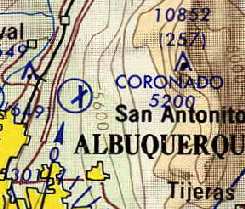
Coronado Airport, as depicted on the December 1962 USAF Operational Navigation Chart (courtesy of Chris Kennedy).
Coronado Airport was listed among active airports in the 1962 AOPA Airport Directory,
with 2 paved runways, and the operator listed as Southern Skyways.
Thomas van der Geld recalled, “I soloed in a Cessna 150 on the morning of my 16th birthday (in 1963) at Coronado.
I can still very vividly remember that morning as well as the preceding weeks with my flying instructor...
a great Texan named Jim Pollard who lived for flying.”
According to Diane Schaller (President, Historic Albuquerque Inc.), in 1965 Western Air moved from West Mesa Airport to Coronado Airport.
Dick Durand recalled, “Coronado Airport in the 1960s, my dad had his business there for a number of years.
During that time, we brought in many different airplanes: we had many Convair 240s, 340s, 440s, a few Vickers Viscounts,
a couple of Douglas A-26s, a Martin B-26, B-18 Bolo, many DC-3s, many Howard 250s, 350s, 500s, P-51s & so many more.
It’s amazing that most people I talk to just don’t believe we had these machines out at Coronado.”

The 1965 Albuquerque Sectional Chart (courtesy of John Price)
depicted Coronado Airport as having 2 paved runways, the longest being 4,200'.

A 9/20/67 USGS aerial view looking showed Coronado Airport having 3 paved runways,
and a large number of hangars & aircraft (including 4 Douglas DC-3s) on the northwest side.
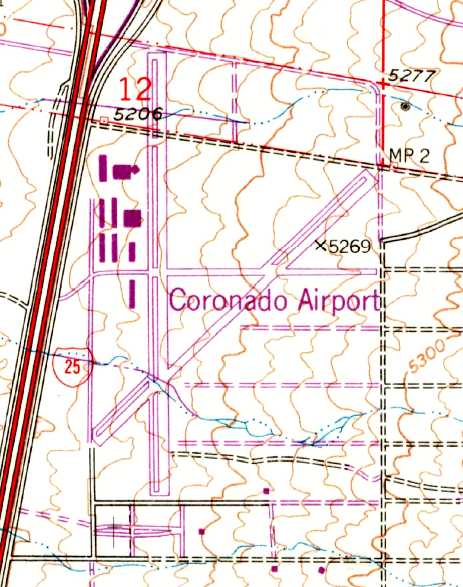
The 1967 USGS topo map depicted Coronado Airport as having 3 paved runways, 2 with parallel taxiways, and 9 hangars along the west side.
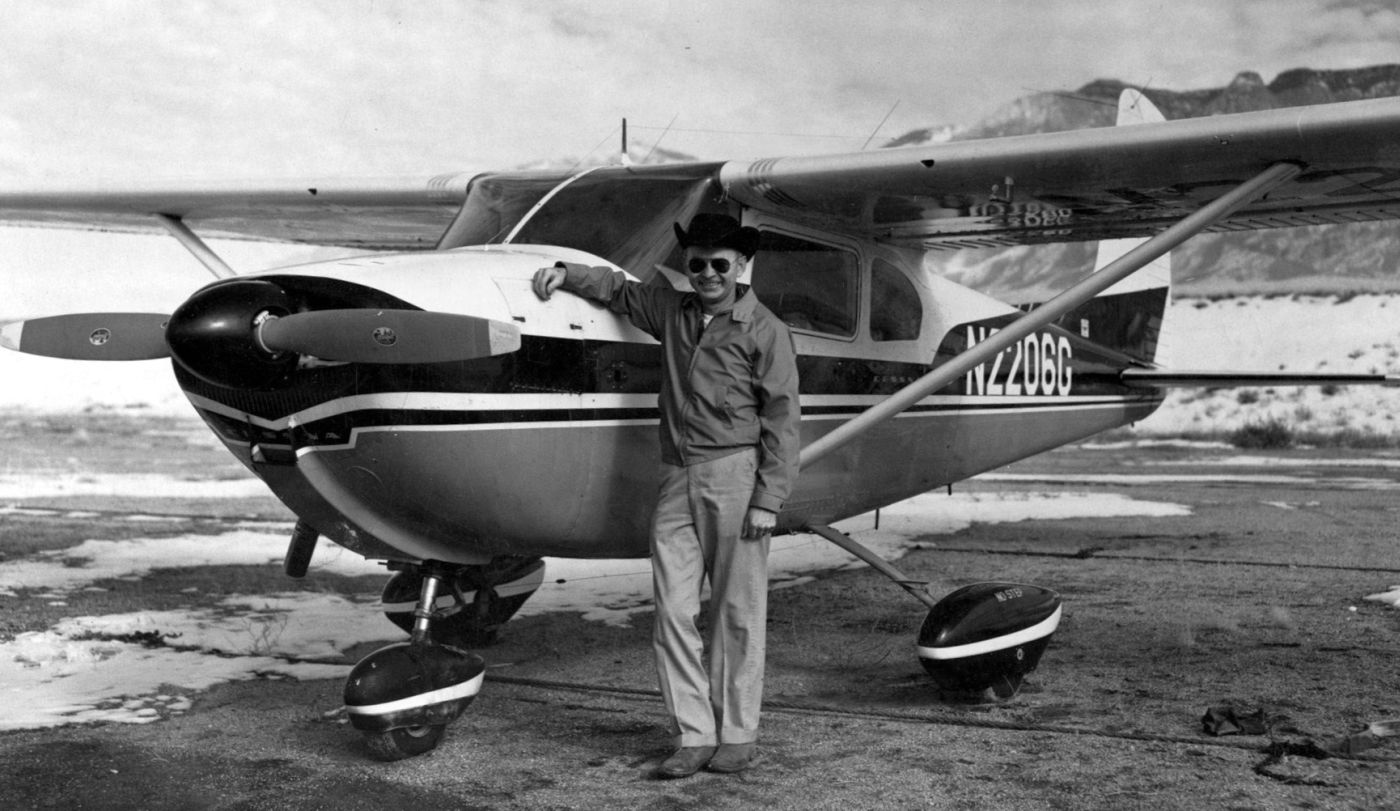
A 1967 photo of Robert Sylvester & his Cessna 182 N2206G at Coronado Airport's east tie-down area (courtesy of Barry Sylvester).
John Kern recalled, “I flew a great deal out of Coronado Airport.
The man at Coronado had a flight school with the old $5 Cessna rides & they also did lots of conversion of large old aircraft into business & corporate planes.
I spent many hours 'hangar flying' with the folks at Coronado.”
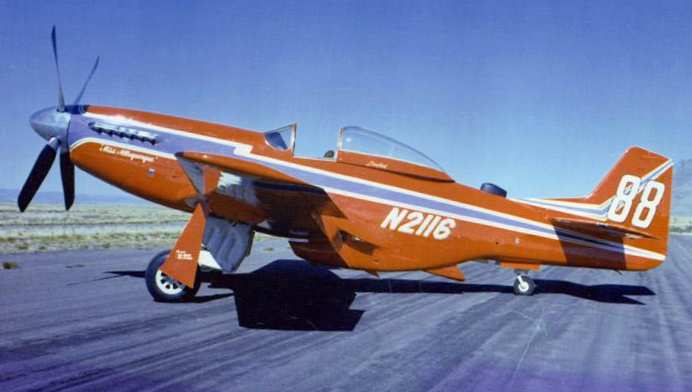
A 1970 photo courtesy of Dan Rhinehart of P-51 Mustang 'Miss Albuquerque' at Coronado Airport.
Dan Rhinehart recalled, "I'll never forget being about 4 years old & going to Coronado
and getting there in time to see my dad & a friend of his land in a bright red P-51, 'Miss Albuquerque'.
Coronado was one of these places that just never changed
and it looked the exact same way that it did the 1st time I ever remembered going there (about 1970)
as well as the last time I was there while the airport was still open (1999).”

An October 1971 aerial photo from the 1971 NM Airport System Plan (courtesy of William Fitzpatrick) depicted Coronado Airport as having 2 active paved runways, along with a former 3rd paved runway.
William Fitzpatrick noted, “This is interesting, it looks like the plan & design was going to call for a parallel runway at this time [a 6,760' north/south runway to the east].
That never came to fruition. ”

An August 1973 photo by Dan Rhinehart “at Coronado Airport... a picture of a scale control-line model of my dad's 1936 Rose Parrakeet built by John Anderson
who was a local dentist & jack-of-all-trades & master of all trades! The orange Luscombe belonged to John Anderson.”
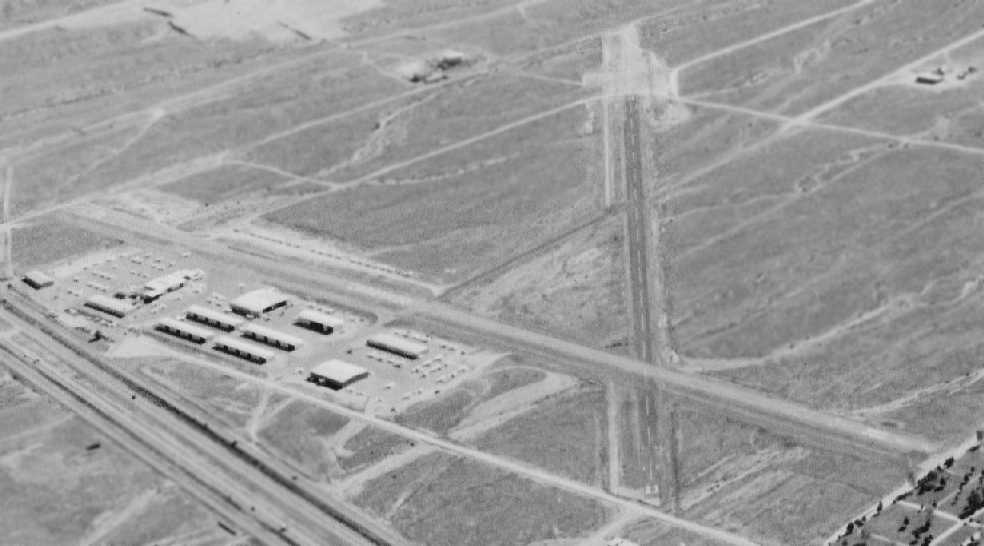
An undated aerial view looking northeast at Coronado (courtesy of Dana Patton).

A 1974-79 photo by Larry Nussbaumer looking north-northwest at “Schweizer 2-32 N5826V sitting on the dirt overrun just northeast of Coronado's Runway 21 numbers, with the Jemez Mountains in the background, and owner Mike Keller sitting on the wing.”
Larry Nussbaumer recalled, “From 1974 through mid-1977 Pegasus Aerial Sports operated two sailplanes on Saturday, Sunday and Wednesday from 0900 to about 1700 each day.
We sold rides & gave instruction operating from the dirt overrun of Runway 3, using Runway 21 (slanting a bit downhill) for departure & either Runway 3 or 21 for landing, depending on winds.”

A 1974-79 photo by Larry Nussbaumer looking northeast at “Schweizer 2-32 N5826V sitting on the dirt overrun just northeast of Coronado's Runway 21 numbers, with Sandia Mountain in the background, and owner Mike Keller holding up the wing.”
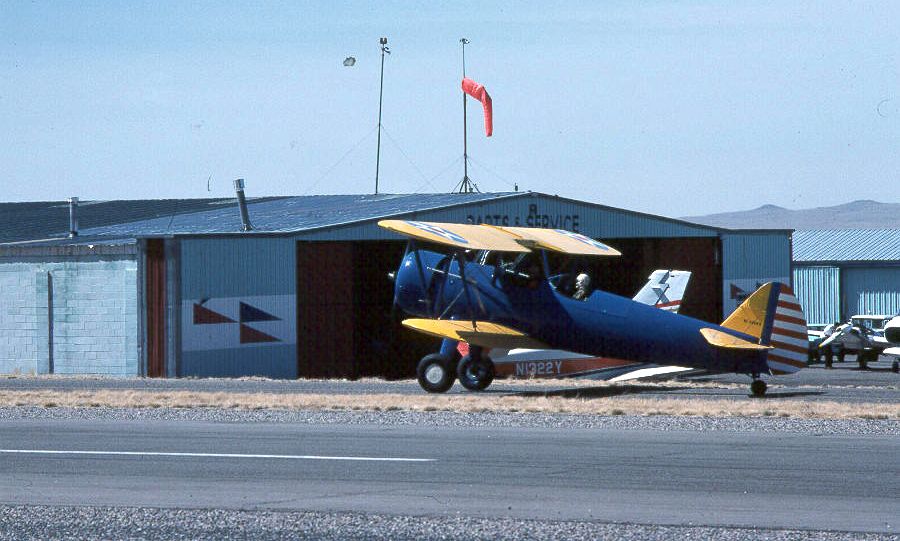
A 1974-79 photo by Larry Nussbaumer of “Bruce Benton taxiing south on Coronado's parallel taxiway to Runway 35 for takeoff on the first flight after restoration.
Note the windsock, weathervane, and lights on the hangar.”
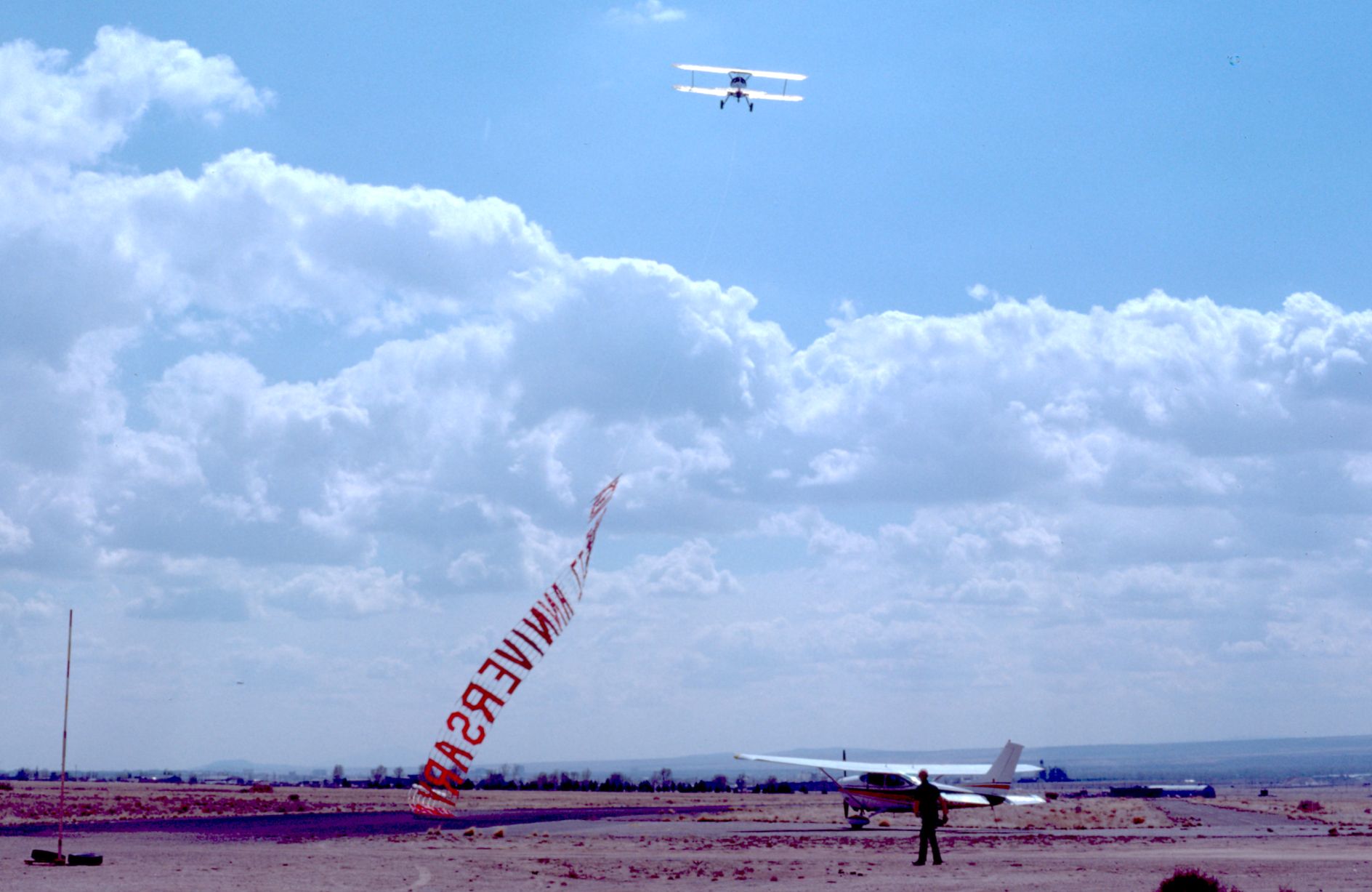
A 1974-79 photo by Larry Nussbaumer of “Stearman N4408N picking up a banner” at Coronado Airport.
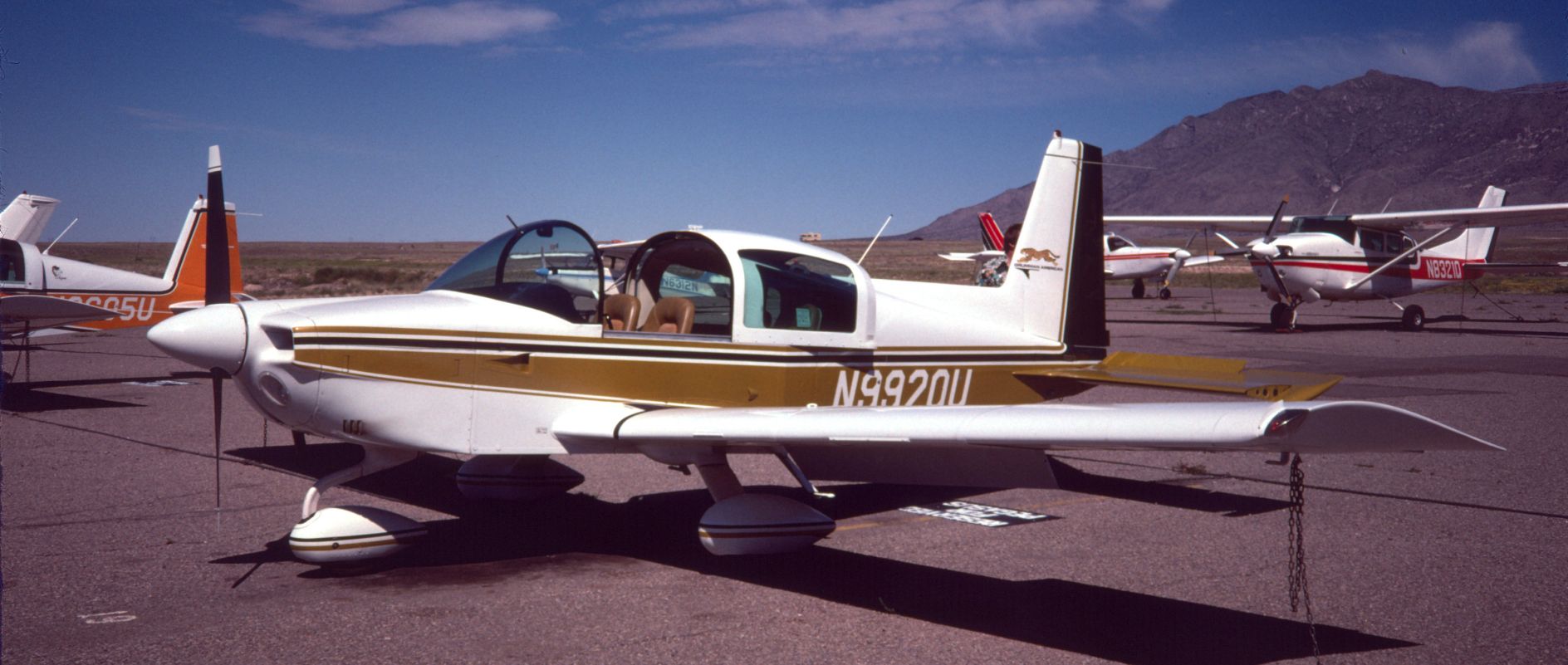
A 1974-79 photo by Larry Nussbaumer of a Grumman Cheetah at Coronado Airport.
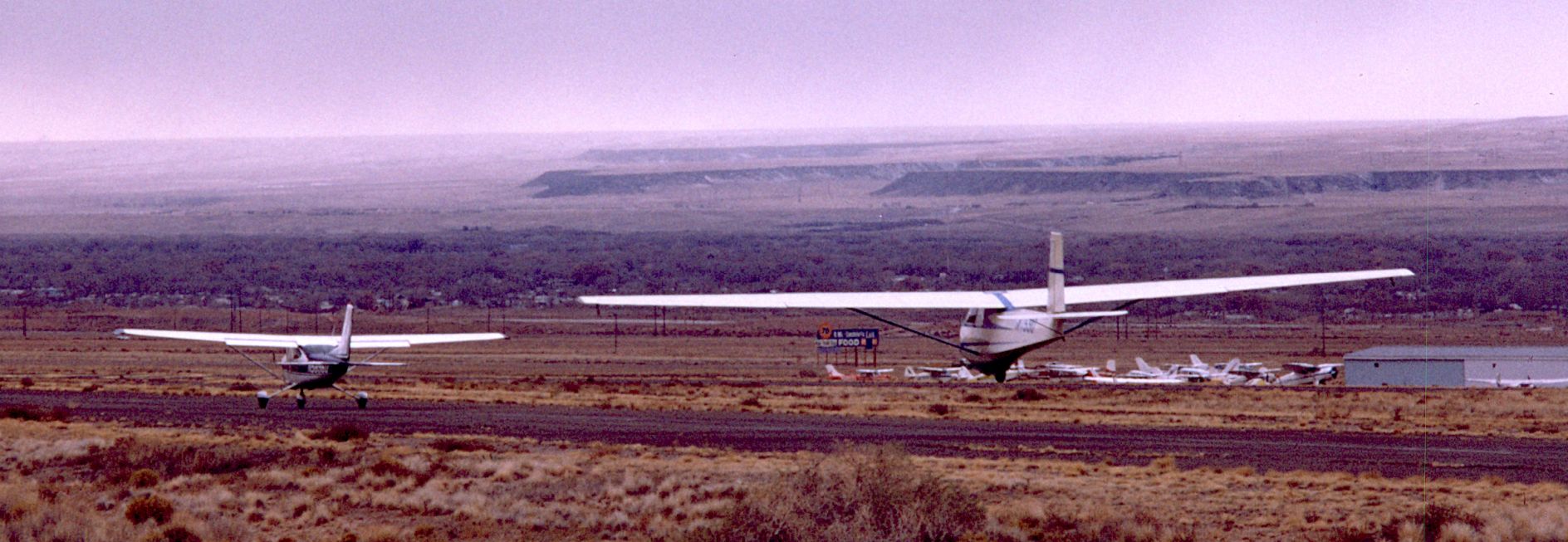
A 1974-79 photo by Larry Nussbaumer at Coronado Airport of a “Cessna 182 towing Pegasus' SGS2-33 sailplane down Runway 21”.
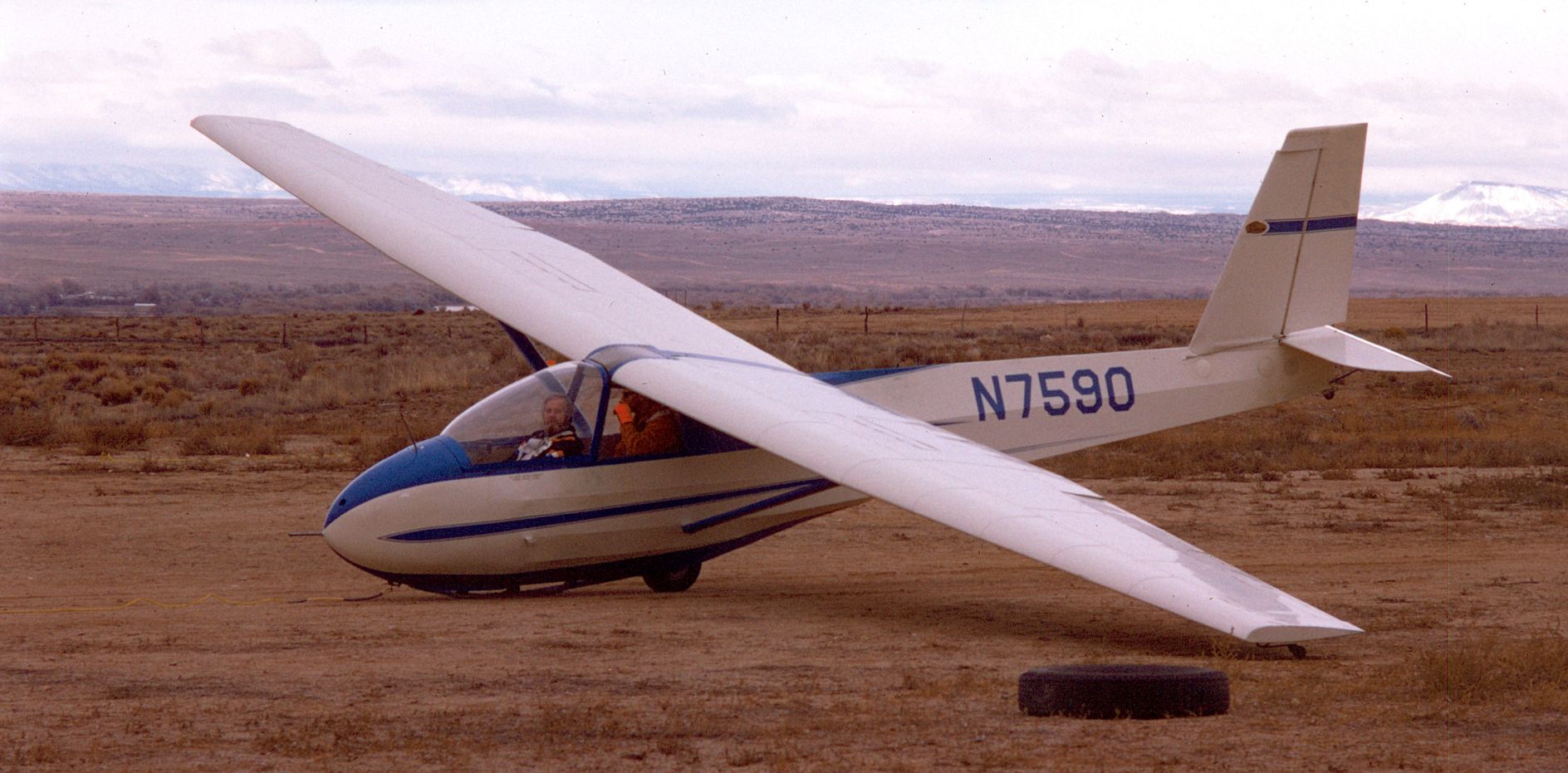
A 1974-79 photo by Larry Nussbaumer at Coronado Airport of “Pegasus 2-33 on the dirt underrun of Runway 21. The tire is to hold a wing down when wind picks up.”
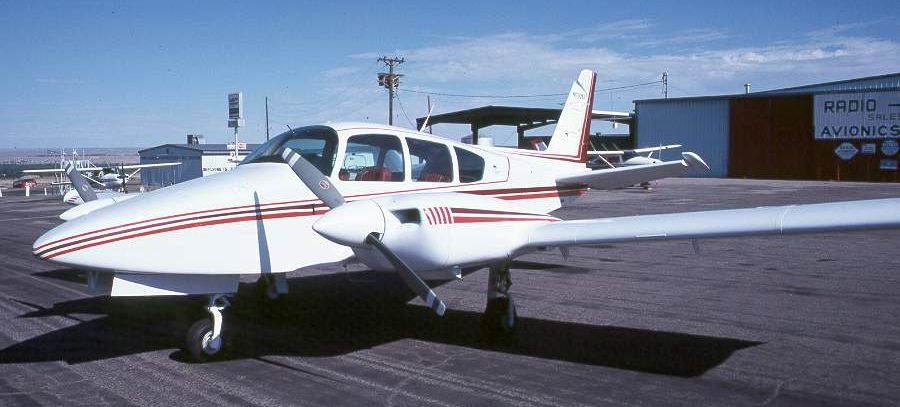
A 1974-79 photo by Larry Nussbaumer of a “Grumman American twin GA-7 Cougar on Coronado's washrack, and the large hangar at right.”

A 1974-79 photo by Larry Nussbaumer of a “Grumman American twin GA-7 Cougar departing Coronado's Runway 35 with several hangars in the background.”
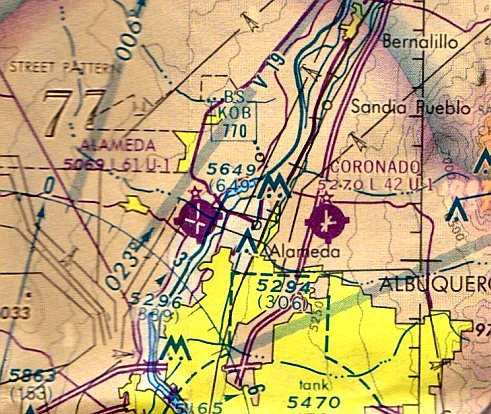
The October 1975 Albuquerque Sectional Chart depicted Coronado Airport as having 3 paved runways, with the longest being 4,200'.
Larry Nussbaumer recalled, “I flew for Coronado Flying Service & Pegasus Aerial Sports (gliders, Stearman, etc.)
out of Coronado throughout the 1970s.”

A May 1978 photo by Larry Nussbaumer of a Coronado Airport open house.
Barry Sylvester recalled, “I was a member of the Icarus Sport Parachute Club in Albuquerque from 1978-82.
Our aircraft were based at Coronado (2 Cessna 180s & a 206).”
Dan Ashworth recalled, “I flew out of Coronado for many years but mostly in the 1980s.
For a while, this was Albuquerque's reliever airport for ABQ International.
By 1985 the runways at Double Eagle on the West Mesa were completed & we began to realize that Coronado would close at some point but nobody seemed to know exactly when.
Coronado was really convenient to the northeast heights of Albuquerque & Double Eagle was a long drive on the west side. Most of us didn't care to drive that far.”
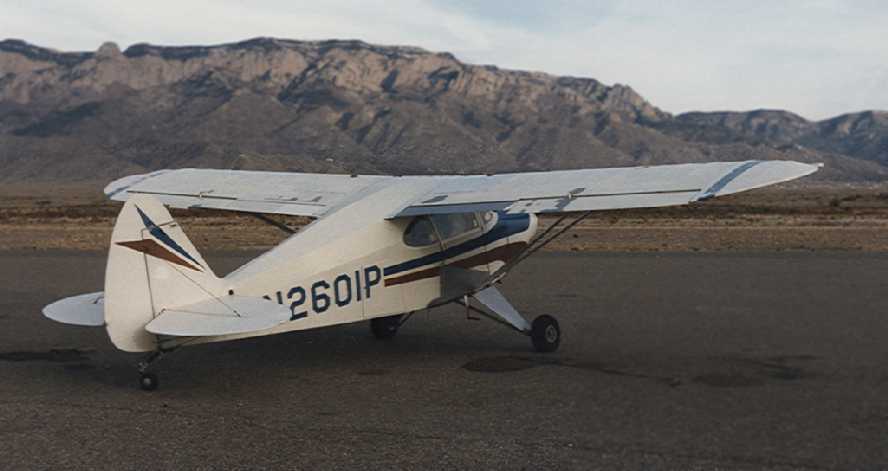
A January 1986 photo by Steve Schmidt of his Piper Tripacer at Coronado.
Steve recalled, “I took this photo of my plane on the ramp directly in front of the offices (FBO terminal).
I had recently completed a taildragger conversion to the former Tri-Pacer.
Note the incredible view that Coronado airport had of the Sandia mountains on the east side of Albuquerque.
Coronado was a great place to sit & enjoy a great sunrise & sunset - sad to see that the sun has truly set on 4AC.”
Steve Schmidt recalled of Coronado Airport, “I had my Piper Pacer hangared there for several years in the 1980s.
Coronado was like others stated already - a place that really never changed.
The desert just kept it looking just as it was, regardless of what year you were there.
Runway 17/35 was 4,100' long, but also just 45' wide.
With the field elevation of 5,270', the small little runway ate a few 'lower elevation' fliers
when they came in to 4AC to take on fuel, rather than go into Albuquerque International.
I saw 2 aircraft personally that tried to push a full-weight, full-fuel takeoff on a hot day
and ended up in the cemetery at the south end of the runway.”
Steve continued, “The airport had a vibrant community in the 1980s, with ultralights, EAA, antiquers
and even warbirds all mixing with the business aircraft that came & went.
There always seemed to be something in the pattern, shooting touch-n-go's.”

A January 1986 photo by Steve Schmidt of a Partenavia on amphibious floats (a very rare bird) at Coronado.
Steve recalled, “This Partenavia spent some time at Coronado in 1986.
It is parked in front of the large maintenance hangar that the FBO operated from on the north end of the field.
I recall that a company in NM called DeVore Aviation might have been doing something with the plane, but I really never learned why it was at Coronado.
I do recall that many of us had wondered if it could actually fly!
It did, though I personally did not see it depart.
For months it was there, then, gone. I sure would have like to have seen that takeoff!”

A May 1986 photo by Steve Schmidt looking southwest at of a Noordyun Norseman taking off from Coronado.
Steve recalled, “This Noordyun was restored at Coronado by a pair of enthusiasts over a couple years in the 1980s.
The plane was in D-Day markings, and left New Mexico in the late 1980s to first be in a Galveston museum, now it is back doing bush work in Canada.
Note the trees in the background; these designate where the cemetery is at the south end of the field.”
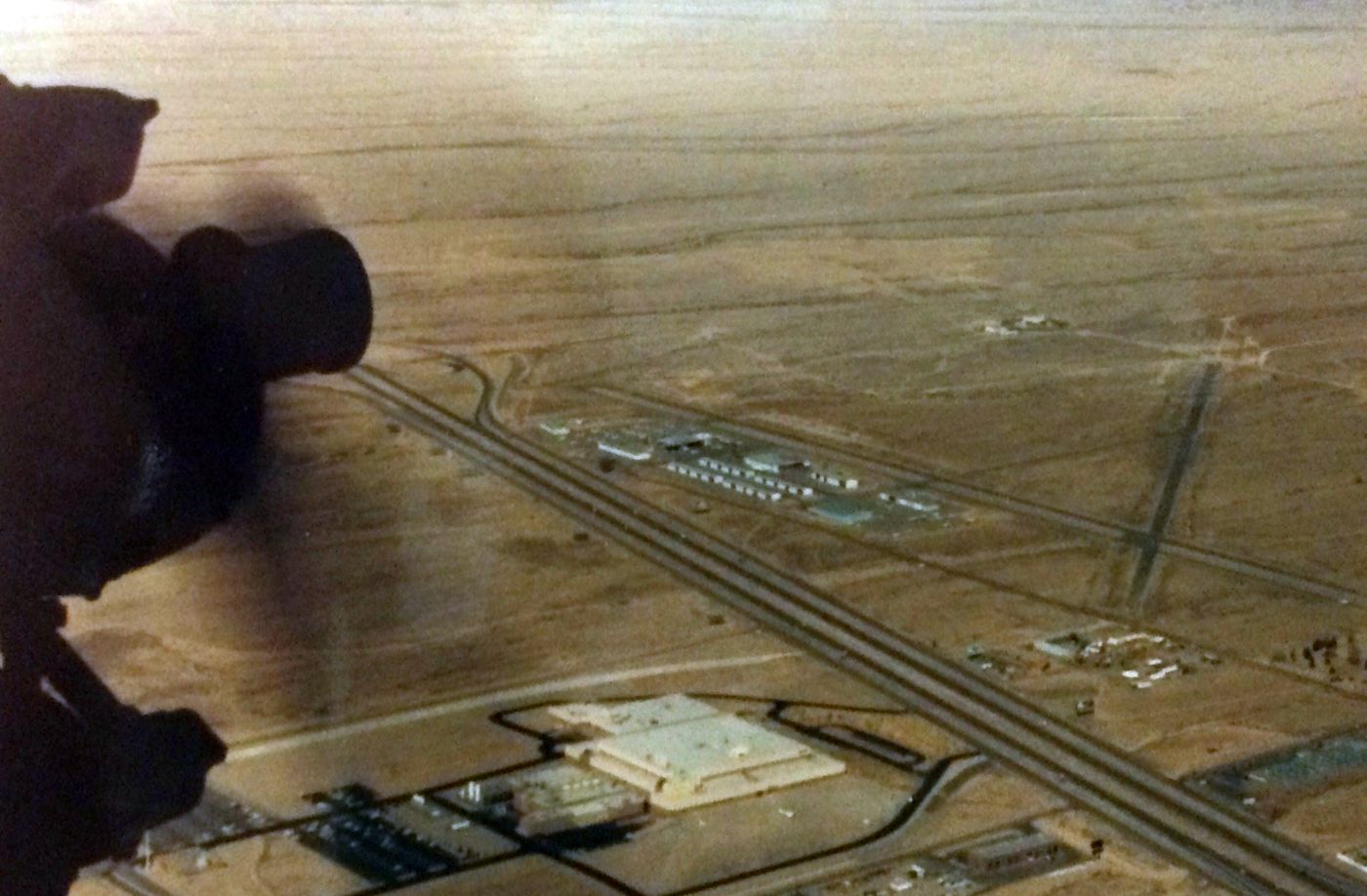
A 2/20/88 aerial view by Steve Schmidt looking northeast at Coronado Airport.
Steve recalled, “The photo was taken out of a left side window of a Ford Trimotor (N414H) as we were on an hour flight over Albuquerque.
Two old-timers, 4AC & N414H. Unfortunately only N414H continues to thrive.
Coronado was a special place for me when I lived in ABQ & had my aircraft hangared there.”
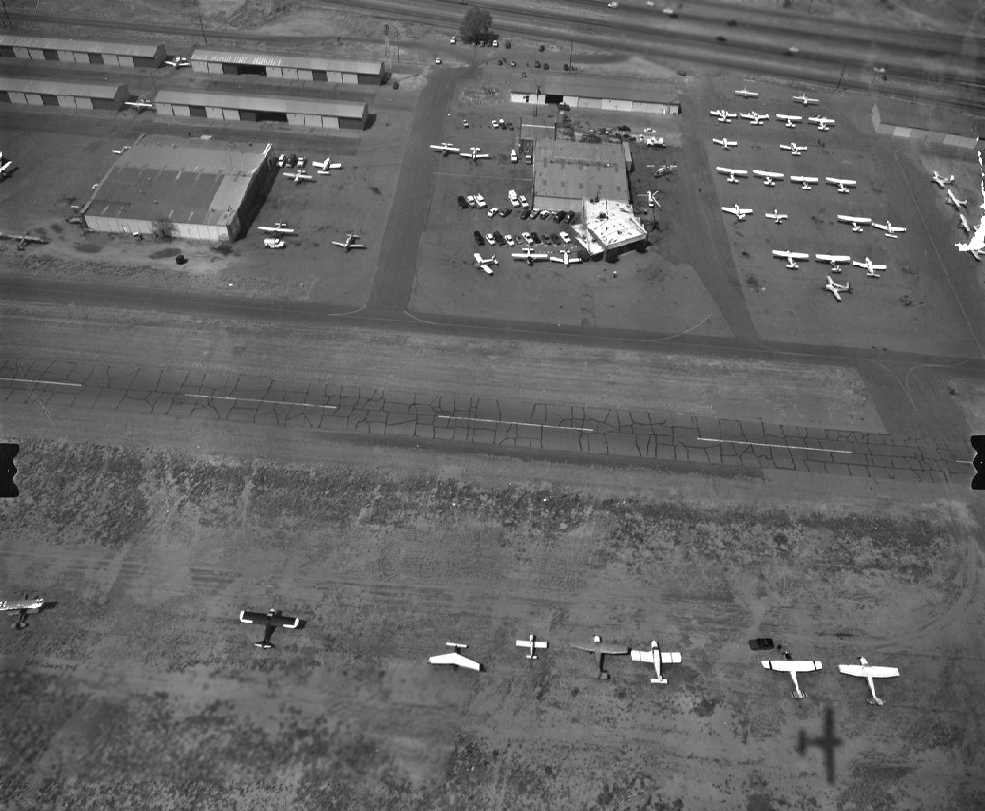
An undated aerial view looking west at a Coronado Airport ramp filled with light aircraft (courtesy of Dana Patton).

An October 1991 photo by Jane Fagan (courtesy of Dave Fagan) of a "most unusual aircraft marshaller" at Coronado Airport,
taken "during the Albuquerque Balloon Festival -
so the airfield was very busy with a large number of visiting aircraft."
Unfortunately, Coronado was privately owned, not a municipal facility.
This left it vulnerable to purchase by those who would desire to use the property for other purposes.
The airport was purchased in 1994 by the “Sandia Business Development Corporation”.
It later became evident that the sole shareholder of this Corporation was the local Indian tribe, the Pueblo of Sandia.
Brady Butterfield recalled, “I soloed on my 17th birthday at Coronado on 9/5/96. I loved that little airport.
The people there were really good folks, they were very helpful & had some good ol’ flying stories.
The airport was perfect for a new pilot flying a Cessna 172 with that very narrow runway.
I will always remember turning onto final & then coming down through the trees in the cemetery to meet the end of the runway.
I remember those big pines being just off the wingtips before touch down on my short field practices. N733HF was a great little plane.
My future wife & I used to sneak out onto the runway in the middle of the night and lay on the runway centerline.
I’m not really sure why, but it sure was fun.”

A circa 2000 aerial photo of Coronado Airport, shortly before it was closed.
Note the blimp moored in the center of the photo.

The last aeronautical chart depiction which has been located of Coronado Airport was on a 2000 NM Aeronautical Chart (courtesy of Aaron S.).
Coronado was depicted as having 2 paved runways, with the longest being 4,000'.
Aaron S. recalled, “I flew briefly out of 4AC in July of 2001 to get my complex endorsement in a PA28R200 Piper Arrow at Akin Air, from Cordell Akin himself.
Hard to believe that was only a few months before it closed.”
Coronado was last listed in the Airport Facility Directory in 2001.
The airfield consisted of 2 paved runways (the primary runway, 17/35, was 4,100' long), taxiways, a ramp, and 12 hangars.
A total of 131 aircraft were listed as being based at the field,
and the airport was listed as having an average of 237 aircraft operations per day.
Business at Coronado included an FBO, Skycraft, a flight school, Akin Air, and a pilot shop, ABQ Pilot Shop.

The last photo which has been located showing aircraft at Coronado Airport
was a 10/9/01 photo by Bill Teasdale of a Cessna 182 & several other aircraft in front of the FBO office.
The Indian tribe which had purchased the airport property
proceeded to build a large casino just off the end of Coronado's Runway 17,
which would seem to any reasonable person to be an incompatible use for the property.
The tribe obviously had other plans.
In late 2001, in a press release entitled "Safety Forces Closure Of Coronado Airport",
the tribe announced they were closing the airport.
The fact the airport preceded the casino by 40 years did not seem to matter,
and was certainly not mentioned in a press release in which the tribe stated that "the public's safety is our priority."
It also didn't matter that the airport was a vibrant economic entity, with 3 active businesses,
or that it was well used, with over 100 aircraft based on the field.
Contractors were sent to paint yellow closed-runway Xs on the runways & taxiways,
the airport businesses were evicted,
and over 100 aircraft were forced to relocate.
That left the entire Albuquerque metropolitan area with just one general aviation airport, Double Eagle II.

A poignant 2003 view by Dan Rhinehart of the former office of Coronado Airport.

A 2003 photo by Dan Rhinehart of the hangar which remains at the former Coronado Airport.
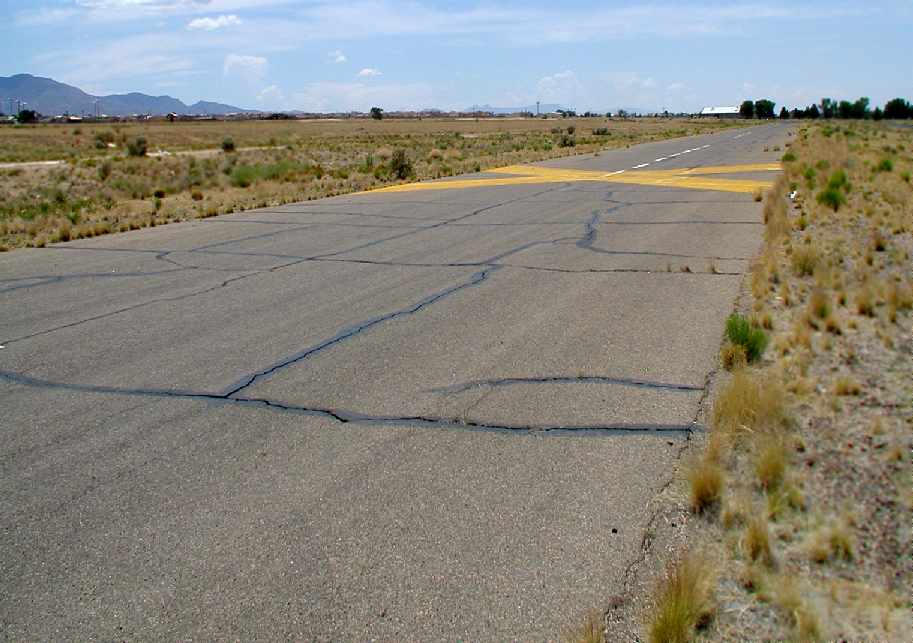
A 2003 photo by Dan Rhinehart of a former Coronado runway.
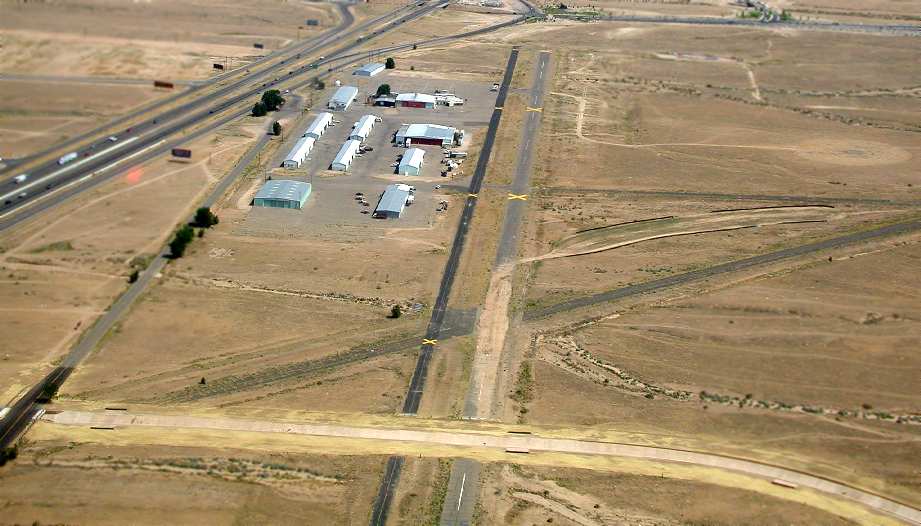
A fine 2003 aerial view by Dan Rhinehart looking north at the sad remains of the former Coronado Airport.
Dan observed, “If you look to the one end of the runway you can see that it now has a drainage ditch running through it.
The Indians used the need to run a drainage ditch across the runway as an excuse to close the airport.
The local pilots association pointed out that they could close the runway for a few days & run a piece of pipe under the runway with minimal cost.
But as we all know the drainage ditch was just an excuse to close the airport.
I was talking to a local pilot about this and he explained that the airport was on property adjacent to the Sandia Reservation & even though this land could never be annexed by the tribe.
It appears that Coronado Airport had hazardous waste contamination on the property
and that it was not worth a lot due to that and the fact that it's in an area of town that's predominately automotive salvage yards....etc.
The one thing that the Sandia Tribe had going for it that no other buyer did
was that they could sucker the federal government into paying to clean up the land no matter the cost.
I took a lot of pictures there in that I can only imagine that it will be fading into the desert soon & all that will be left is a few old pictures."
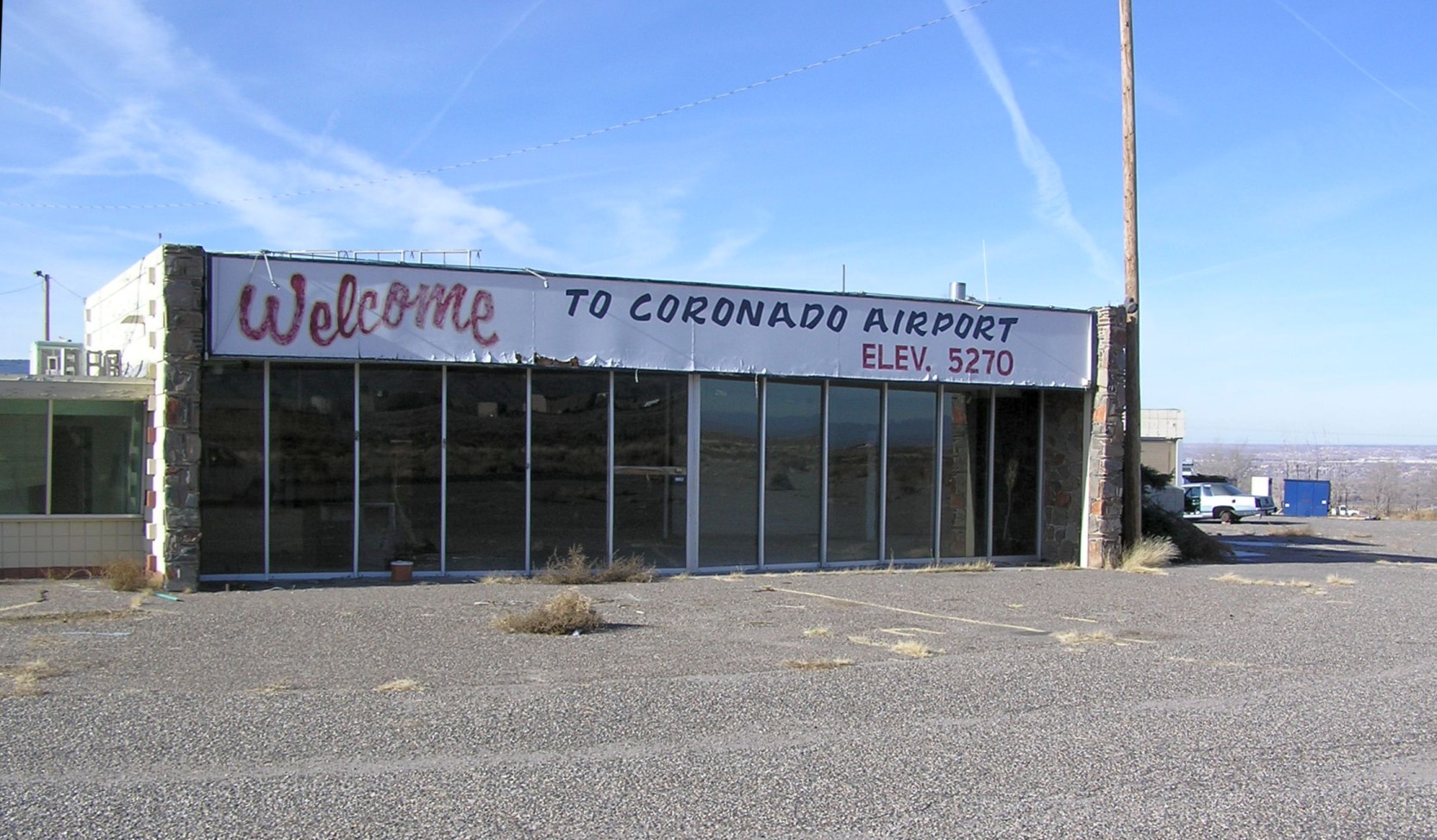
A 2004 photo by Dan Ashworth of the former office of Coronado Airport.
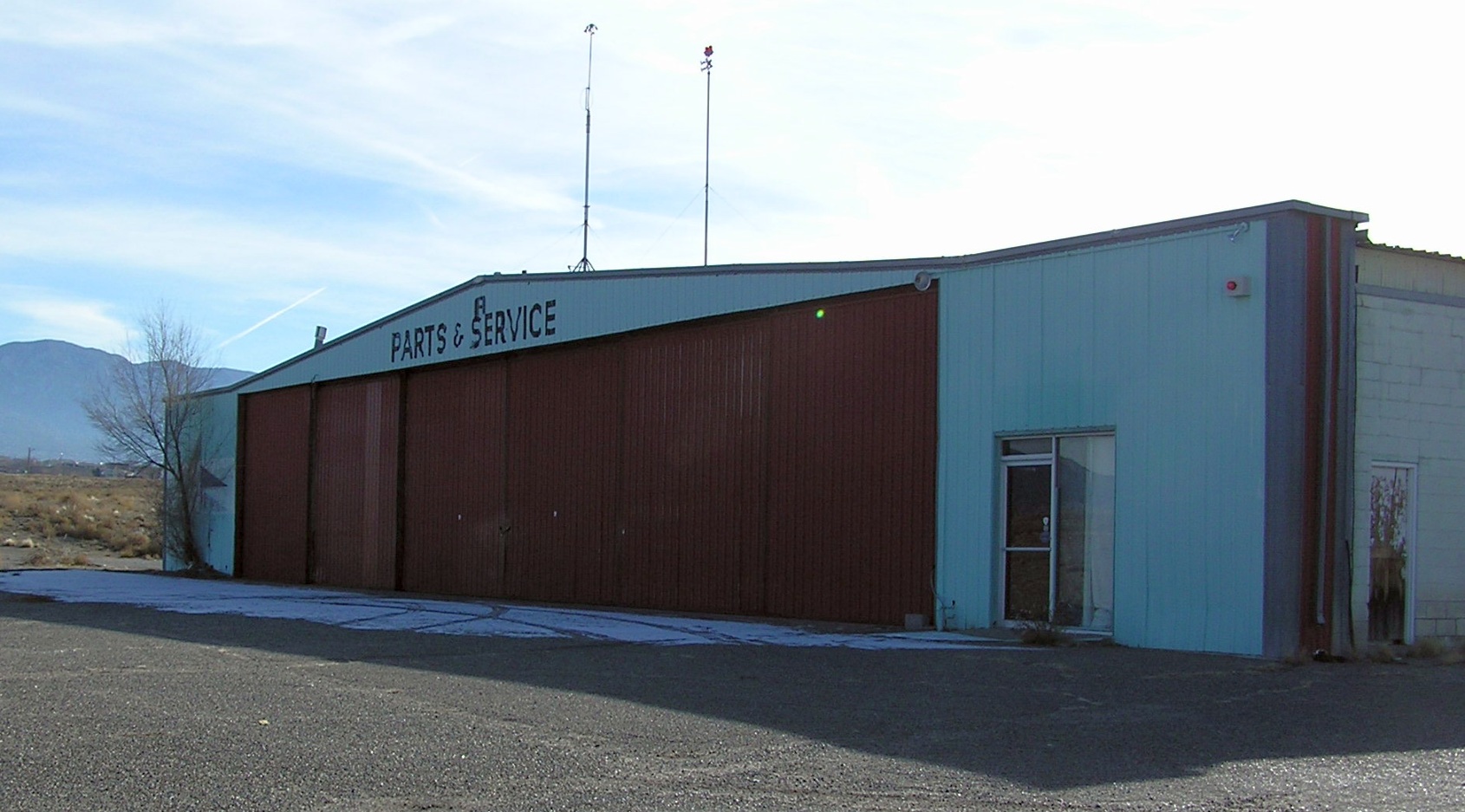
A 2004 photo by Dan Ashworth of a former Coronado Airport hangar.
Albuquerque pilot Neal Lawson reported, “The hangars & other buildings at Coronado Airport were torn down over the winter of 2006-2007.
What's next - a strip mall?”
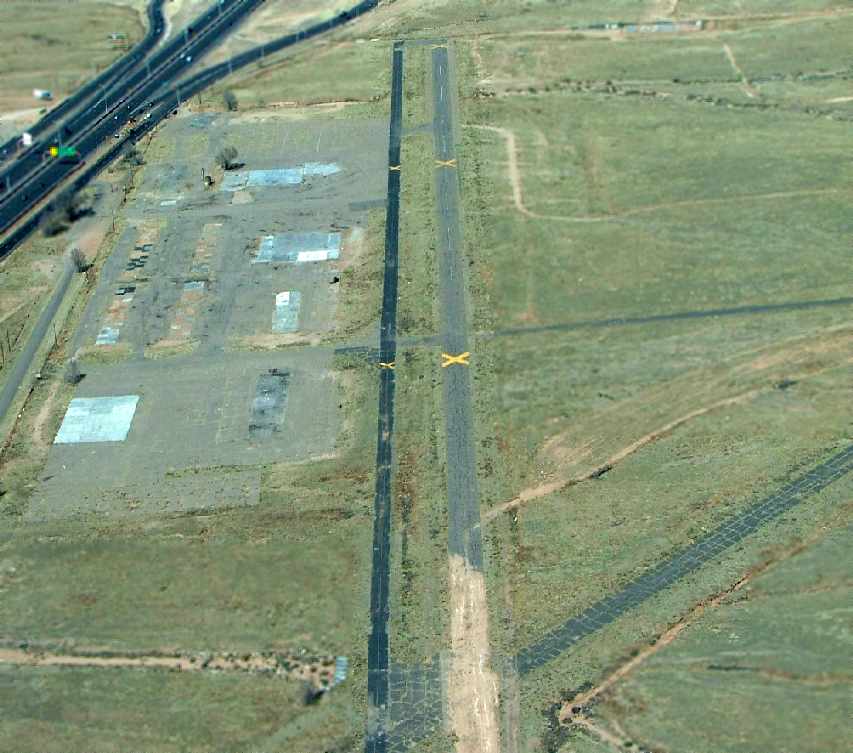
A March 2007 aerial view by Neal Lawson looking north at the remains of Coronado Airport,
showing the runways which remain, but all of the buildings & hangars having been wiped clean.

An 8/10/09 photo looking along the cracked former runway pavement at the site Coronado Airport,
with the casino which caused its demise seen in the left background.

An April 2015 photo looking east at the remains of Coronado Airport, with hangar foundations in the foreground.

An April 2015 photo looking southwest along the remains of Coronado Airport's Runway 21.
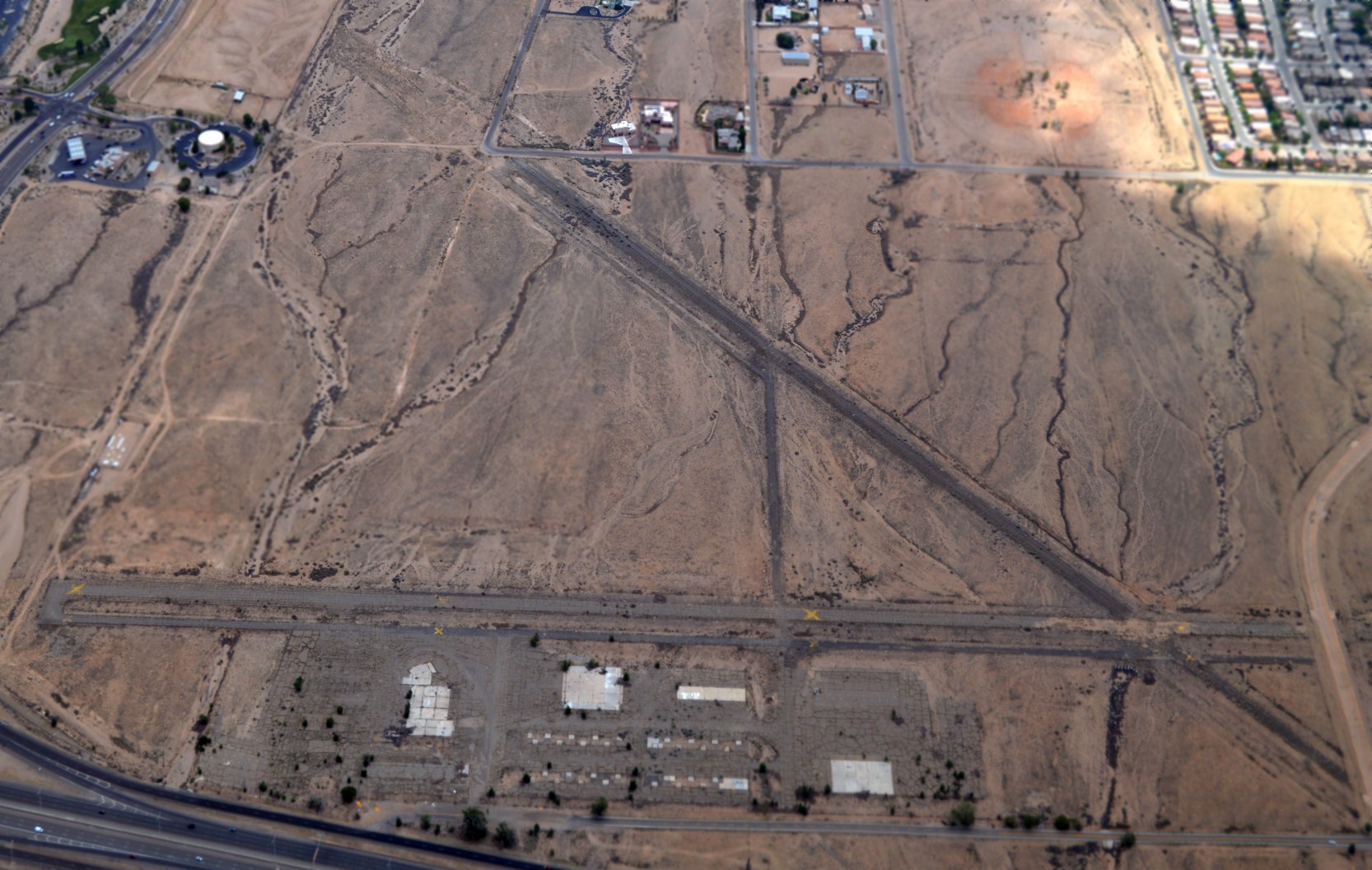
A 5/3/18 aerial view by Fred DeGuio looking east at the remains of Coronado Airport, showing the runways, taxiways, ramps, and hangar foundations.
What a crime for all this nice general aviation infrastructure to not see any productive use.

A 5/15/24 drone aerial view by Mike Legeros looking north at the remains of Coronado Airport, showing the runways, taxiways, ramps, and hangar foundations.

A 5/15/24 drone aerial view by Mike Legeros looking east at the remains of Coronado Airport, showing the runways, taxiways, ramps, and hangar foundations.
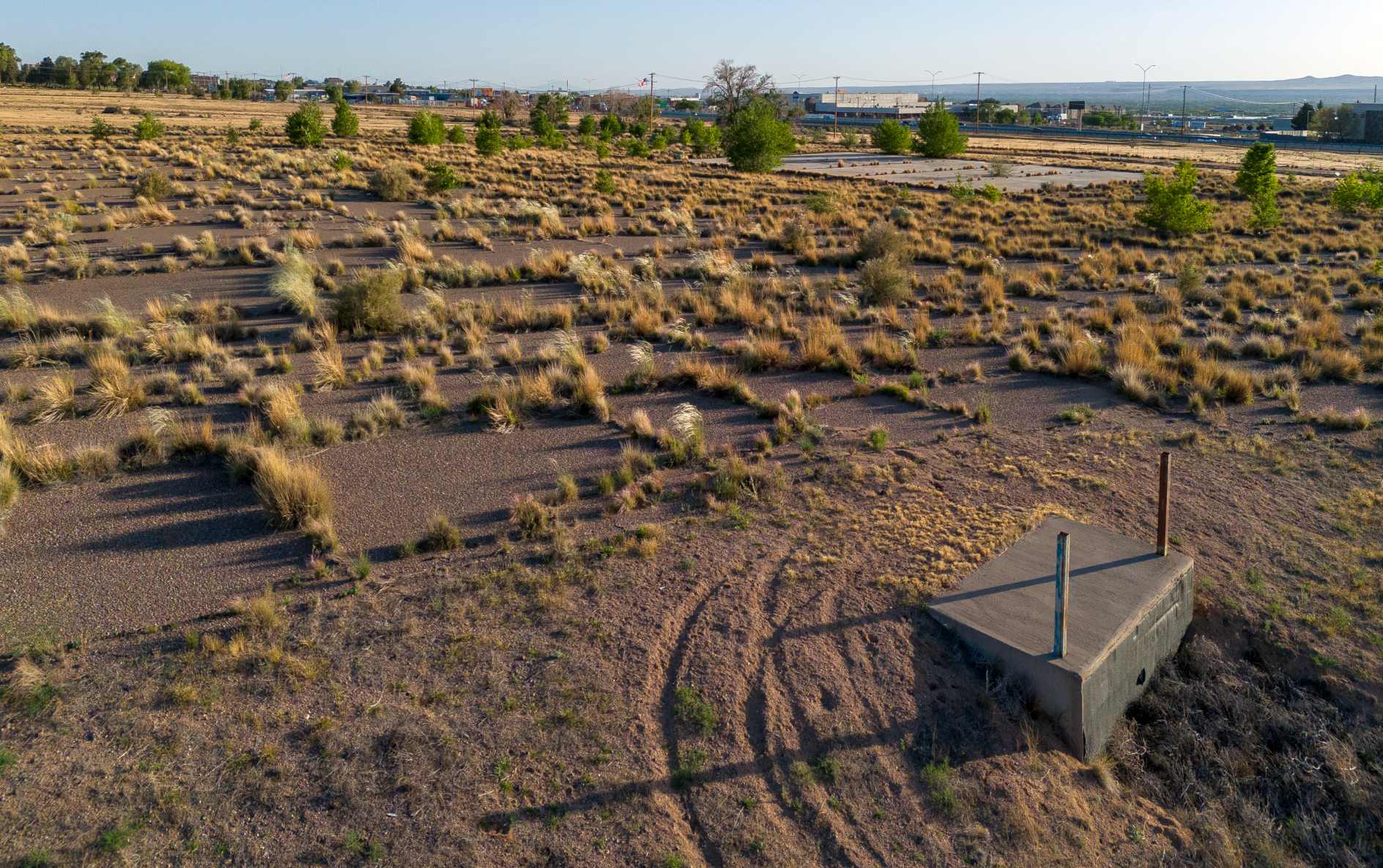
A 5/15/24 photo by Mike Legeros looking southwest at the remains of Coronado Airport ramps & hangar foundation.
Steve Schmidt recalled, “I moved away & was very sad to hear of the political end that befell Coronado.
With Albuquerque's wonderful climate, aviation just goes along with it.
Now, someone living on the east side of the community faces a 40 mile drive to the only general aviation airport in that large city.
That's really too bad.”
______________________________________________________
Seven Bar Airport / Alameda Airport (Q64), Albuquerque, NM
35.2, -106.66 (North of Albuquerque International Airport, NM)
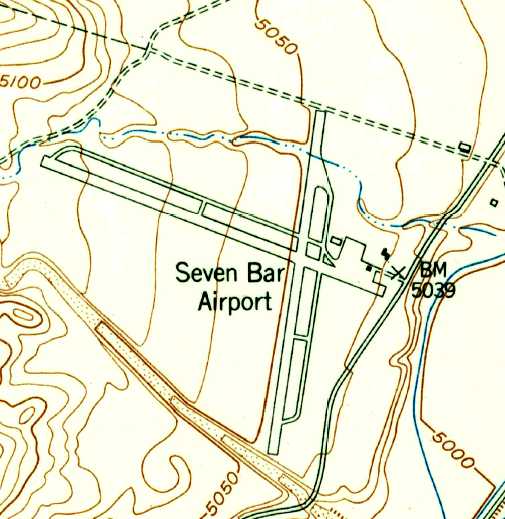
Seven Bar Airport, as depicted on the 1954 USGS topo map.
This general airport is one of several which have disappeared in the past few decades from the Albuquerque metropolitan area.
Seven Bar Airport was evidently established at some point between 1951-54,
as it was not yet listed in the 1945 AAF Airfield Directory (courtesy of Scott Murdock) nor depicted on the 1951 USGS topo map.
The earliest depiction of Seven Bar Airport which has been located was on the 1954 USGS topo map.
It depicted Seven Bar Airport as having 2 paved runways & parallel taxiways, and a ramp with a few small buildings on the east side.
It was evidently renamed Alameda Airport at some point between 1954-55,
as the 1955 Albuquerque Sectional Chart (according to Chris Kennedy)
depicted Alameda Airport as having 2 runways, with the longest being a 3,700' bare strip.

The earliest picture which has been located of Seven Bar Airport was a circa 1958-59 picture of James Powers with his mother & father in front of Aeronca 1250H.
Dan McGrew recalled, “In 1960 we moved to Paradise Hills.
The airport on that side of town was Alameda or 7-Bar as it was known. It was owned by Rolf Black.
The Black family owned a lot of land that is now Rio Ranch.
My Uncle Bob became a partner in aircraft sales with Rolf & then worked at 7-Bar.
Later when Bob went his separate way, he still kept his planes at 7-Bar.
Our 150 was tied down there as well as my mom & step dad's 172.”

A circa 1960-61 aerial view looking south at Seven Bar Airport (from the the Corrales Historical Society, courtesy of Matt Franklin).
It depicted Seven Bar as having 2 unpaved runways, with 7 light single-engine aircraft parked near some small hangars on the north side.
By the time of the 1962 AOPA Airport Directory, both runways at Alameda had been paved, with Runway 18/36 being the longest at 4,250' long.
The operator was listed as Rolfe Black.

Alameda Airport, as depicted on the December 1962 USAF Operational Navigation Chart (courtesy of Chris Kennedy).
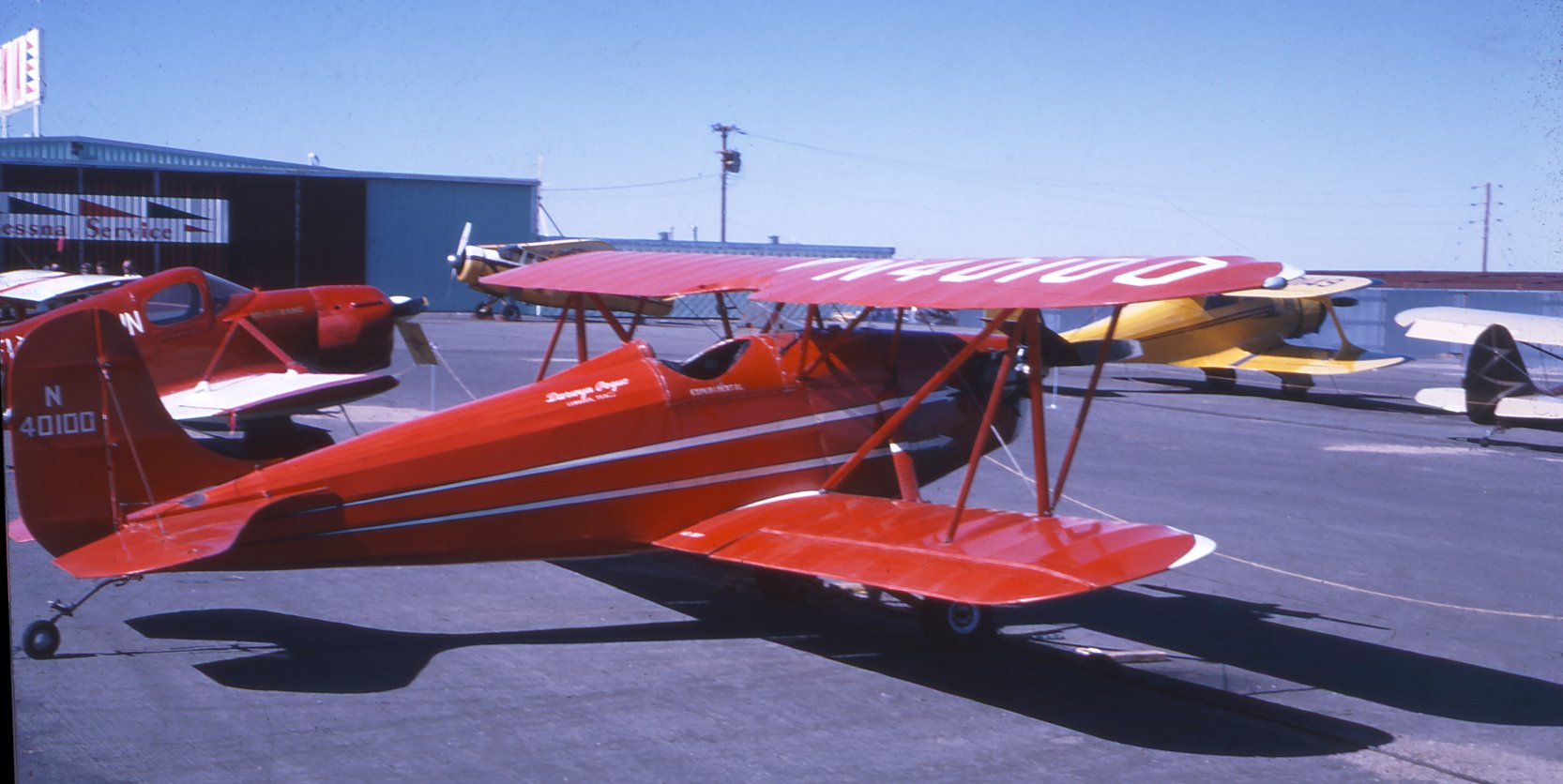
A 1964 photo of Black Hawk Parrakeet N40100 at Coronado Airport (courtesy of Dan Rhinehart).

The 1965 Albuquerque Sectional Chart (courtesy of John Price) depicted Alameda Airport as having a 4,200' paved runway.
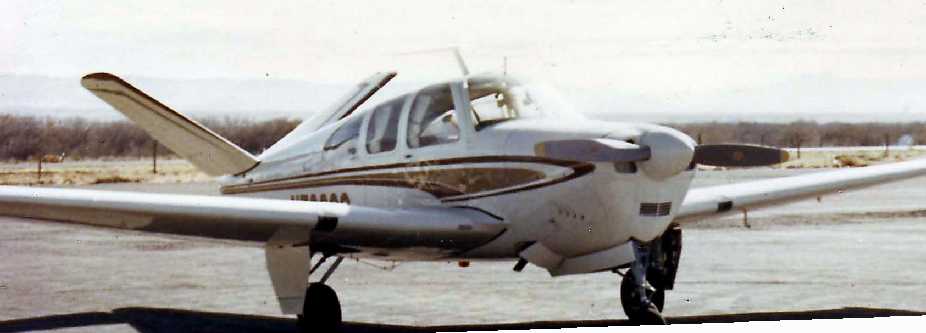
A 1967 photo by John Kern of his 1953 Bonanza at Alameda.
John Kern recalled, “I soloed at Alameda. I owned a 1953 C-model Bonanza & we kept it hangared at Alameda.
I flew the Southwest in business with the Bonanza.
My instructor''s name was Bill Harris as I recall & the FAA check pilot that gave me the flight test was named Don Holt.”

An October 1971 aerial photo from the 1971 NM Airport System Plan (courtesy of William Fitzpatrick) depicted Alemda Airport as having 2 paved runways & a large number of based aircraft.
Also note the plans for a large number of future T-hangars on the northeast side.
Dan McGrew recalled, “In the 1970s APS built another high school, Cibola, just to the northwest of Runways 10 & 17.
This caused for some interesting landings & takeoffs on 17.
The winds from the west would now burble across the field & if you weren't ready... watch out.”
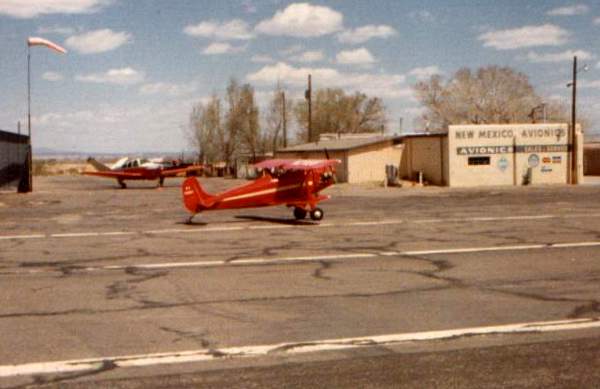
A 1974 photo of Doug Rhinehart in his 1936 Rose Parrakeet in front of Alameda Airport's New Mexico Avionics (courtesy of Dan Rhinehart).
The Parrakeet was one of the few single-seat civilian airplanes manufactured in the United States (not a homebuilt).
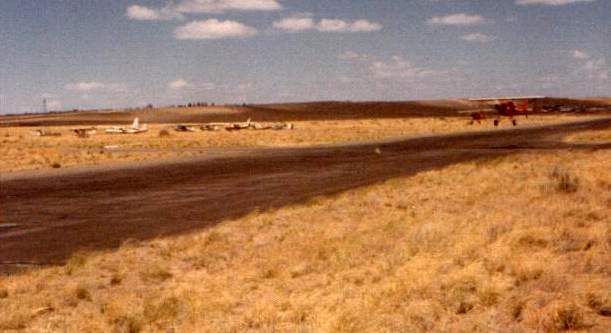
A 1974 photo of Doug Rhinehart touching down at Alameda Airport in his 1936 Rose Parrakeet (courtesy of Dan Rhinehart).

A 1974 picture by Dan Rhinehart of a lineup of Beech Staggerwings at an airshow at Alameda Airport.
The main hangar of Seven Bar Flying Service is visible on the left.
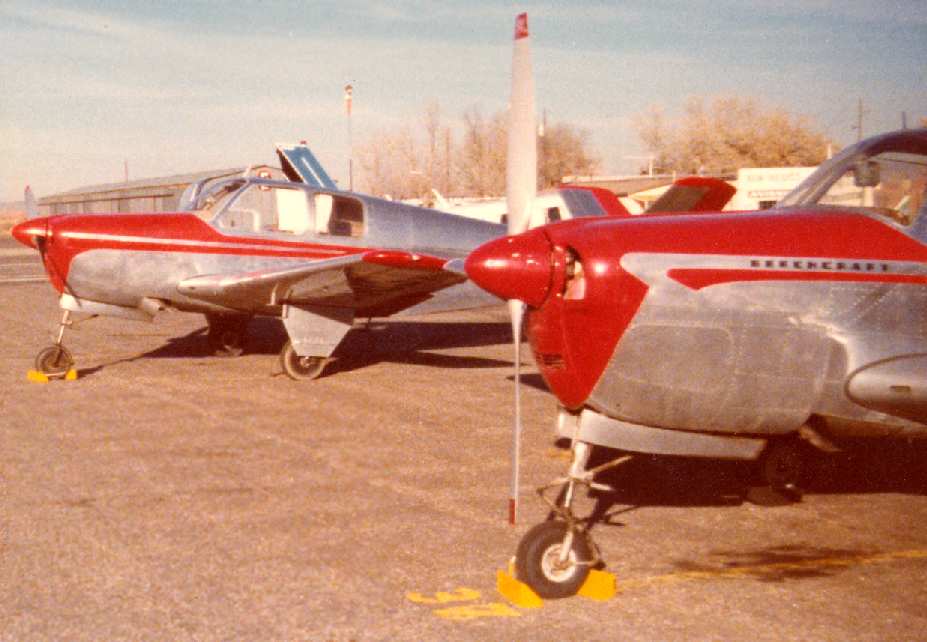
A mid 1970s portrait by Dan Rhinehart of his father's Bonanza (on the left) at Alameda Airport.

The October 1975 Albuquerque Sectional Chart depicted Alameda Airport as having 2 paved runways, with the longest being 6,100'.
Mark McManaman recalled, “My father, Bill McManaman, was a co-owner a 1960 Piper Comanche (N6781P) that was based at Alameda for a long time.
I soloed a PA-28-140 (Seven Bar flight school) on my 16th birthday in May of 1976.
Richard Massagee was my instructor, then I obtained my instrument ticket by working with Don Holt.
I ended up working for Seven Bar Flying service between 1979-82 (field maintenance, lineman, etc.).”
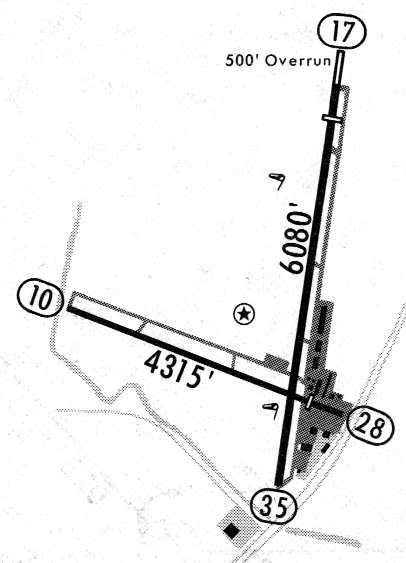
By 1978, Alameda Airport's diagram (courtesy of Steve Cruse) indicated that Runway 17/35
had reached what would be its ultimate length of 6,080' (with a 500' overrun).
Both runways had parallel taxiways, and a large paved ramp along the eastern side of the field had a large number of hangars & buildings.
Dan Rhinehart recalled, "The last time I was at Alameda airport was in 1978, and it was in open land on the outskirts of the city."
The last of several airshows / fly-ins at Alameda Airport was the Walt Hall / Doug Rhinehart Memorial Fly-In,
held in 1979 by the New Mexico Antique Airplane Association.
It was marred by the death of Paul Muench, a local airshow pilot who flew a gorgeous green, white & yellow Steen Skybolt.
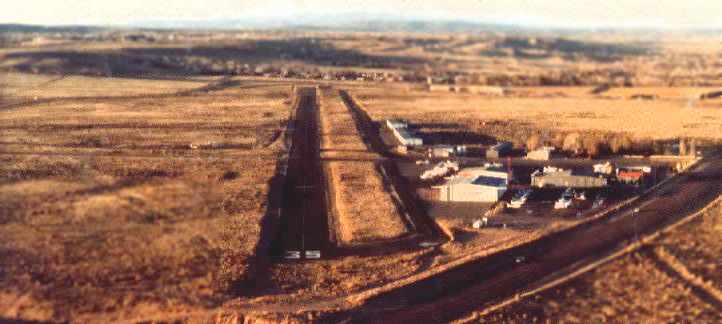
An April 1981 aerial view looking north at Alameda Airport by Robert Morris, taken while on approach to Runway 35.
By 1982, the AOPA Airport Directory (courtesy of Ed Drury) listed Alameda's 2 runways
as asphalt 6,080' Runway 17/35 & asphalt 4,315' Runway 10/28,
and listed the operator as Seven Bar Flying Service.
According to Dan Rhinehart, Seven Bar Aviation later moved its operation to Albuquerque International Airport,
where they continue to operate an FBO.
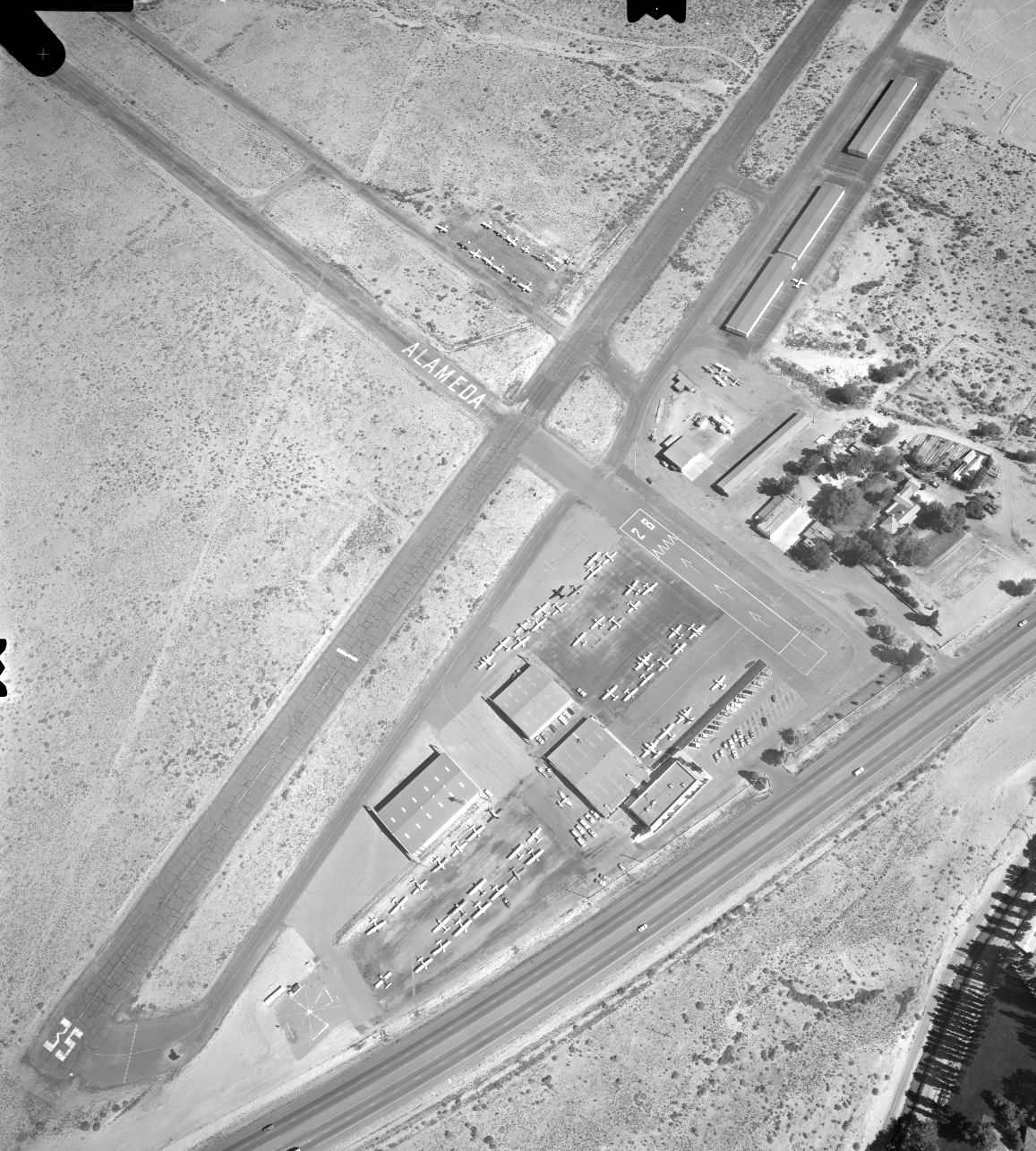
The last photo which has been located showing Alameda Airport still open was a 1984 aerial view looking northwest (courtesy of Shawn Penman).
It showed Alameda perhaps at the zenith of its popularity, with over 73 aircraft visible on its ramps.
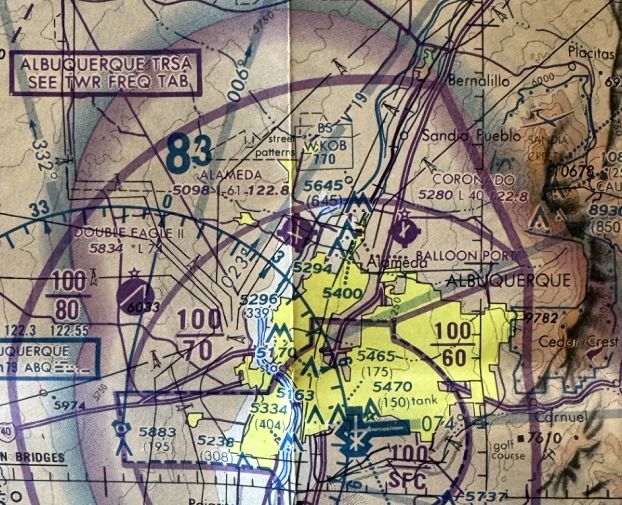
The last aeronautical chart depiction which has been located of Alameda Airport was on the November 1985 Albuquerque Sectional Chart (courtesy of Jonathan Westerling).
It depicted Alameda Airport as having 2 paved runways, with the longest being 6,100'.

The last depiction which has been located showing Alameda Airport still open was its diagram from the 1987 FAA 5010 file (courtesy of William Fitzpatrick).
According to Dan Rhinehart, "Alameda airport closed in the early 1980s
and the property was leased not sold (according to Seven Bar employees) for the development of the Cottonwood Mall.
This explains why the perimeter road around the mall is named 'Seven Bar Loop'
and the entrance to the mall (the original airport entrance) is called Old Airport Road."
Dan McGrew recalled, “The last time I flew out of 7-Bar was in a hot air balloon in 1989.”
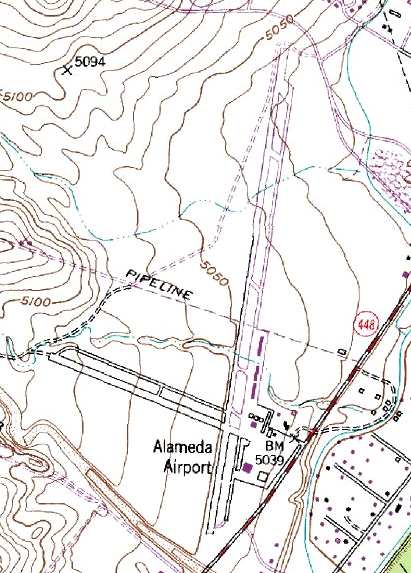
Curiously, the 1996 USGS topo map still depicted the entire Alameda Airport,
even though the 1996 USGS aerial photo below clearly showed that the majority of the airport had already been covered by new construction.
As depicted on the map, in addition to the 2 runways, the airfield had taxiways, a ramp, and several hangars.

In the 1996 USGS aerial photo,
a 2,400' portion of Runway 18/36 & its parallel taxiway are still perceptible, just north of the mall,
as well as a shorter section of the crosswind runway, just west of the mall.
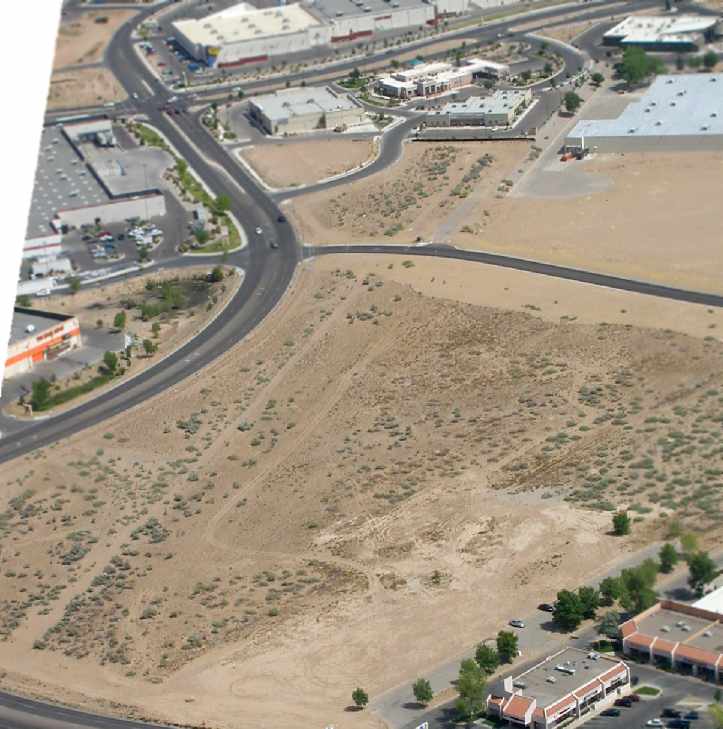
A 2003 aerial view by Dan Rhinehart of the traces of the former runway of Alameda Airport.
Dan Rhinehart reported in 2003, "I took some aerial photographs of the Cottonwood Mall / Alameda Airport
and I really couldn't tell you for sure but if you compare the [overhead] photograph to my pictures
you can see a couple of lines that seem to indicate where part of the runway was
and a small piece of faded asphalt that appears not to match the rest of the pavement
in the area that might be part of the taxiway?
But that's about it: a big mall & a couple street names that remind those of us that remember
that under all of this urban sprawl lies the ghost of Alameda airport."
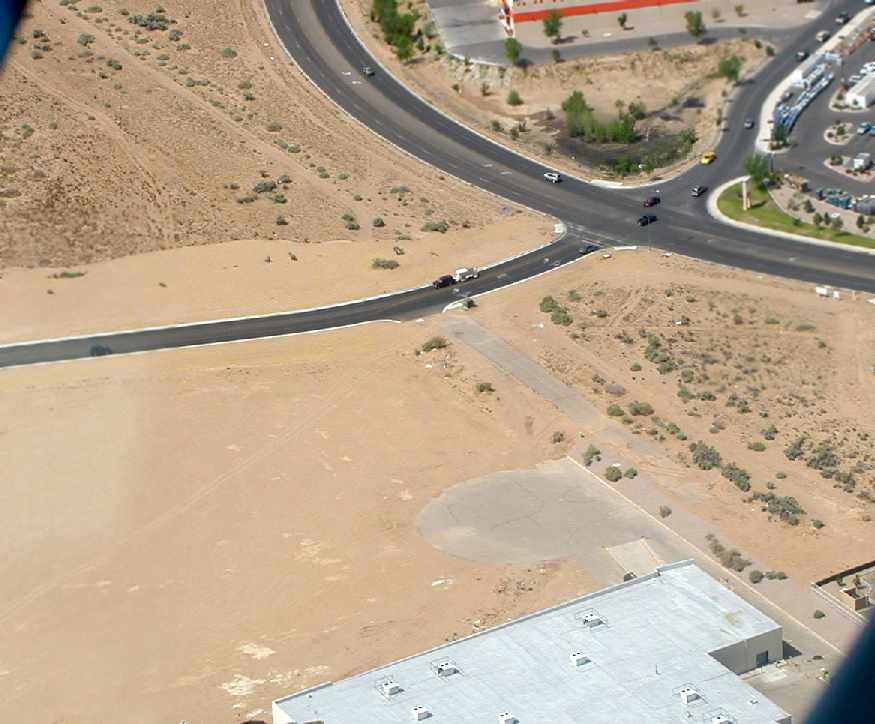
A 2003 aerial closeup of the remaining piece of runway pavement from Alameda Airport, by Dan Rhinehart.
"If you look closely you can see a small piece of taxiway in this picture. This is the north end of the runway.
You will notice a warehouse in the picture that has a road running east/west just south of the warehouse.
Running parallel to the west side of the building you will see a piece of very faded blacktop that doesn't seem to match anything around it.
There is what looks like a turn in area in the new blacktop onto this piece of old blacktop,
but if you look closely you will notice that this turn in area doesn't line up
with the last remaining piece of taxiway that went to Runway 17."
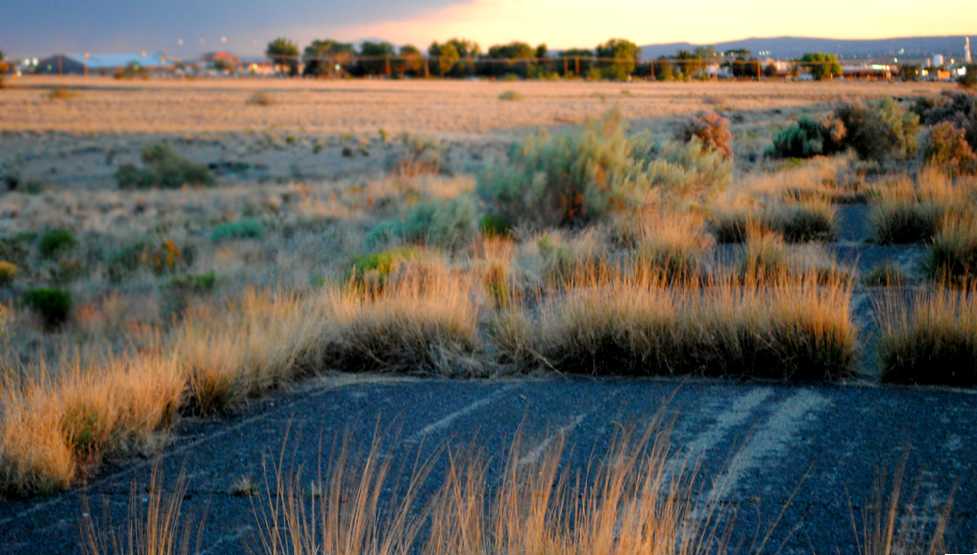
A 5/27/10 photo of the last remnant of this once-vibrant airport: a small section of Alameda Airport runway pavement.
Amazingly, as of 2014 a former Alameda hangar still marked “Seven Bar Aviation”
was photographed at the former Valencia Community Air Ranch where it had been relocated.
____________________________________________________
Or if you prefer to contact me directly concerning a contribution (for a mailing address to send a check),
please contact me at: paulandterryfreeman@gmail.com
If you enjoy this web site, please support it with a financial contribution.
____________________________________________________
This site covers airfields in all 50 states.